Sharp EL 9400 User Manual To The D576c46f F423 4138 A3da Bee867023e26
User Manual: Sharp EL-9400 to the manual
Open the PDF directly: View PDF ![]() .
.
Page Count: 60
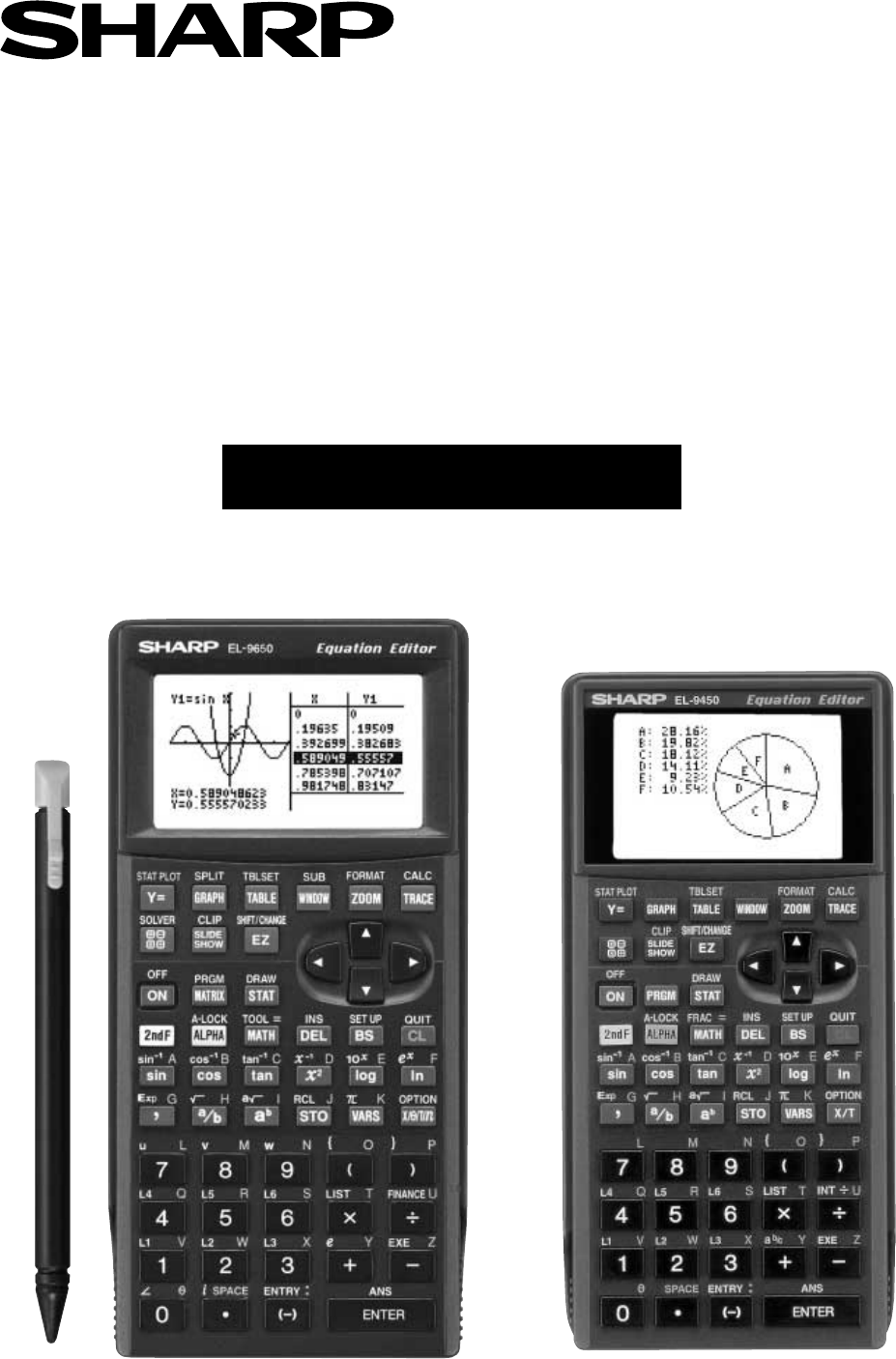
Graphing Calculator
EL-9650/9600c/9450/9400
Handbook Vol. 1
Algebra
EL-9650 EL-9450

1. Linear Equations
1-1
Slope and Intercept of Linear Equations
1-2
Parallel and Perpendicular Lines
2. Quadratic Equations
2-1
Slope and Intercept of Quadratic Equations
2-2
Shifting a Graph of Quadratic Equations
3. Literal Equations
3-1
Solving a Literal Equation Using the Equation Method (Amortization)
3-2
Solving a Literal Equation Using the Graphic Method (Volume of a Cylinder)
3-3
Solving a Literal Equation Using Newton’s Method (Area of a Trapezoid)
4. Polynomials
4-1
Graphing Polynomials and Tracing to Find the Roots
4-2
Graphing Polynomials and Jumping to Find the Roots
5. A System of Equations
5-1
Solving a System of Equations by Graphing or Tool Feature
6. Matrix Solutions
6-1
Entering and Multiplying Matrices
6-2
Solving a System of Linear Equations Using Matrices
7. Inequalities
7-1
Solving Inequalities
7-2
Solving Double Inequalities
7-3
System of Two-Variable Inequalities
7-4
Graphing Solution Region of Inequalities
8. Absolute Value Functions, Equations, Inequalities
8-1
Slope and Intercept of Absolute Value Functions
8-2
Shifting a graph of Absolute Value Functions
8-3
Solving Absolute Value Equations
8-4
Solving Absolute Value Inequalities
8-5
Evaluating Absolute Value Functions
9. Rational Functions
9-1
Graphing Rational Functions
9-2
Solving Rational Function Inequalities
10. Conic Sections
10-1
Graphing Parabolas
10-2
Graphing Circles
10-3
Graphing Ellipses
10-4
Graphing Hyperbolas
Contents
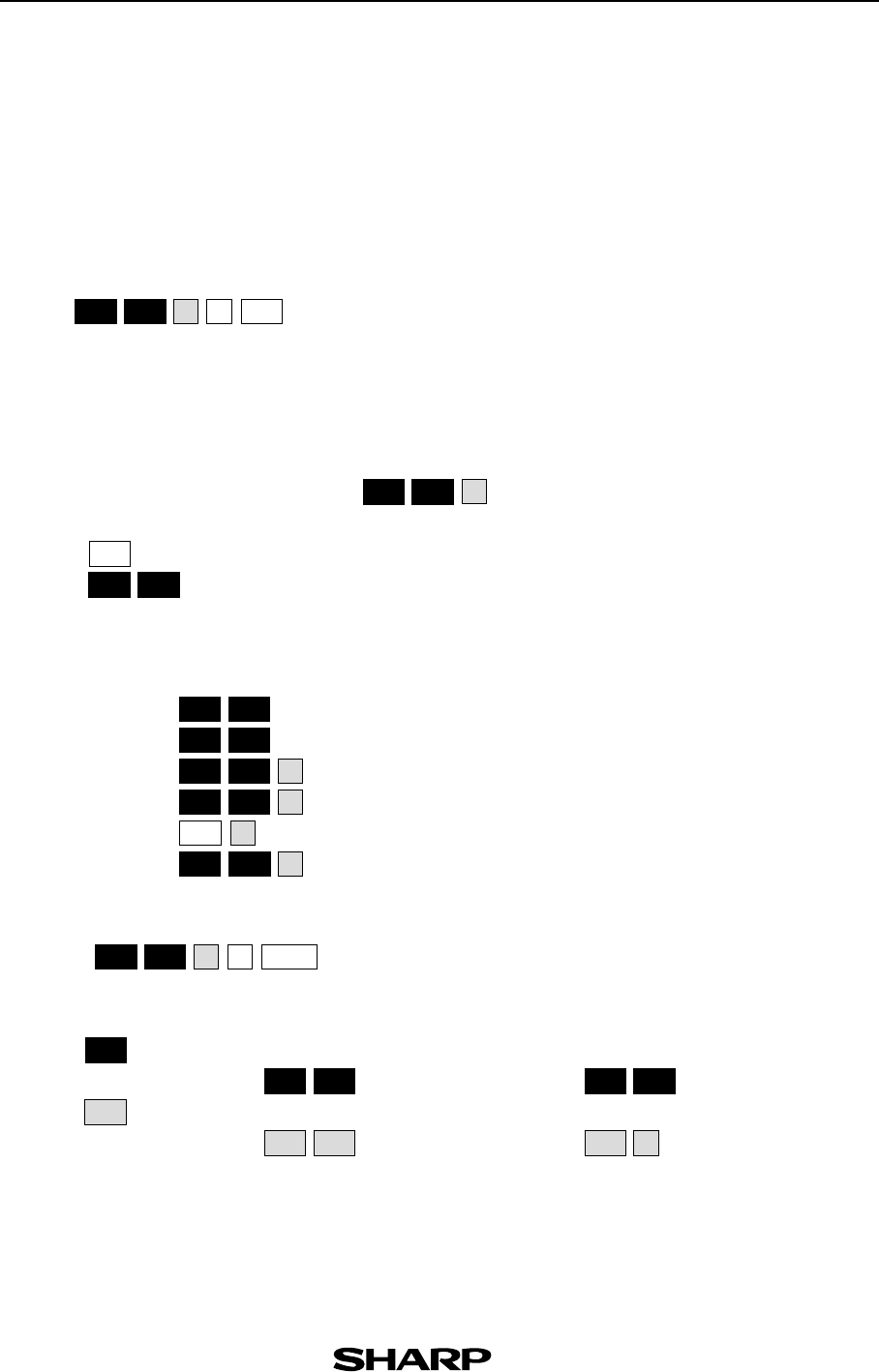
1. Always read “Before Starting”
The key operations of the set up condition are written in “Before Starting” in each section.
It is essential to follow the instructions in order to display the screens as they appear in the
handbook.
2. Set Up Condition
As key operations for this handbook are conducted from the initial condition, reset all memories to the
initial condition beforehand.
Note: Since all memories will be deleted, it is advised to use the CE-LK1P PC link kit (sold
separately) to back up any programmes not to be erased, or to return the settings to the initial
condition (cf. 3. Initial Settings below) and to erase the data of the function to be used.
•
To delete a single data, press
and select data to be deleted from the menu.
•
Other keys to delete data:
: to erase equations and remove error displays
: to cancel previous function
3. Initial settings
Initial settings are as follows:
✩
Set up ( ): Rad, FloatPt, 9, Rect, Decimal(Real), Equation
✩
Format ( ): RectCoord, OFF, OFF, Connect, Sequen
✩
Stat Plot ( ): 2. PlotOFF
✩ Shade ( ): 2. INITIAL
✩ Zoom ( ): 5. Default
✩ Period ( ): 1. PmtEnd
Note:
✩
returns to the default setting in the following operation.
( )
4. Using the keys
Press to use secondary functions (in yellow).
To select “sin
-1
”:
➔
Displayed as follows:
Press to use the alphabet keys (in blue).
To select A:
➔
Displayed as follows:
5. Notes
•
Some features are provided only on the EL-9650/9600c and not on the EL-9450/9400. (Substi-
tution, Solver, Matrix, Tool etc.)
•
As this handbook is only an example of how to use the EL-9650/9600c and 9450/9400,
please refer to the manual for further details.
Read this first
2nd F
OPTION
E2
C
2nd F
OPTION
2nd F
CL
CL
QUIT
2nd F
2nd F
2nd F
2nd F
2nd F
ZOOM
2nd F
SET UP
FORMAT
STAT PLOT
DRAW
FINANCE
2nd F
OPTION
2nd F
2nd F 2nd F
ENTER
E
G
A
C
E1
A
ALPHA
ALPHA ALPHA
sin sin
-1
sin
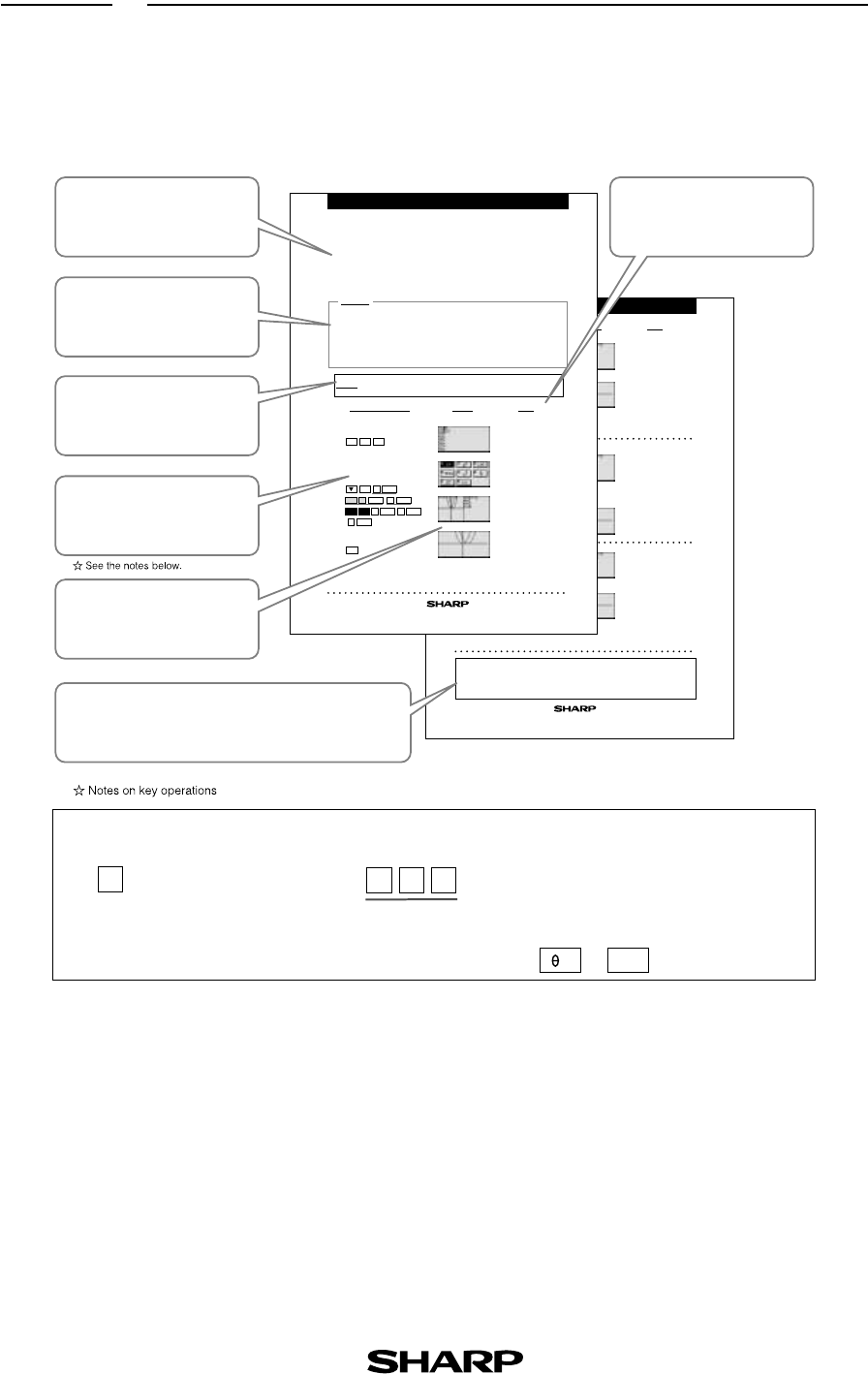
Notes
Step & Key Operation
*Use either pen touch or cursor to operate.
Display
EL-9650/9600c Graphing Calculator
2-1
2
-
2
View both graphs.
3
-
2
View both graphs. Notice that the multiplication of
2 pinches or closes the basic
y=x2 graph. This demonstrates
the fact that multiplying an a
(> 1) in the standard form
y = a
(x - h)
2
+ k
will pinch or close
the basic graph.
4
-
1
Change the equation in Y2 to
y = -2x2.
Notice that the multiplication of
-2 pinches or closes the basic
y =
x2 graph and flips it (reflects
it) across the x-axis. This dem-
onstrates the fact that multiply-
ing an a (<-1) in the standard form y = a (x - h) 2 + k
will pinch or close the basic graph and flip it (reflect
it) across the x-axis.
*
Change the equation in Y2 to y = x
2
+2.
2
-
1
*
3
-
1
Change the equation in Y2 to y = 2x
2
.
*
The EL-9650/9600c/9450/9400 allows various quadratic equations to be graphed
easily. Also the characteristics of quadratic equations can be visually shown
through the relationship between the changes of coefficient values and their
graphs, using the Substitution feature.
4
-
2
View both graphs.
2nd F
GRAPH
Y=
SUB
2
0
ENTER ENTER
GRAPH
Y=
2nd F SUB
2
0
ENTER
ENTER
GRAPH
Y=
2nd F SUB
(
-
)2
ENTER
Notice that the addition of 2 moves
the basic y =x
2
graph up two units
and the addition of -2 moves the
basic graph down two units on
the
y-axis.
This demonstrates the
fact that adding k (>0) within the standard form y = a (x -
h)
2
+ K will move the basic graph up K units and placing k
(<0) willmove the basic graph down K units on the y axis.
Using this Handbook
This handbook was produced for practical application of the SHARP EL-9650/9600c and
EL-9450/9400 Graphing Calculator based on exercise examples received from teachers
actively engaged in teaching. It can be used with minimal preparation in a variety of
situations such as classroom presentations, and also as a self-study reference book.
We would like to express our deepest gratitude to all the teachers whose cooperation we received in editing this
book. We aim to produce a handbook which is more replete and useful to everyone, so any comments or ideas
on exercises will be welcomed.
(Use the attached blank sheet to create and contribute your own mathematical problems.)
Thanks to Dr. David P. Lawrence at Southwestern Oklahoma State University for the use of his
teaching resource book (Applying Pre-Algebra/Algebra using the SHARP EL-9650/9600c Graphing
Calculator).
Other books available:
Graphing Calculator EL-9450/9400 TEACHERS’ GUIDE
•
When you see the sign
*
on the key:
*
means same series of key strokes can be done with screen touch on the EL-9650/9600c.
(
*
: for the corresponding key;
*
: for the corresponding keys underlined.)
Key operations may also be carried out with the cursor (not shown).
•
Different key appearance for the EL-9450/9400: for example
➔
X/ /T/
n
X/T
EL-9650/9600c Graphing Calculator
Slope and Intercept of Quadratic Equations
A quadratic equation of y in terms of x can be expressed by the standard form y = a (x -h)
2
+
k, where a is the coefficient of the second degree term ( y = ax
2
+ bx + c) and ( h, k) is the
vertex of the parabola formed by the quadratic equation. An equation where the largest
exponent on the independent variable x is 2 is considered a quadratic equation. In graphing
quadratic equations on the calculator, let the x- variable be represented by the horizontal
axis and let y be represented by the vertical axis. The graph can be adjusted by varying the
coefficients a, h, and k.
2-1
There may be differences in the results of calculations and graph plotting depending on the setting.
Return all settings to the default value and delete all data.
As the Substitution feature is only available on the EL-9650/9600c, this section does not apply to the EL-9450/9400.
Before
Starting
Graph various quadratic equations and check the relation between the graphs and
the values of coefficients of the equations.
Example
1.
Graph y = x
2
and y = (x-2)
2
.
2.
Graph y = x
2
and y = x
2
+2.
3.
Graph y = x
2
and y = 2x
2
.
4.
Graph y = x
2
and y = -2x
2
.
1
-
1Enter the equation y = x
2
for Y1.
Notes
Step & Key Operation
*Use either pen touch or cursor to operate.
Display
1
-
2Enter the equation y = (x-2)
2
for Y2
using Sub feature.
*
*
*
( )
Notice that the addition of -2
within the quadratic operation
moves the basic y =x
2
graph
right two units (adding 2 moves
it left two units) on the x-axis.
This shows that placing an h (>0) within the standard
form y = a (x - h)
2
+ k will move the basic graph right
h units and placing an h (<0) will move it left h units
on the x-axis.
View both graphs.
1
-
3
X
/
θ
/
T
/
n
ENTER
Y=
x
2
EZ 1
1
2
1
0
ENTER ENTER
ENTER
ENTER
GRAPH
ENTER
ALPHA
C
2nd F SUB
Merits of Using the EL-9650/9600c/9450/9400
Highlights the main functions of the calculator relevant
to the section
Introduction
Explanation of the section
Example
Example of a problem to be
solved in the section
Before Starting
Important notes to read
before operating the calculator
Step & Key Operation
A clear step-by-step guide
to solving the problems
Display
Illustrations of the calculator
screen for each step
Notes
Explains the process of each
step in the key operations
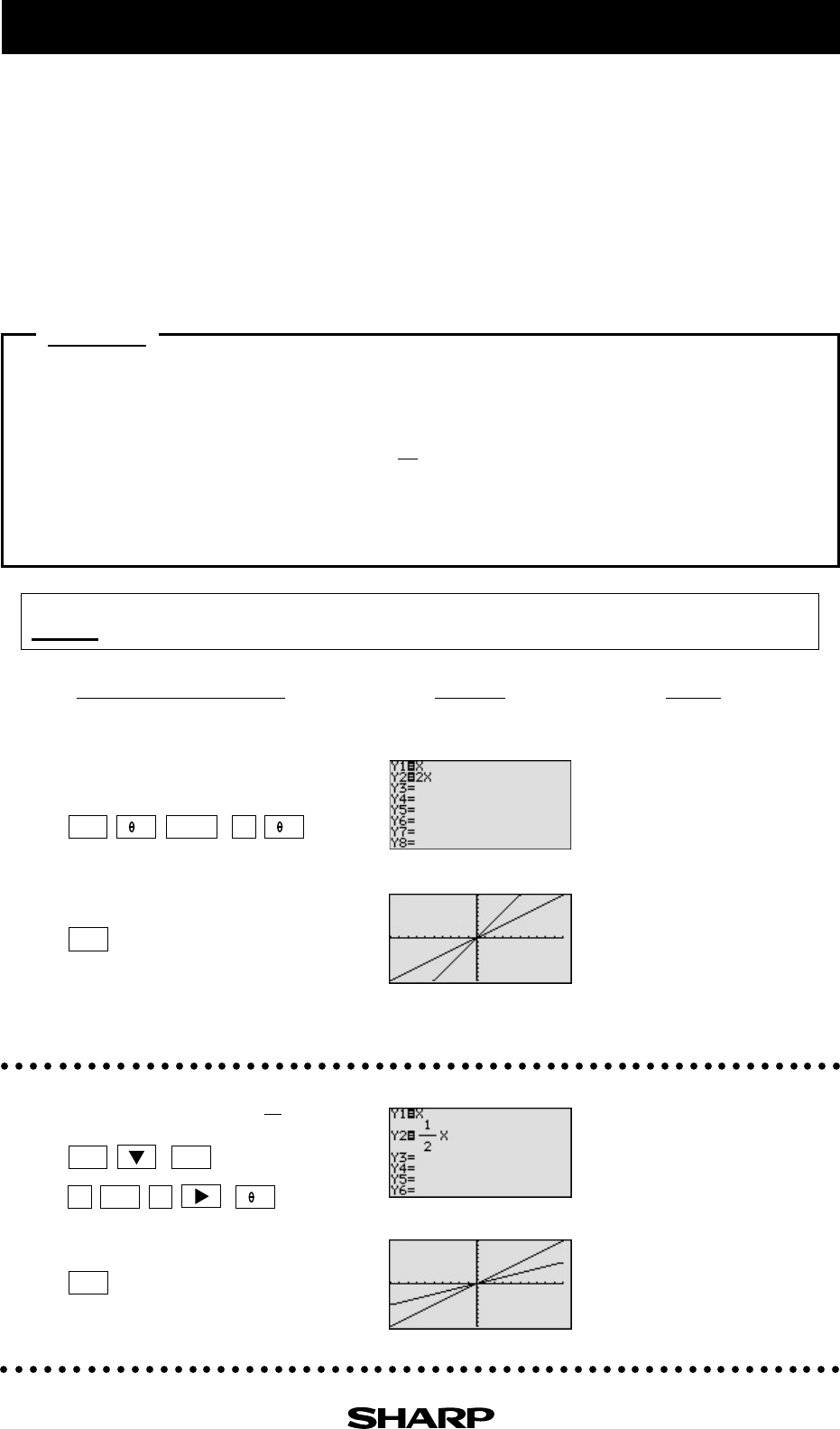
EL-9650/9600c/9450/9400 Graphing Calculator
NotesStep & Key Operation
(When using EL-9650/9600c)
*Use either pen touch or cursor to operate.
Display
(When using EL-9650/9600c)
Slope and Intercept of Linear Equations
A linear equation of y in terms of x can be expressed by the slope-intercept form y = mx+b,
where m is the slope and b is the y- intercept. We call this equation a linear equation since its
graph is a straight line. Equations where the exponents on the x and y are 1 (implied) are
considered linear equations. In graphing linear equations on the calculator, we will let the x
variable be represented by the horizontal axis and let y be represented by the vertical axis.
The equation Y1 = x is dis-
played first, followed by the
equation Y2 = 2x. Notice how
Y2 becomes steeper or climbs
faster. Increase the size of the
slope (m>1) to make the line
steeper.
1. Graph the equations y = x and y = 2x.
2. Graph the equations y = x and y = x.
3. Graph the equations y = x and y = - x.
4. Graph the equations y = x and y = x + 2.
Enter the equation y = x for Y1
and y = 2x for Y2.
View both graphs.
1-1
Draw graphs of two equations by changing the slope or the y- intercept.
1-2
Example
*
*
Enter the equation y = x for Y2.
View both graphs. Notice how Y2 becomes less
steep or climbs slower. De-
crease the size of the slope
(0<m<1) to make the line less
steep.
2-1
2-2
There may be differences in the results of calculations and graph plotting depending on the setting.
Return all settings to the default value and delete all data.
1-1
2
1
2
1
*
Y=
ENTER
2
Y= CL
1a/b 2
GRAPH
GRAPH
X/
/T/nX/
/T/n
X/
/T/n
Before
Starting
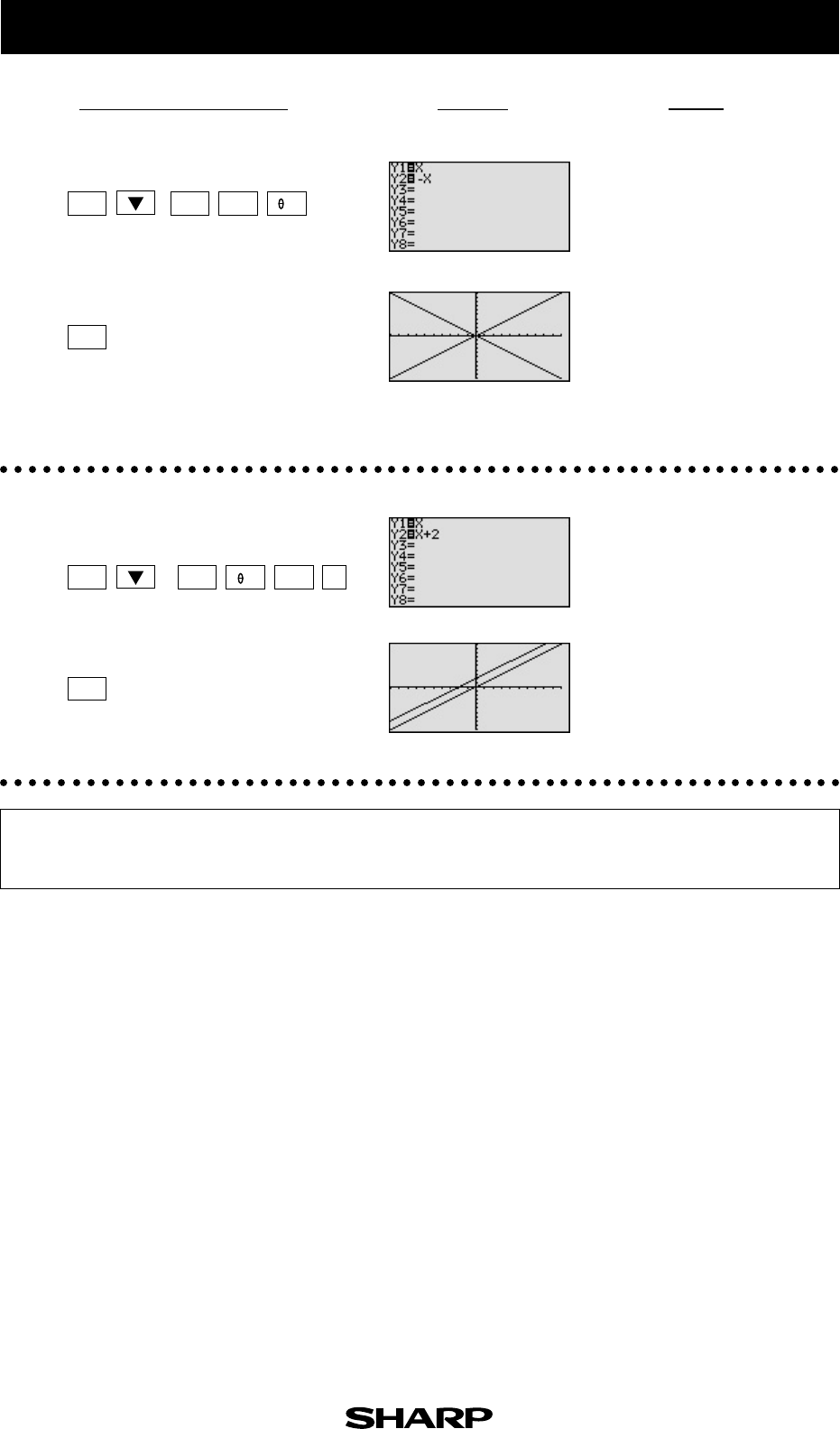
Step & Key Operation
(When using EL-9650/9600c)
*Use either pen touch or cursor to operate.
Display
(When using EL-9650/9600c)
EL-9650/9600c/9450/9400 Graphing Calculator
Notes
Enter the equation y = - x for Y2.
View both graphs. Notice how Y2 decreases
(going down from left to
right) instead of increasing
(going up from left to right).
Negative slopes (m<0) make
the line decrease or go
down from left to right.
Adding 2 will shift the y = x
graph upwards.
View both graphs.
Enter the equation y = x + 2 for
Y2.
3-1
3-2
4-1
4-2
*
*
Making a graph is easy, and quick comparison of several graphs will help
students understand the characteristics of linear equations.
1-1
CL (-)
GRAPH
GRAPH
Y=
Y= CL +2
X/
/T/n
X/
/T/n
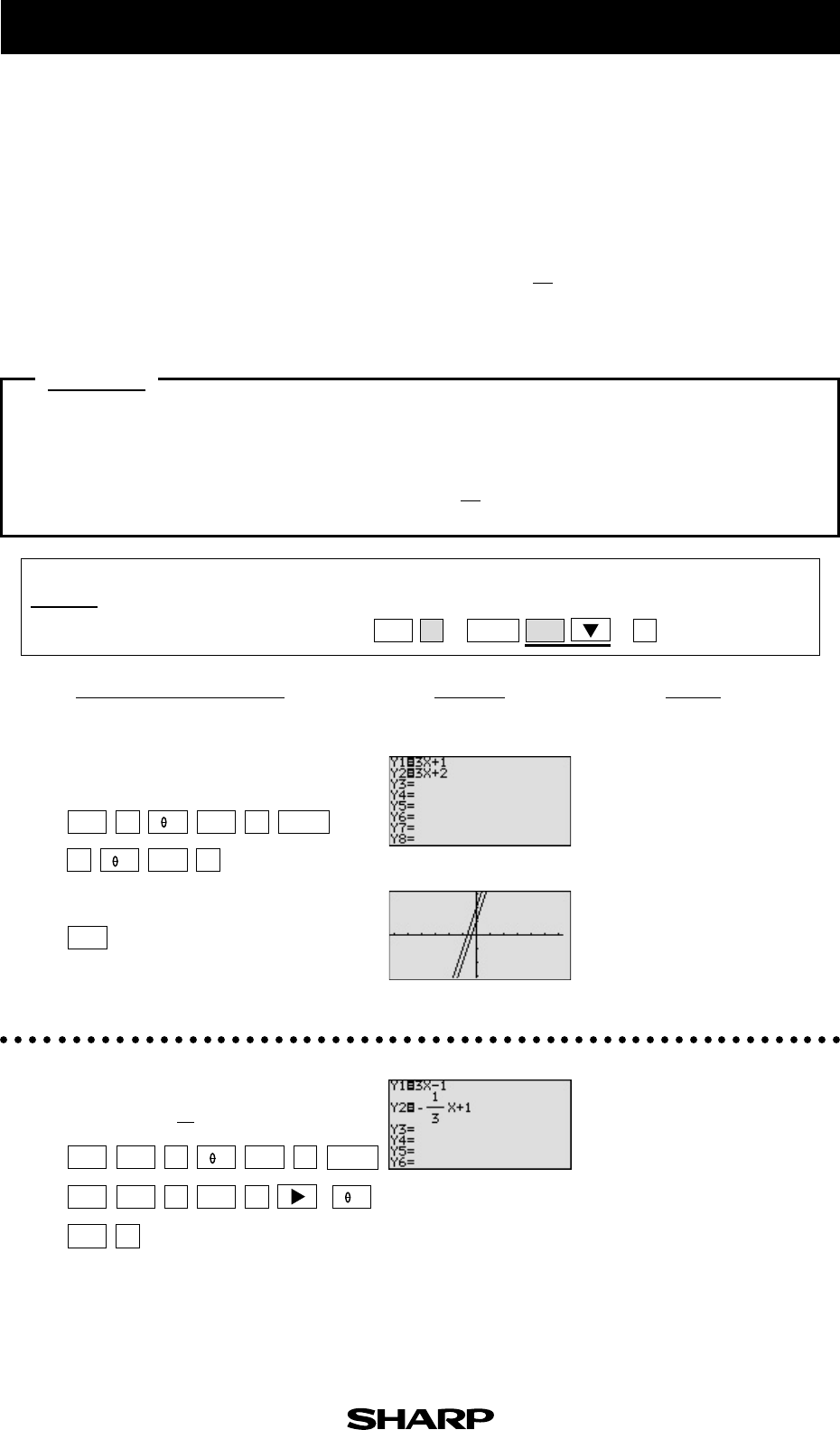
EL-9650/9600c/9450/9400 Graphing Calculator
Parallel and Perpendicular Lines
1-2
1. Graph the equations y = 3x + 1 and y = 3x + 2.
2. Graph the equations y = 3x - 1 and y = - x + 1.
Enter the equations y = 3x + 1 for
Y1 and y = 3x + 2 for Y2.
View the graphs.
1-1
Graph parallel lines and perpendicular lines.
1-2
Example
Enter the equations y = 3x - 1 for
Y1 and y = - x + 1 for Y2.
2-1
These lines have an equal
slope but different y-intercepts.
They are called parallel, and
will not intersect.
1
3
*
*
*
1
3
Parallel and perpendicular lines can be drawn by changing the slope of the linear equation
and the y intercept. A linear equation of y in terms of x can be expressed by the slope-
intercept form y = mx + b, where m is the slope and b is the y-intercept.
Parallel lines have an equal slope with different y-intercepts. Perpendicular lines have
slopes that are negative reciprocals of each other (m = - ). These characteristics can be
verified by graphing these lines.
NotesStep & Key Operation
(When using EL-9650/9600c)
*Use either pen touch or cursor to operate.
Display
(When using EL-9650/9600c)
1
m
Y= 3+1
ENTER
32
+
GRAPH
Y= CL 31
1
1
3
—
(-)
CL
ENTER
+
a/b
Before
Starting
There may be differences in the results of calculations and graph plotting depending on the setting.
Return all settings to the default value and delete all data.
Set the zoom to the decimal window: * ( * ) *
ZOOM
C
ENTER
ALPHA
7
X/
/T/n
X/
/T/n
X/
/T/n
X/
/T/n

Step & Key Operation
(When using EL-9650/9600c)
*Use either pen touch or cursor to operate.
Display
(When using EL-9650/9600c)
EL-9650/9600c/9450/9400 Graphing Calculator
Notes
1-2
View the graphs. These lines have slopes that
are negative reciprocals of
each other (m = - ). They are
called perpendicular. Note that
these intersecting lines form
four equal angles.
2-2
The Graphing Calculators can be used to draw parallel or perpendicular
lines while learning the slope or y-intercept of linear equations.
1
m
GRAPH

EL-9650/9600c Graphing Calculator
Slope and Intercept of Quadratic Equations
A quadratic equation of y in terms of x can be expressed by the standard form y = a (x - h)2+ k,
where a is the coefficient of the second degree term (y = ax2 + bx + c) and (h, k) is the
vertex of the parabola formed by the quadratic equation. An equation where the largest
exponent on the independent variable x is 2 is considered a quadratic equation. In graphing
quadratic equations on the calculator, let the x-variable be represented by the horizontal
axis and let y be represented by the vertical axis. The graph can be adjusted by varying the
coefficients a, h, and k.
2-1
There may be differences in the results of calculations and graph plotting depending on the setting.
Return all settings to the default value and delete all data.
Graph various quadratic equations and check the relation between the graphs and
the values of coefficients of the equations.
Example
1. Graph y = x2 and y = (x - 2)2.
2. Graph y = x2 and y = x2 + 2.
3. Graph y = x2 and y = 2x2.
4. Graph y = x2 and y = -2x2.
1-1Enter the equation y = x2 for Y1.
Notes
Step & Key Operation
*Use either pen touch or cursor to operate.
Display
1-2Enter the equation y = (x - 2)2 for
Y2 using Sub feature.
*
* *
( )
Notice that the addition of -2
within the quadratic operation
moves the basic y = x2 graph
right two units (adding 2 moves
it left two units) on the x-axis.
This shows that placing an h (>0) within the standard
form y = a (x - h)2 + k will move the basic graph right
h units and placing an h (<0) will move it left h units
on the x-axis.
View both graphs.
1-3
ENTER
Y= x2
EZ 1
1
2
1
0
ENTER ENTER
ENTER
ENTER
GRAPH
ENTER
ALPHA
C
2nd F SUB
X/
/T/n
Before
Starting
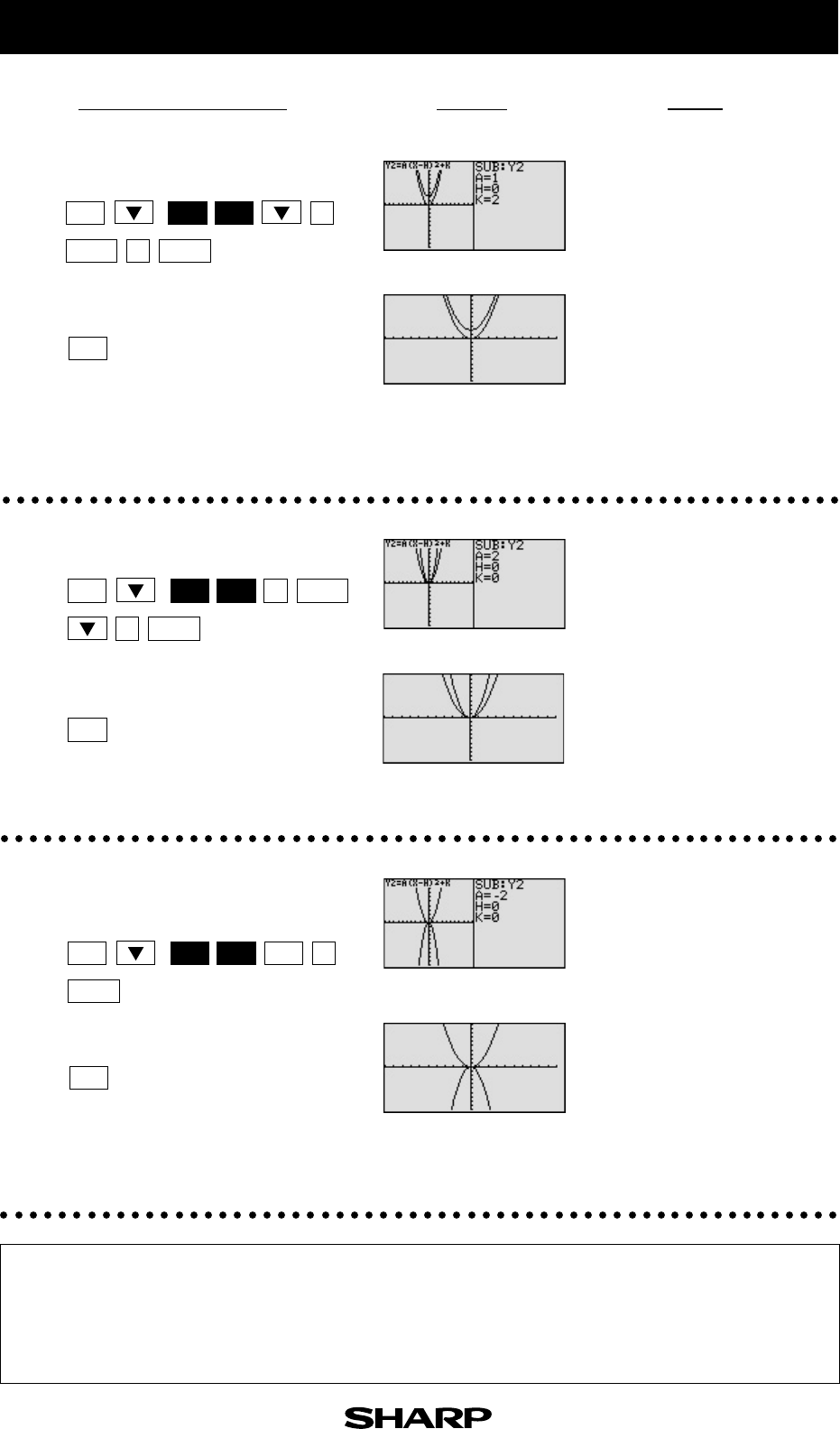
Step & Key Operation
*Use either pen touch or cursor to operate.
Display
EL-9650/9600c Graphing Calculator
Notes
2-1
2-2View both graphs.
Notice that the addition of 2 moves
the basic y =
x
2 graph up two units
and the addition of -2 moves the
basic graph down two units on
the y-axis. This demonstrates the
fact that adding k (>0) within the standard form y = a (x -
h)2 + k will move the basic graph up k units and placing k
(<0) will move the basic graph down k units on the y-axis.
3-2View both graphs. Notice that the multiplication of
2 pinches or closes the basic
y = x2 graph. This demonstrates
the fact that multiplying an a
(> 1) in the standard form
y = a
(x - h)2 + k
will pinch or close
the basic graph.
4-1Change the equation in Y2 to
y = -2x2.
Notice that the multiplication of
-2 pinches or closes the basic
y =
x2 graph and flips it (reflects
it) across the x-axis. This dem-
onstrates the fact that multiply-
ing an a (<-1) in the standard form y = a (x - h) 2 + k
will pinch or close the basic graph and flip it (reflect
it) across the x-axis.
*
Change the equation in Y2 to y =
x
2
+2.
2-1
*
3-1
Change the equation in Y2 to y = 2
x
2
.
*
The EL-9650/9600c allows various quadratic equations to be graphed easily.
Also the characteristics of quadratic equations can be visually shown through
the relationship between the changes of coefficient values and their graphs,
using the Substitution feature.
4-2View both graphs.
2nd F
GRAPH
Y=
SUB
2
0
ENTER ENTER
GRAPH
Y=
2nd F SUB
2
0
ENTER
ENTER
GRAPH
Y=
2nd F SUB
(-)2
ENTER
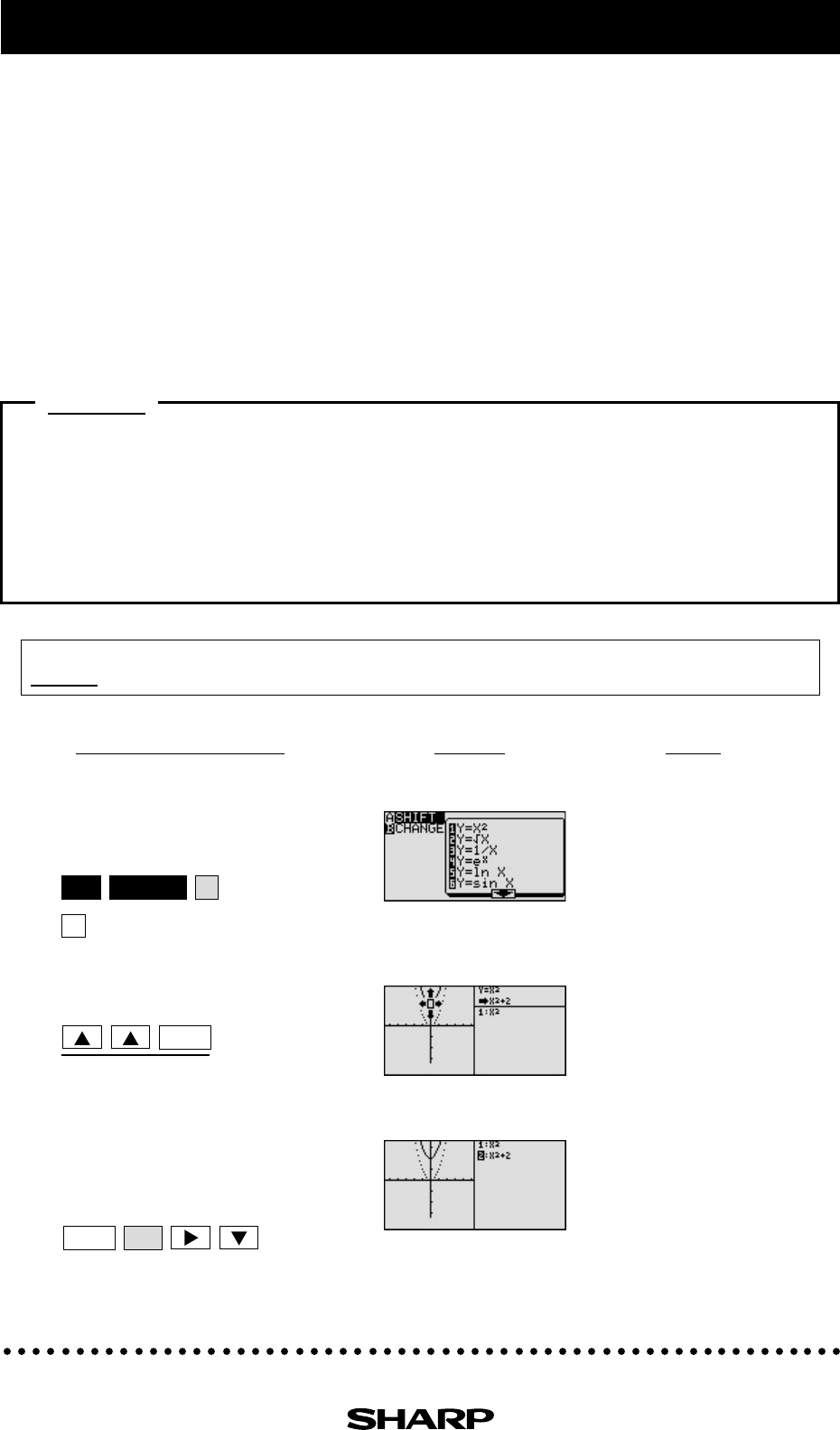
EL-9650/9600c/9450/9400 Graphing Calculator
2-2
There may be differences in the results of calculations and graph plotting depending on the setting.
Return all settings to the default value and delete all data.
NotesStep & Key Operation
(When using EL-9650/9600c)
*Use either pen touch or cursor to operate.
Display
(When using EL-9650/9600c)
Shifting a Graph of Quadratic Equations
A quadratic equation of y in terms of x can be expressed by the standard form y = a (x - h)
2
+ k,
where a is the coefficient of the second degree term (y = a
x
2
+ bx + c) and (h, k) is the vertex
of the parabola formed by the quadratic equation. An equation where the largest exponent
on the independent variable x is 2 is considered a quadratic equation. In graphing quadratic
equations on the calculator, let the x-variable be represented by the horizontal axis and let y
be represented by the vertical axis. The relation of an equation and its graph can be seen by
moving the graph and checking the coefficients of the equation.
Move or pinch a graph of quadratic equation y = x2 to verify the relation between
the coefficients of the equation and the graph.
Example
1. Shift the graph y = x2 upward by 2.
2. Shift the graph y = x2 to the right by 3.
3. Pinch the slope of the graph y = x2.
1-1Access Shift feature and select the
equation y = x2.
*
*
1-2Move the graph y = x2 upward by 2.
*
Save the new graph and observe the
changes in the graph and the
equation.
1-3Notice that upward movement
of the basic y = x2 graph by 2
units in the direction of the y-
axis means addition of 2 to the
y-intercept. This demonstrates
that upward movement of the graph by k units means
adding a k (>0) in the standard form y = a(x - h)2 + k.
1
2nd F
SHIFT/CHANGE
A
ENTER
ENTER
ALPHA
Before
Starting
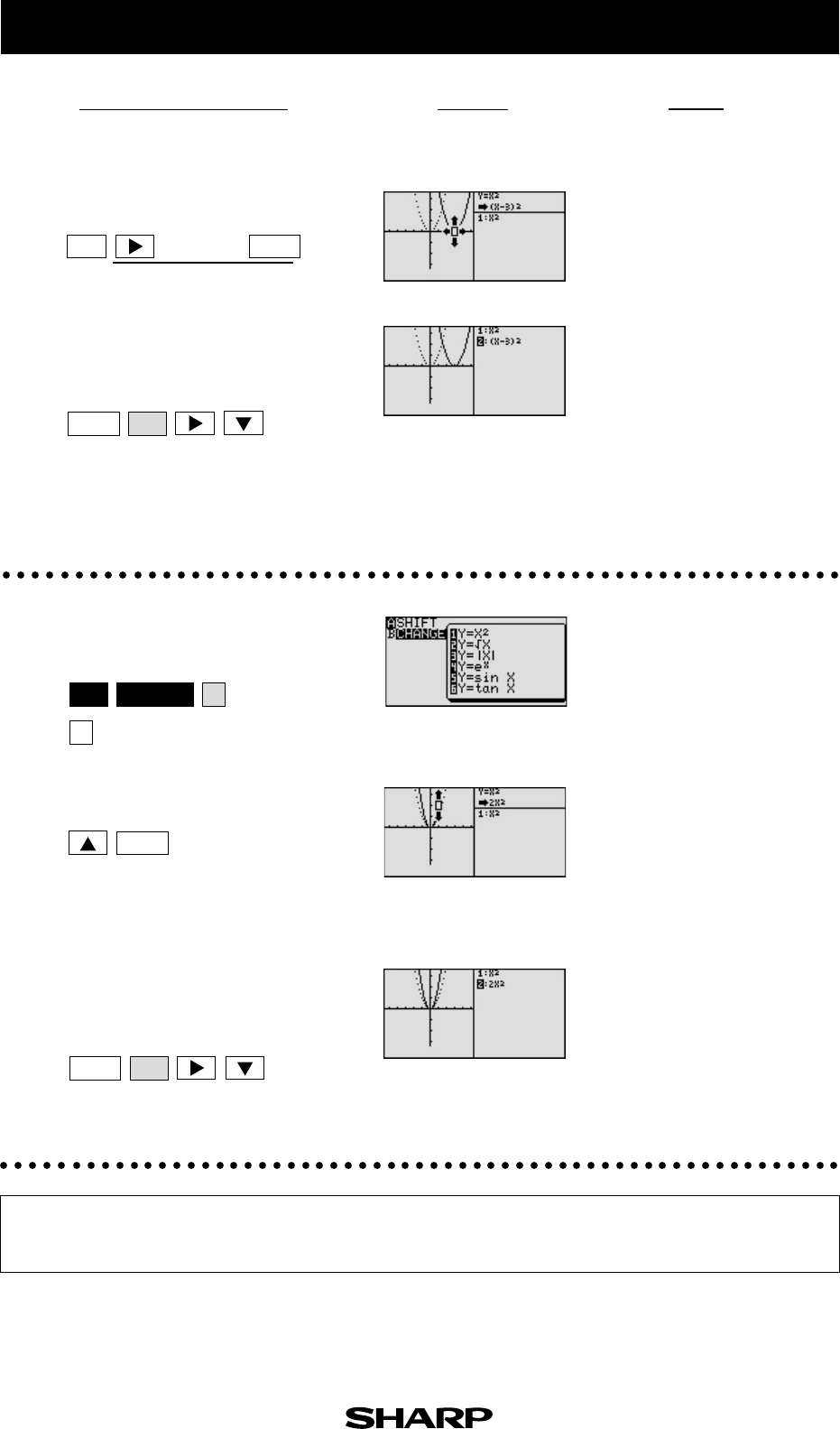
Step & Key Operation
(When using EL-9650/9600c)
*Use either pen touch or cursor to operate.
Display
(When using EL-9650/9600c)
EL-9650/9600c/9450/9400 Graphing Calculator
Notes
2-2
Move the graph y = x
2
to the right by 3.
2-1
(three times) *
3-3Save the new graph and observe
the changes in the graph and the
equation.
Notice that pinching or
closing the basic y = x2 graph
is equivalent to increasing an
a (>1) within the standard
form y = a (x - h)2 + k and
broadening the graph is
equivalent to decreasing an
a (<1).
The Shift/Change feature of the EL-9650/9600c/9450/9400 allows visual understanding
of how graph changes affect the form of quadratic equations.
2-2Save the new graph and observe
the changes in the graph and the
equation
Notice that movement of the
basic y = x2 graph to the right
by 3 units in the direction of
the x-axis is equivalent to the
addition of 3 to the x -intercept.
This demonstrates that movement of the graph to the
right means adding an h (>0) in the standard form
y = a (x - h)2 + k and movement to the left means
subtracting an h (<0).
3-1Access Change feature and select
the equation y = x2.
*
*
3-2Pinch the slope of the graph.
CL
ENTER
ENTER
ALPHA
2nd F
SHIFT/CHANGE
B
1
ENTER
ENTER
ALPHA
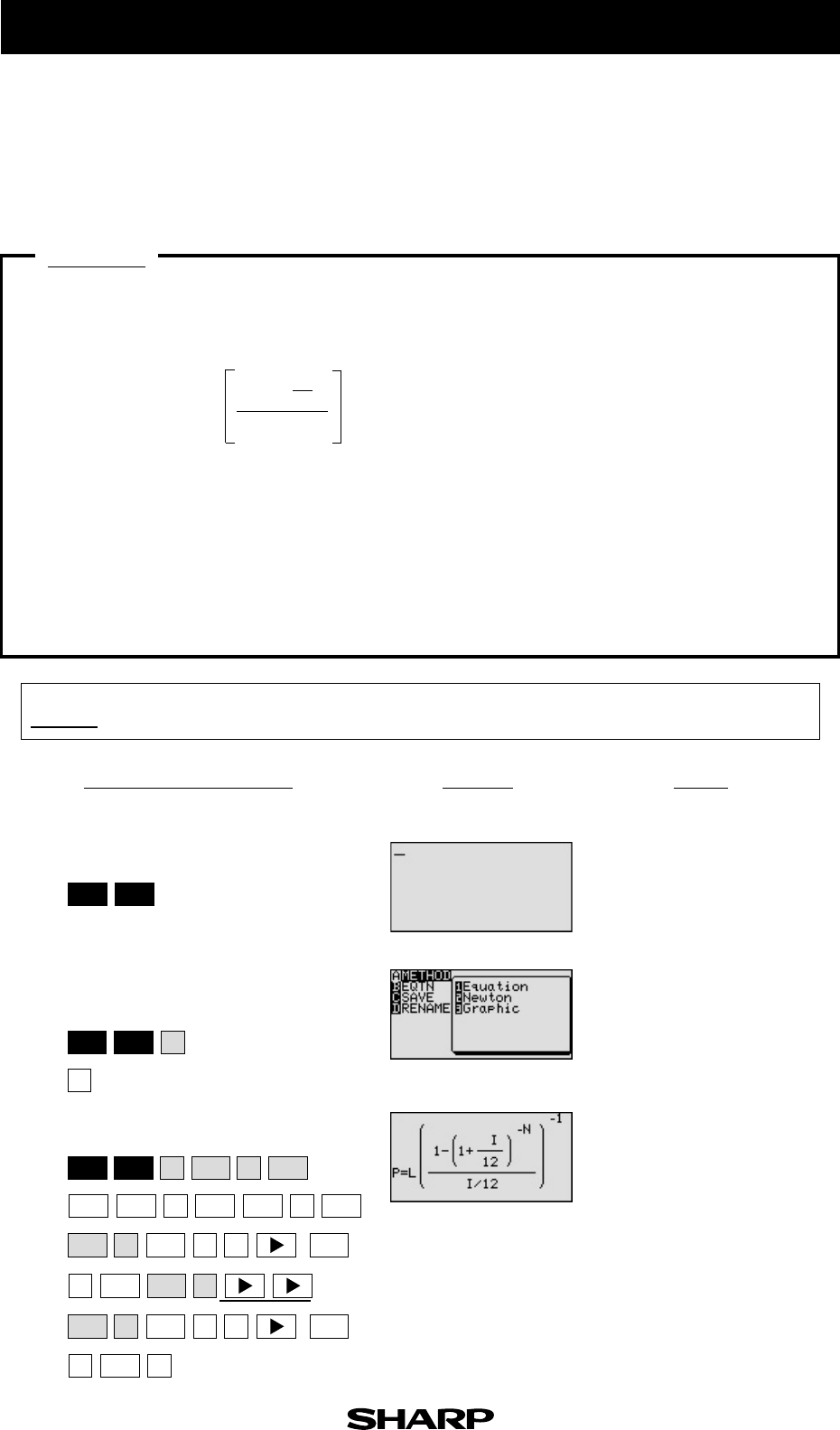
EL-9650/9600c Graphing Calculator
There may be differences in the results of calculations and graph plotting depending on the setting.
Return all settings to the default value and delete all data.
NotesStep & Key Operation
*Use either pen touch or cursor to operate.
Display
3-1
Solving a Literal Equation Using the Equation Method
(Amortization)
The Solver mode is used to solve one unknown variable by inputting known variables, by
three methods: Equation, Newton’s, and Graphic. The Equation method is used when an
exact solution can be found by simple substitution.
1. Find the monthly payment on a $15,000 car loan, made at 9% interest over four
years (48 months) using the Equation method.
2. Save the formula as “AMORT”.
3. Find amount of loan possible at 7% interest over 60 months with a $300
payment, using the saved formula.
Solve an amortization formula. The solution from various values for known variables
can be easily found by giving values to the known variables using the Equation
method in the Solver mode.
The formula : P = L
Example
1-3Enter the amortization formula.
Select the Equation method for
solving.
1-1
1-2
Access the Solver feature.
*
*
*
P= monthly payment
L= loan amount I= interest rate
N=number of months
*
*
This screen will appear a few
seconds after “SOLVER” is dis-
played.
1-(1+ )
I-N -1
I / 12
12
A
2nd F
SOLVER
2nd F
SOLVER
1
—
(-)
a/b +(1
1
1
12
ab
I12
1
(
)
)
ALPHA
ALPHA
N
ALPHA
a/b
÷
ab(-)
ALPHA
2nd F
SOLVER
PL
=
Before
Starting
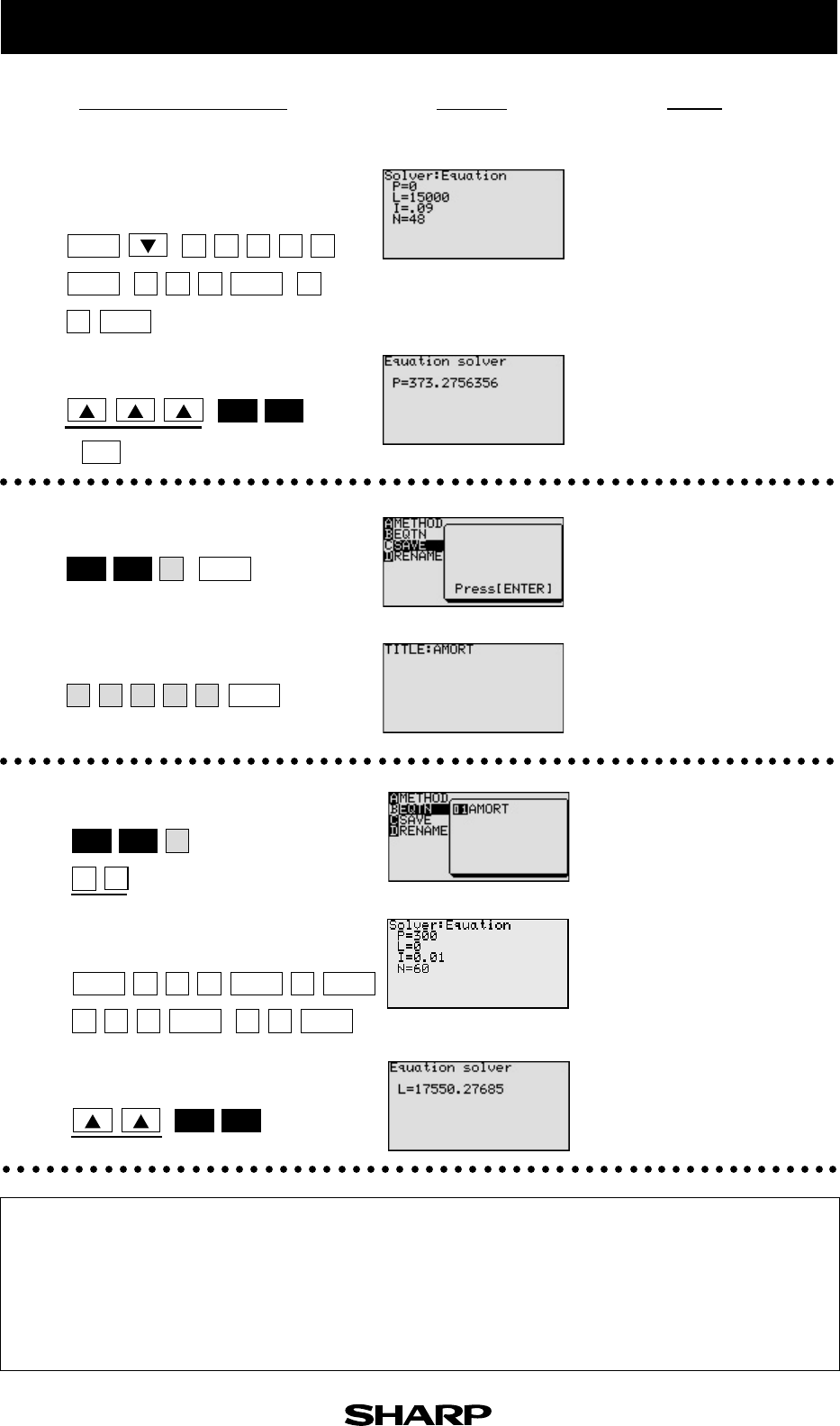
Step & Key Operation
*Use either pen touch or cursor to operate.
Display
EL-9650/9600c Graphing Calculator
Notes
3-1
Save this formula.
2-1
Give the formula the name AMORT.
2-2
The monthly payment (P) is
$373.28.
Solve for the payment(P).
1-5
*
( )
* *
Recall the amortization formula.
3-1
Enter the values: P = 300,
I = 0.01, N = 60
3-2
The amount of loan (L) is
$17550.28.
Solve for the loan (L).
3-3
*
*
*
*
*
With the Equation Editor, the EL-9650/9600c displays equations, even complicated
ones, as they appear in the textbook in easy to understand format. Also it is
easy to find the solution for unknown variables by recalling a stored equation
and giving values to the known variables in the Solver mode when using the
EL-9650/9600c.
1-4Enter the values L=15,000,
I=0.09, N=48.
*
* *
2nd F EXE
ENTER
ENTER ENTER
ENTER
ENTER
ENTER
ENTER ENTER ENTER
ENTERENTER
2nd F
2nd F
2nd F EXE
SOLVER
SOLVER
CL
15000
•09 4
8
C
AMORT
B
01
300
•01 61
0

EL-9650/9600c Graphing Calculator
There may be differences in the results of calculations and graph plotting depending on the setting.
Return all settings to the default value and delete all data.
NotesStep & Key Operation
*Use either pen touch or cursor to operate.
Display
3-2
The Solver mode is used to solve one unknown variable by inputting known variables.
There are three methods: Equation, Newton’s, and Graphic. The Equation method is used
when an exact solution can be found by simple substitution. Newton’s method implements
an iterative approach to find the solution once a starting point is given. When a starting
point is unavailable or multiple solutions are expected, use the Graphic method. This
method plots the left and right sides of the equation and then locates the intersection(s).
Solving a Literal Equation Using the Graphic Method
(Volume of a Cylinder)
1. Find the radius of a cylinder with a volume of 30in3 and a height of 10in, using
the Graphic method.
2. Save the formula as “V CYL”.
3. Find the radius of a cylinder with a volume of 200in3 and a height of 15in,
using the saved formula.
Use the Graphic method to find the radius of a cylinder giving the range of the unknown
variable.
The formula : V =
π
r2h ( V = volume r = radius h = height)
Example
1-1Access the Solver feature.
Select the Graphic method for
solving.
1-2
*
*
1-3Enter the formula V =
π
r2h.
1-4Enter the values: V = 30, H = 10.
Solve for the radius (R).
* *
*
This screen will appear a few
seconds after “SOLVER” is dis-
played.
2nd F
SOLVER
2nd F
SOLVER
2nd F
2nd F EXE
ENTER ENTER
ENTER
A
3
V
Rx2H
30 1
0
=ALPHA ALPHA ALPHA
ALPHA
π
Before
Starting
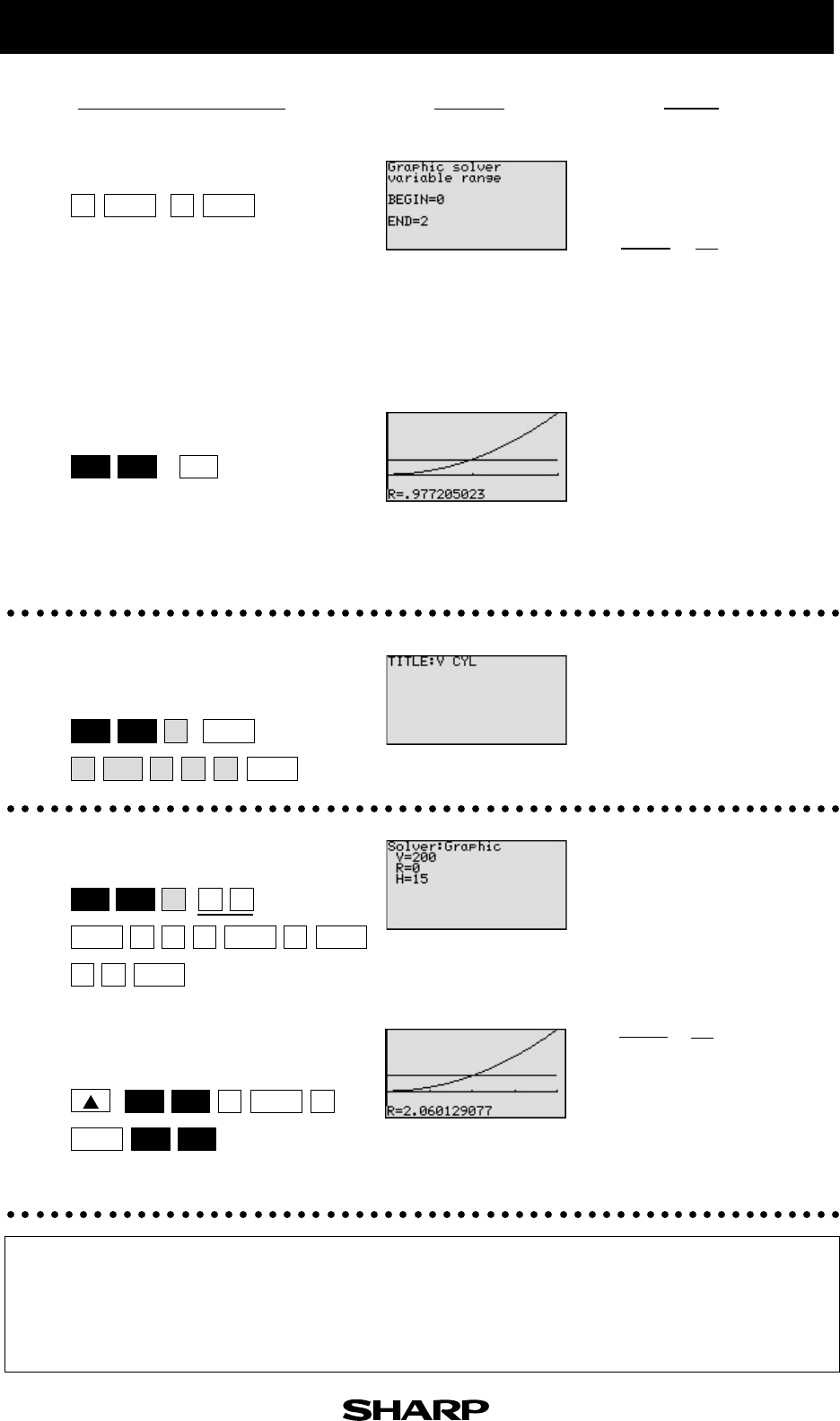
Step & Key Operation
*Use either pen touch or cursor to operate.
Display
EL-9650/9600c Graphing Calculator
Notes
The solver feature will graph
the left side of the equation
(volume, y = 30), then the right
side of the equation (y = 10r2),
and finally will calculate the
intersection of the two graphs
to find the solution.
The radius is 0.98 in.
The graphic solver will prompt
with a variable range for solv-
ing.
3-2
Set the variable range from 0 to 2.
1-5 *
1-6Solve.
( )
Save this formula.
Give the formula the name “V CYL”.
2
* *
3-1
*
One very useful feature of the calculator is its ability to store and recall equations.
The solution from various values for known variables can be easily obtained by
recalling an equation which has been stored and giving values to the known
variables. The Graphic method gives a visual solution by drawing a graph.
Use the larger of the values to
be safe.
r =1 ➞ r2 = 12 = 1 <3
r =2 ➞ r2 = 22 = 4 >3
Recall the formula.
Enter the values: V = 200, H = 15.
* *
Solve the radius setting the variable
range from 0 to 4.
Use 4, the larger of the values,
to be safe.
The answer is : r = 2.06
r = 3 ➞ r2 = 32 = 9 < 14
r = 4 ➞ r2 = 42 = 16 > 14
r2 = = < 14
3-2
ENTER
0
ENTER
2
2nd F EXE
CL
2nd F
SOLVER
ENTER
L
ENTER
C
C
VY
2nd F
SOLVER
B01
0020
ENTER ENTER ENTER
ENTER
15
2nd F EXE
SPACE
04
ENTER
ENTER 2nd F EXE
r2 = = <3
10
π
30
π
3
15
π
200
π
14

EL-9650/9600c Graphing Calculator
There may be differences in the results of calculations and graph plotting depending on the setting.
Return all settings to the default value and delete all data.
NotesStep & Key Operation
*Use either pen touch or cursor to operate.
Display
3-3
The Solver mode is used to solve one unknown variable by inputting known variables.
There are three methods: Equation, Newton’s, and Graphic. The Newton’s method can
be used for more complicated equations. This method implements an iterative approach
to find the solution once a starting point is given.
Solving a Literal Equation Using Newton's Method (Area of a Trapezoid)
1. Find the height of a trapezoid with an area of 25in2 and bases of length 5in
and 7in using Newton's method. (Set the starting point to 1.)
2. Save the formula as “A TRAP”.
3. Find the height of a trapezoid with an area of 50in2 with bases of 8in and 10in
using the saved formula. (Set the starting point to 1.)
Find the height of a trapezoid from the formula for calculating the area of a trapezoid
using Newton’s method.
The formula : A= h(b+c)
Example
1-1Access the Solver feature.
Select Newton's method
for solving.
1-2
*
*
1-3Enter the formula A = h(b+c).
*
1
2(A = area h = height b = top face c = bottom face)
1
2
*
* *
Enter the values:
A = 25,
B = 5,
C = 7
1-4
This screen will appear a few
seconds after “SOLVER” is dis-
played.
2nd F
SOLVER
2nd F
SOLVER
A
ALPHA
A
2
ALPHA
1
a/b
2
ALPHA
H
ALPHA ALPHA
ENTER
=
ENTER
ENTER ENTER
(+
)
C
25
57
B
Before
Starting
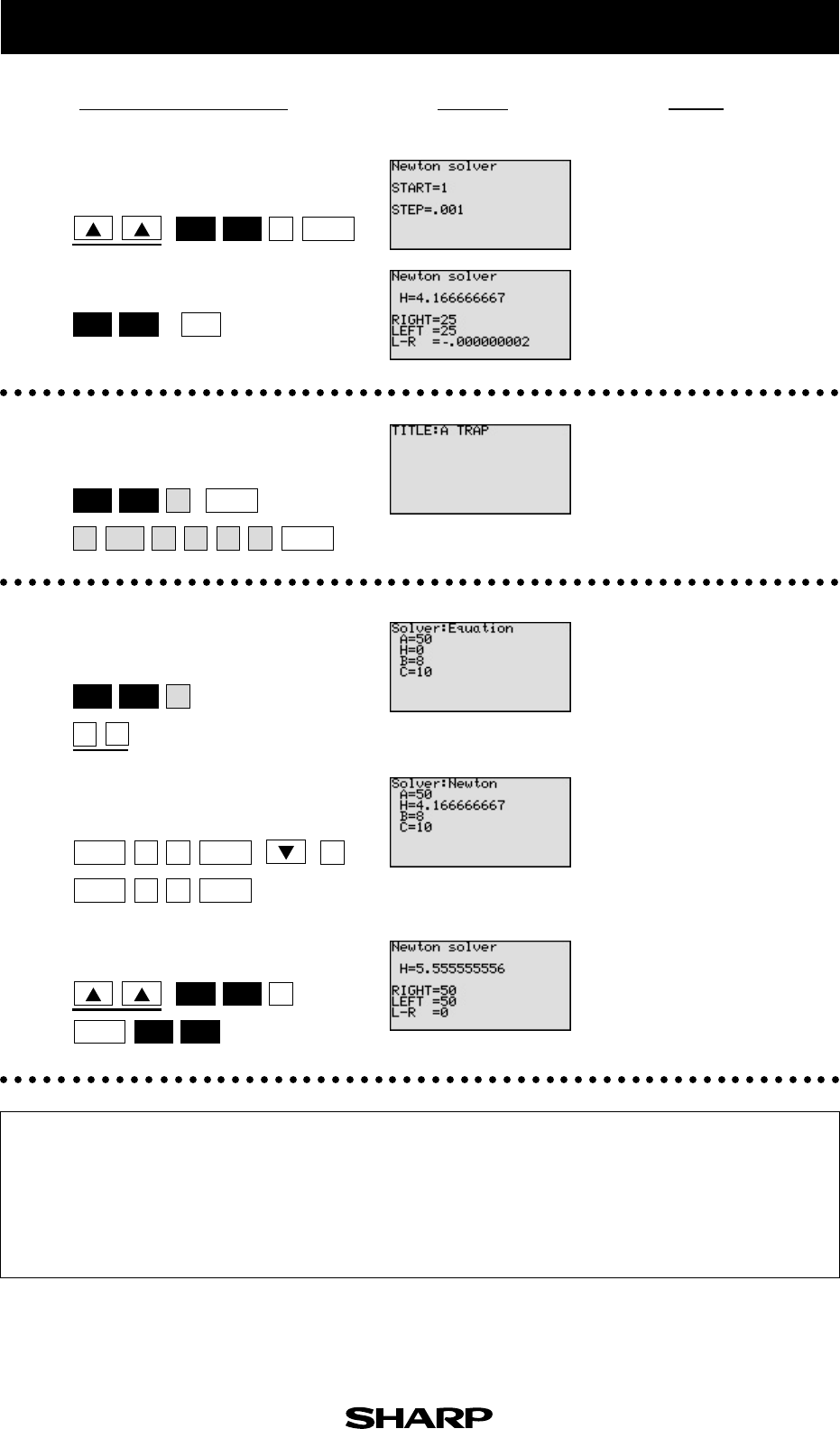
Step & Key Operation
*Use either pen touch or cursor to operate.
Display Notes
EL-9650/9600c Graphing Calculator
3-3
Enter the values:
A = 50, B = 8, C = 10.
3-2
Newton's method will
prompt with a guess or a
starting point.
1-5Solve for the height and enter a
starting point of 1.
*
The answer is : h = 4.17
Solve.
1-6
( )
Save this formula. Give the formula
the name “A TRAP”.
2
*
Recall the formula for calculating
the area of a trapezoid.
3-1
*
* *
The answer is : h = 5.56Solve.
3-3
*
One very useful feature of the calculator is its ability to store and recall equations.
The solution from various values for known variables can be easily obtained by
recalling an equation which has been stored and giving values to the known
variables in the Solver mode. If a starting point is known, Newton's method is
useful for quick solution of a complicated equation.
ENTER
ENTER
ENTER
ENTER
ENTER
ENTER
ENTER
ENTER
2nd F EXE
2nd F EXE
2nd F EXE
2nd F EXE
1
50
10
01
8
B
TAPA
C
1
CL
2nd F
SOLVER
SPACE
2nd F
SOLVER
R
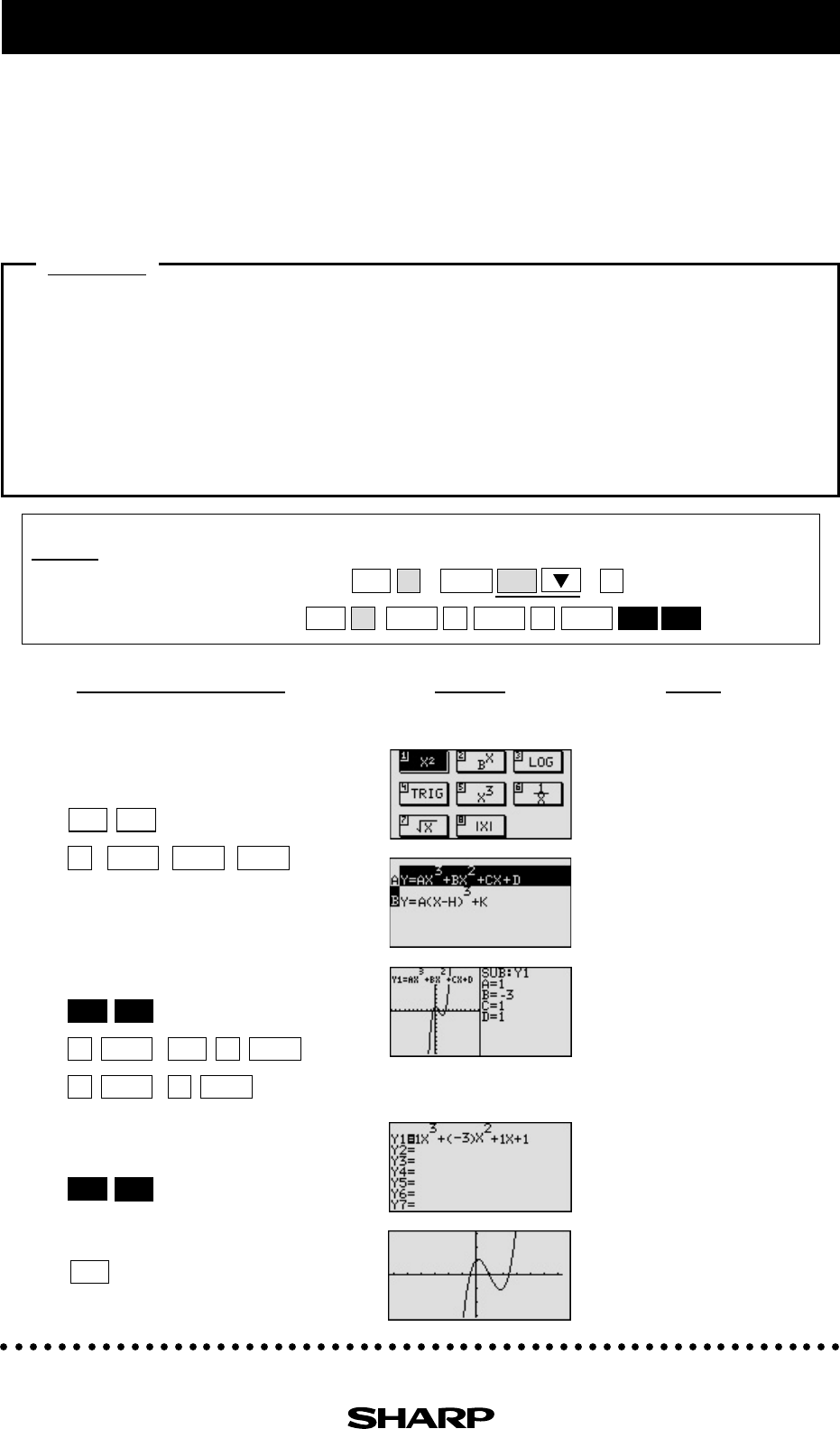
EL-9650/9600c Graphing Calculator
* * * *
Graphing Polynomials and Tracing to Find the Roots
A polynomial y = f (x) is an expression of the sums of several terms that contain different
powers of the same originals. The roots are found at the intersection of the x-axis and
the graph, i. e. when y = 0.
Draw a graph of a polynomial and approximate the roots by using the Zoom-in
and Trace features.
1. Graph the polynomial y = x3 - 3x2 + x + 1.
2. Approximate the left-hand root.
3. Approximate the middle root.
4. Approximate the right-hand root.
Enter the polynomial
y = x3 - 3x2 + x + 1.
Enter the coefficients.
1-1
1-2
Example
* *
*
Return to the equation display
screen.
1-3
View the graph.
1-4
4-1
NotesStep & Key Operation
*Use either pen touch or cursor to operate.
Display
It may take few seconds for
the graph to be drawn.
Enter each coefficients when
the cursor is displayed.
GRAPH
Y= EZ
5
1
1
3
1
2nd F EXE
ENTER ENTER ENTER
ENTER
ENTER ENTER
ENTER
(-)
2nd F SUB
Before
Starting
There may be differences in the results of calculations and graph plotting depending on the setting.
Return all settings to the default value and delete all data.
Set the zoom to the decimal window: * ( * ) *
Setting the zoom factors to 5 : *
A
ZOOM
ZOOM
B
7
55
2nd F
QUIT
ENTER
ENTER ENTER ENTER
ALPHA
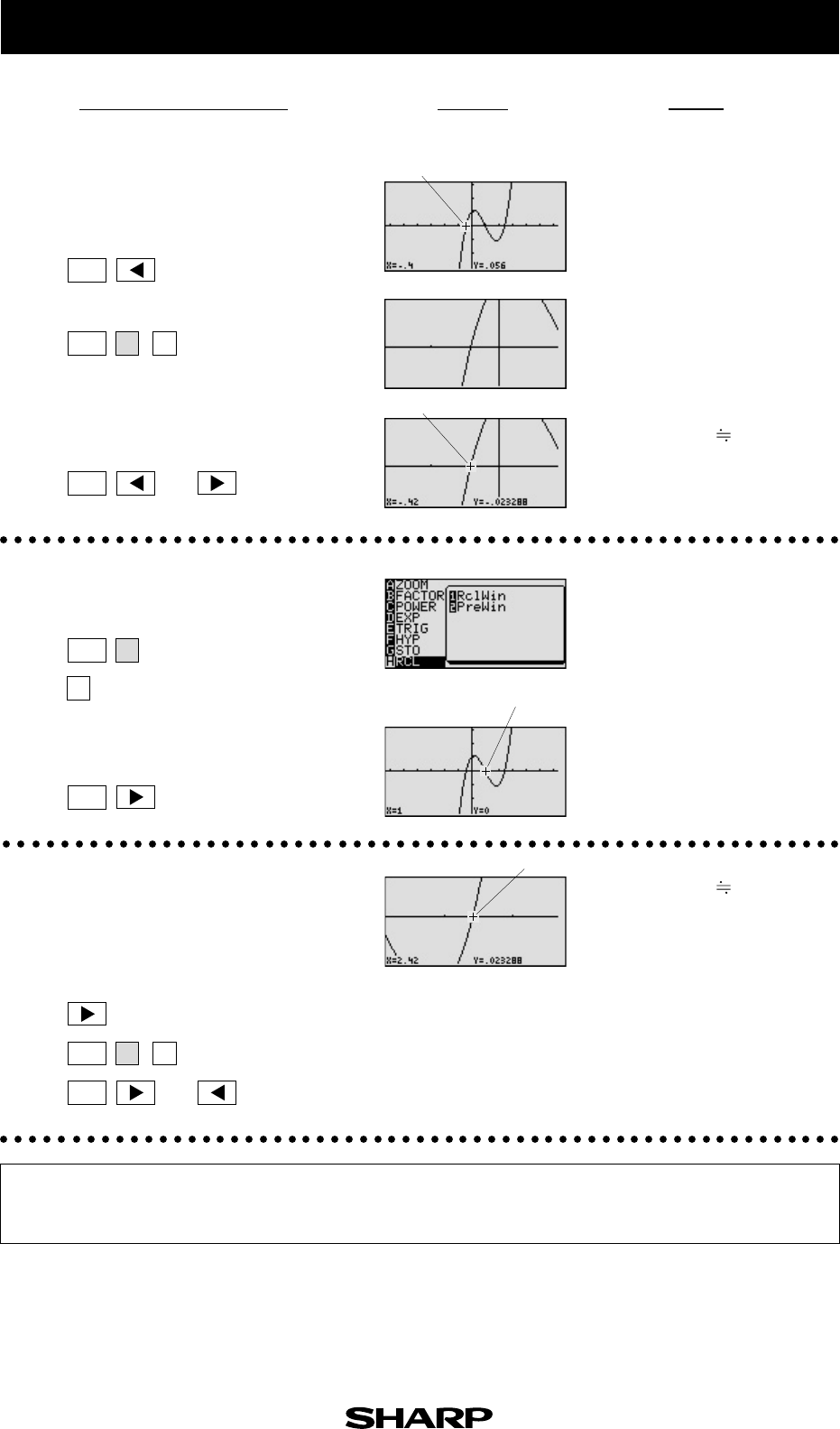
Step & Key Operation
*Use either pen touch or cursor to operate.
Display Notes
EL-9650/9600c Graphing Calculator
* (repeatedly)
Note that the tracer is flashing
on the curve and the x and y
coordinates are shown at the
bottom of the screen.
The root is exactly x = 1.
(Zooming is not needed to
find a better approximate.)
Move the tracer near the left-hand
root.
2-1
Zoom in on the left-hand root.
2-2
Move the tracer to approximate the
root.
2-3
Return to the previous decimal
viewing window.
3-1
Move the tracer to approximate
the middle root.
3-2
Move the tracer near the right-
hand root.
Zoom in and move the tracer to
find a better approximate.
4
The calculator allows the roots to be found (or approximated) visually by
graphing a polynomial and using the Zoom-in and Trace features.
Tracer
Tracer
Tracer
* (repeatedly)
* *
* or * (repeatedly)
*
*
* (repeatedly)
* *
* or * (repeatedly)
4-1
The root is : x -0.42
The root is : x 2.42
Tracer
ZOOM
TRACE
ZOOM
ZOOM
TRACE
TRACE
TRACE
A3
2
A3
H
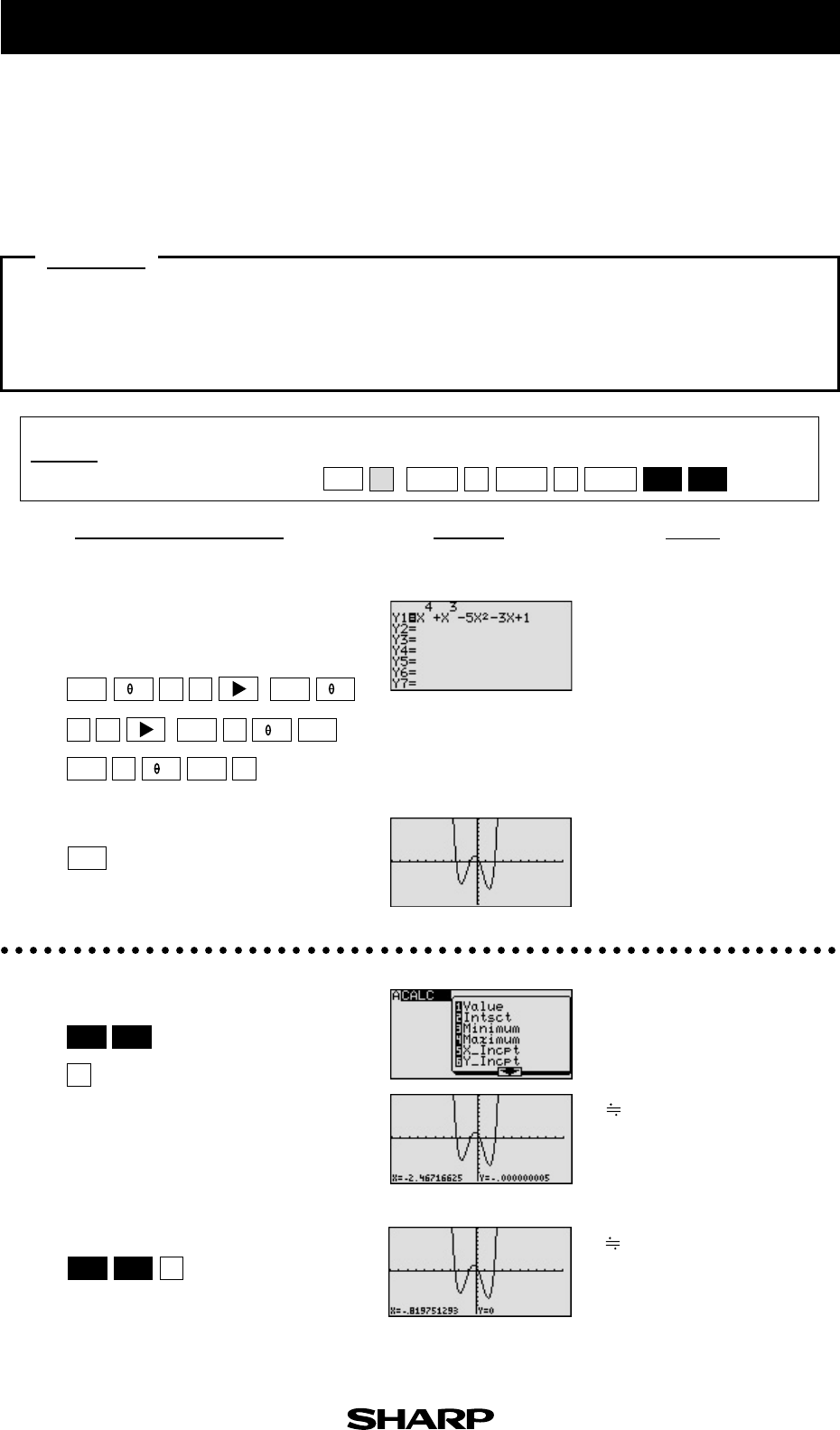
EL-9650/9600c/9450/9400 Graphing Calculator
There may be differences in the results of calculations and graph plotting depending on the setting.
Return all settings to the default value and delete all data.
Setting the zoom factors to 5 : *
Graphing Polynomials and Jumping to Find the Roots
Draw a graph of a polynomial and find the roots by using the Calculate feature.
Find the first root.
2-1
2-2
Example
1. Graph the polynomial y = x4 + x3 - 5x2 - 3x + 1.
2. Find the four roots one by one.
Notes
Enter the polynomial
y = x4 + x3 - 5x2 - 3x + 1
1-1
1-2
*
*
View the graph.
Find the next root.
x -2.47
Y is almost but not exactly zero.
Notice that the root found here
is an approximate value.
x -0.82
*
*
4-2
A polynomial y = f (x) is an expression of the sums of several terms that contain different
powers of the same originals. The roots are found at the intersection of the x-axis and the
graph, i. e. when y = 0.
ZOOM
A
ENTER ENTER ENTER 2nd F
QUIT
AA
Y= 4
35
31
5
5
+
—
—+
x2
ab
ab
2nd F CALC
2nd F CALC
GRAPH
X/
/T/nX/
/T/n
X/
/T/n
X/
/T/n
Before
Starting
Step & Key Operation
(When using EL-9650/9600c)
*Use either pen touch or cursor to operate.
Display
(When using EL-9650/9600c)
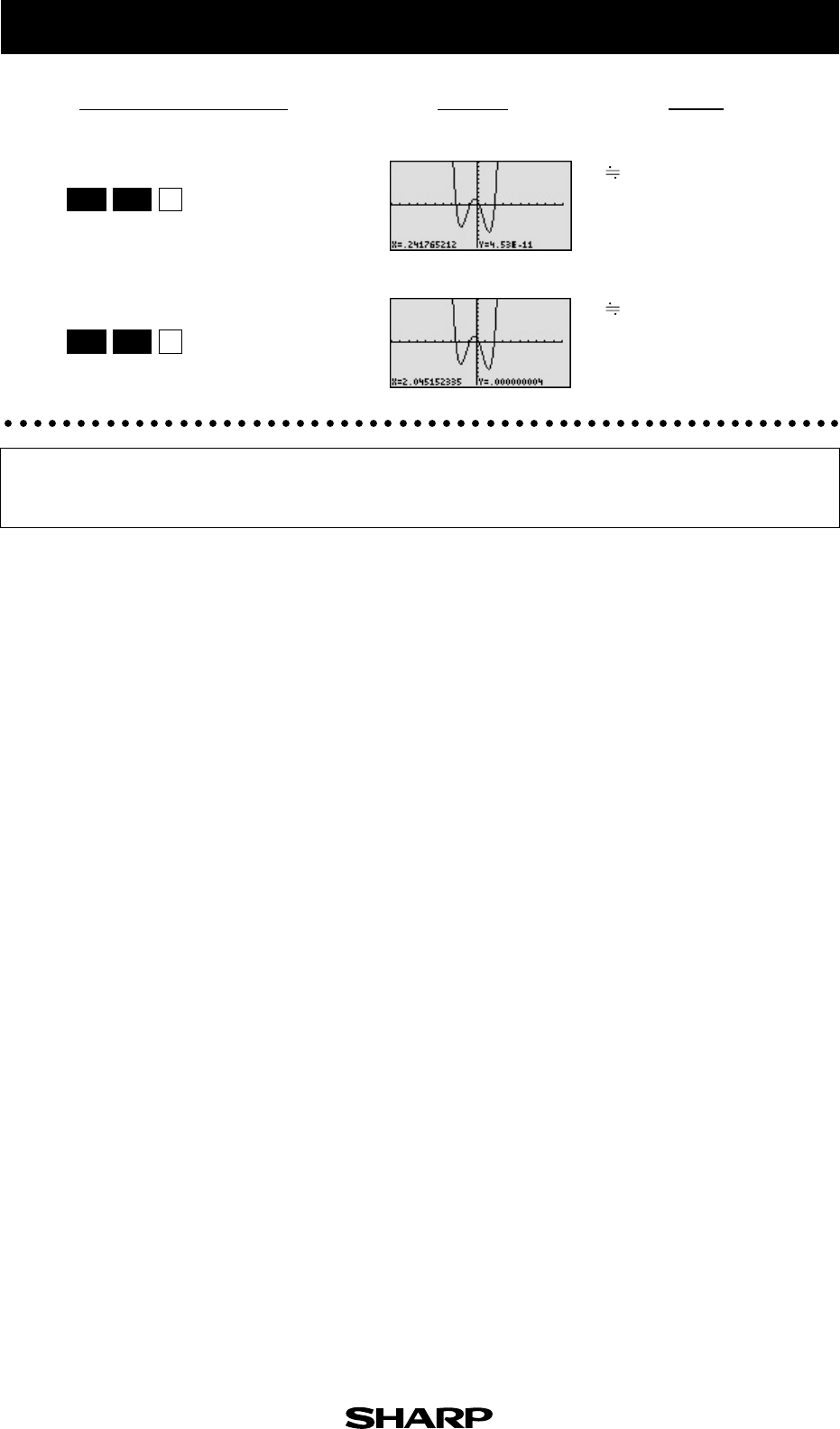
Step & Key Operation
(When using EL-9650/9600c)
*Use either pen touch or cursor to operate.
Display
(When using EL-9650/9600c)
EL-9650/9600c/9450/9400 Graphing Calculator
Notes
2-4
2-3
Find the next root. x 2.05
x 0.24
Find the next root.
The calculator allows jumping to find the roots by graphing a polynomial
and using the Calculate feature, without tracing the graph.
*
*
4-2
5
2nd F CALC
5
2nd F CALC
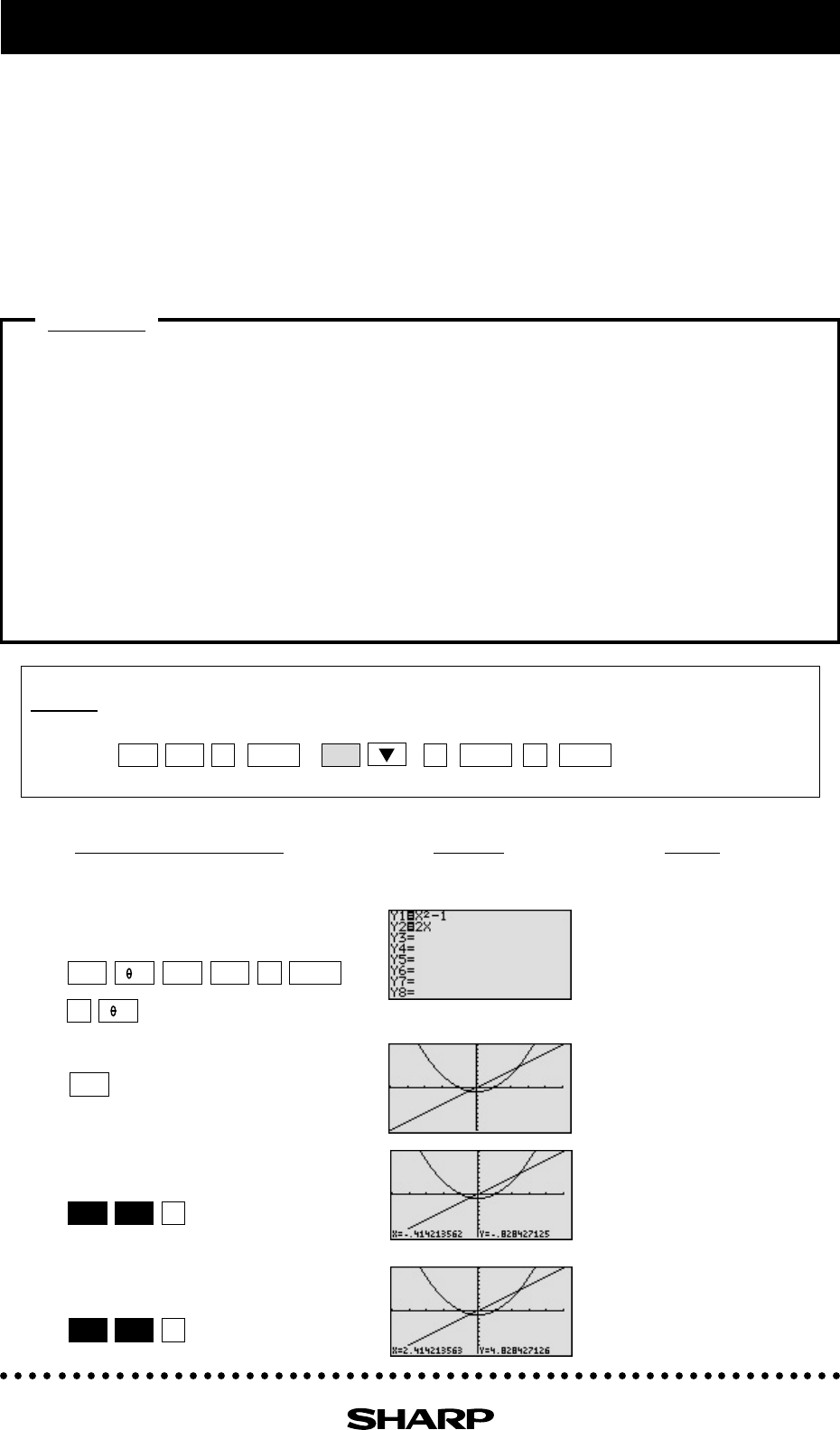
EL-9650/9600c/9450/9400 Graphing Calculator
There may be differences in the results of calculations and graph plotting depending on the setting.
Return all settings to the default and delete all data.
Choose the viewing window “-5 < X < 5”, “-10 < Y < 10” using Rapid window feature
* * ( ) * * * *
As the Tool feature is only available on the EL-9650/9600c, the example 2 does not apply to the EL-9450/9400.
NotesStep & Key Operation
(When using EL-9650/9600c)
*Use either pen touch or cursor to operate.
Display
(When using EL-9650/9600c)
Solving a System of Equations by Graphing or Tool Feature
A system of equations is made up of two or more equations. The calculator provides the
Calculate feature and Tool feature to solve a system of equations. The Calculate feature
finds the solution by calculating the intersections of the graphs of equations and is useful
for solving a system when there are two variables, while the Tool feature can solve a linear
system with up to six variables and six equations.
Note that the x and y coordi-
nates are shown at the bot-
tom of the screen. The answer
is : x = -0.41 y = -0.83
1. Solve the system using the Calculate feature.
2. Solve the system using the Tool feature.
Enter the system of equations
y = x2 - 1 for Y1 and y = 2x for Y2.
View the graphs.
1-1
Solve a system of equations using the Calculate or Tool feature. First, use the Calcu-
late feature. Enter the equations, draw the graph, and find the intersections. Then,
use the Tool feature to solve a system of equations.
1-2
Find the right-hand intersection by
accessing the Calculate feature again.
1-4The answer is : x = 2.41
y = 4.83
Example
The find the left-hand intersection
using the Calculate feature.
1-3
5-1
*
*
*
y = x2 - 1
y = 2x
5x + y = 1
-3x + y = -5
{
{
ENTER ENTER ENTER
EZ
ALPHA
574
WINDOW
GRAPH
Y= x2—1
ENTER
2
2
2
2nd F CALC
2nd F CALC
X/
/T/n
X/
/T/n
Before
Starting
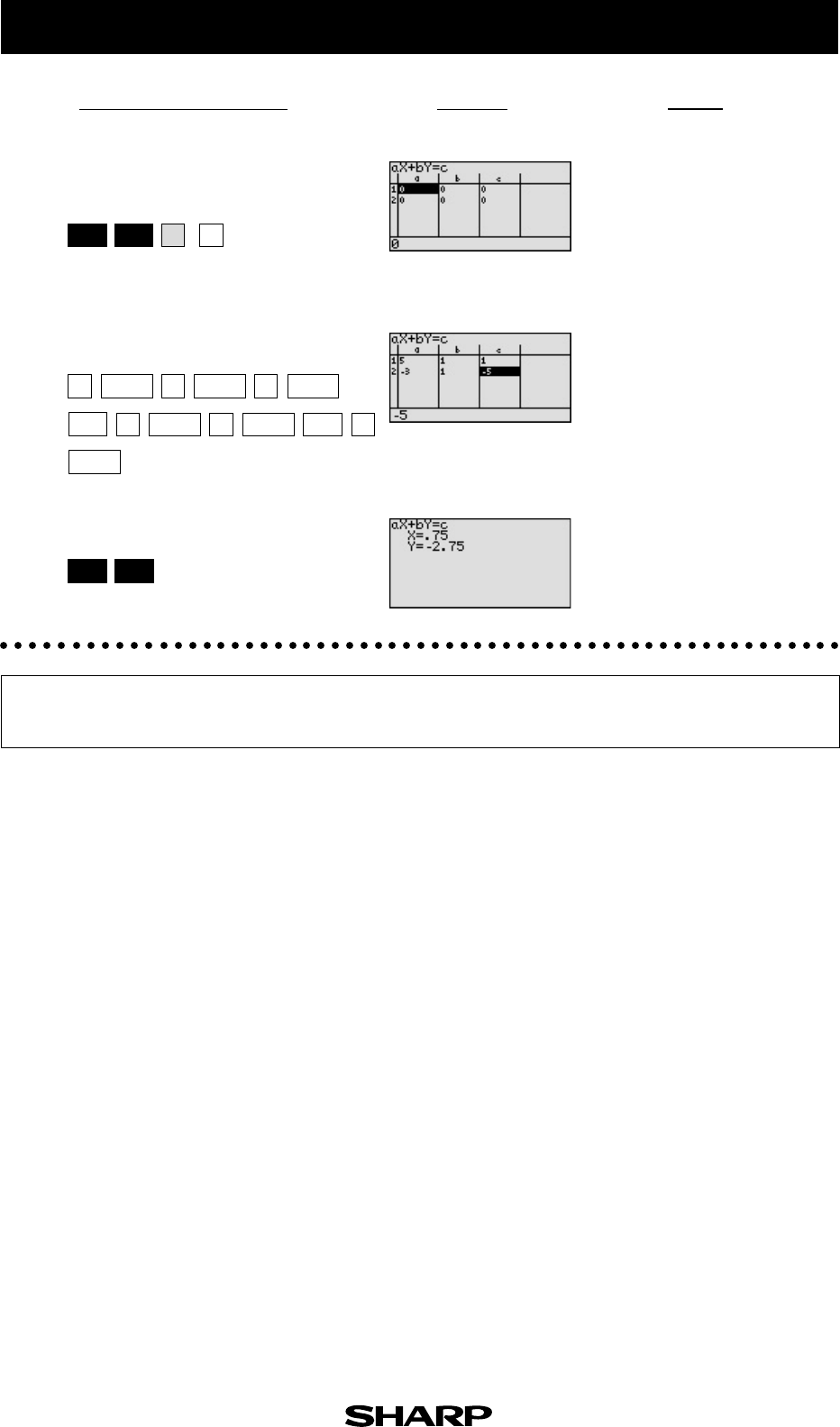
Step & Key Operation
(When using EL-9650/9600c)
*Use either pen touch or cursor to operate.
Display
(When using EL-9650/9600c)
EL-9650/9600c/9450/9400 Graphing Calculator
Notes
Access the Tool menu. Select the
number of variables.
Enter the system of equations.
Using the system function, it
is possible to solve simulta-
neous linear equations. Sys-
tems up to six variables and
six equations can be solved.
Solve the system.
2-1
2-2
2-3
5-1
* *
A system of equations can be solved easily by using the Calculate feature
or Tool feature.
x = 0.75
y = -2.75
2nd F
TOOL
B
EXE2nd F
2
511
31 5
ENTER ENTER ENTER
ENTER ENTER
ENTER
(-)(
-)
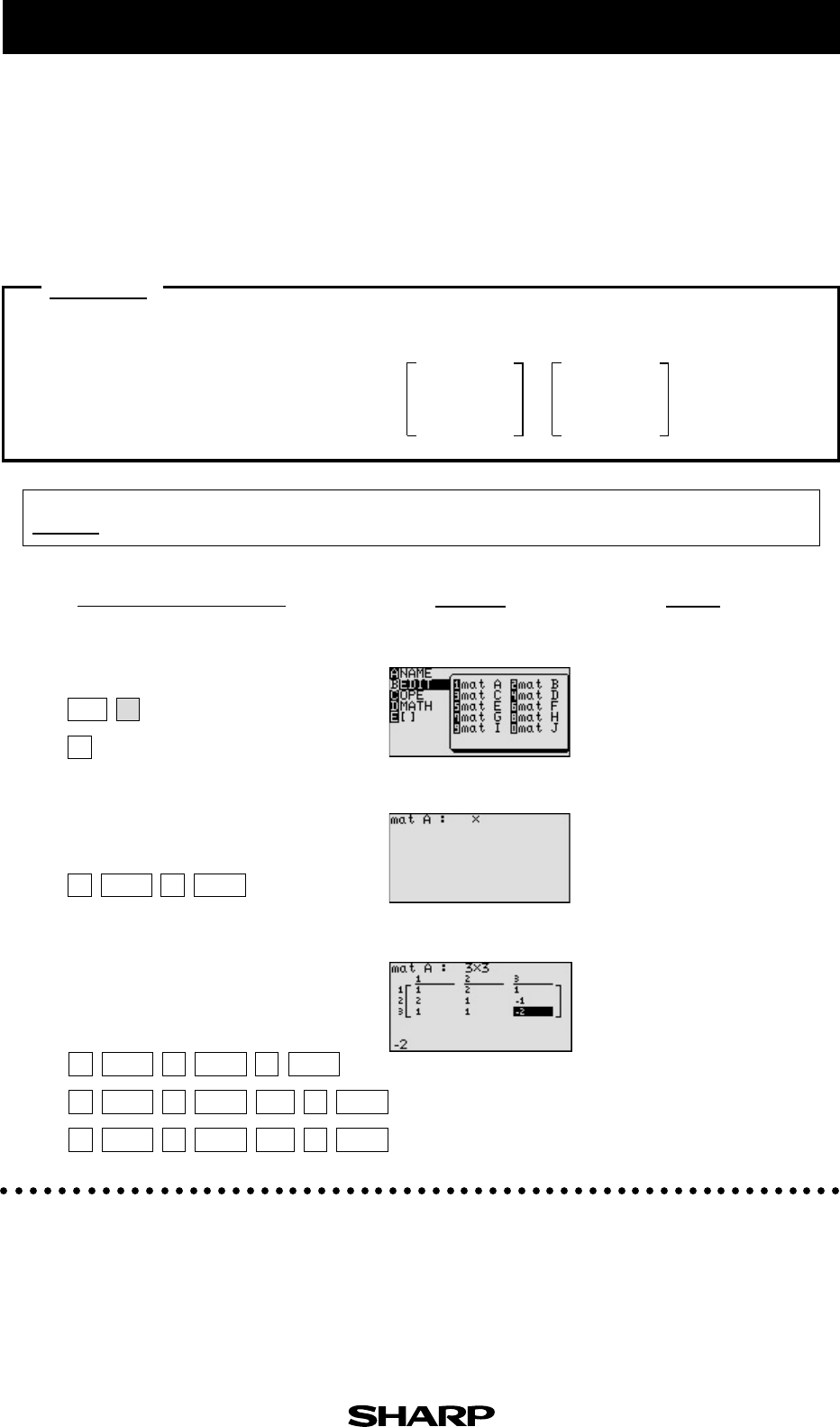
EL-9650/9600c Graphing Calculator
There may be differences in the results of calculations and graph plotting depending on the setting.
Return all settings to the default value and delete all data.
Notes
Step & Key Operation
*Use either pen touch or cursor to operate.
Display
Entering and Multiplying Matrices
1. Enter a 3x3 matrix A
2. Enter a 3x3 matrix B
3. Multiply the matrices A and B
Access the matrix menu.
Set the dimension of the matrix at
three rows by three columns.
1-1
1-2
Example
Enter the elements of the first row,
the elements of the second row, and
the elements of the third row.
1-3
A matrix is a rectangular array of elements in rows and columns that is treated as a single
element. A matrix is often used for expressing multiple linear equations with multiple
variables.
6-1
*
*
Enter two matrices and execute multiplication of the two.
A
1 2 1
2 1 -1
1 1 -2
B
1 2 3
4 5 6
7 8 9
MATRIX
B
1
33
121
21 1
11 2
ENTER ENTER
ENTER ENTER ENTER
ENTER ENTER
ENTER ENTER ENTER
ENTER
(-)
(-)
Before
Starting
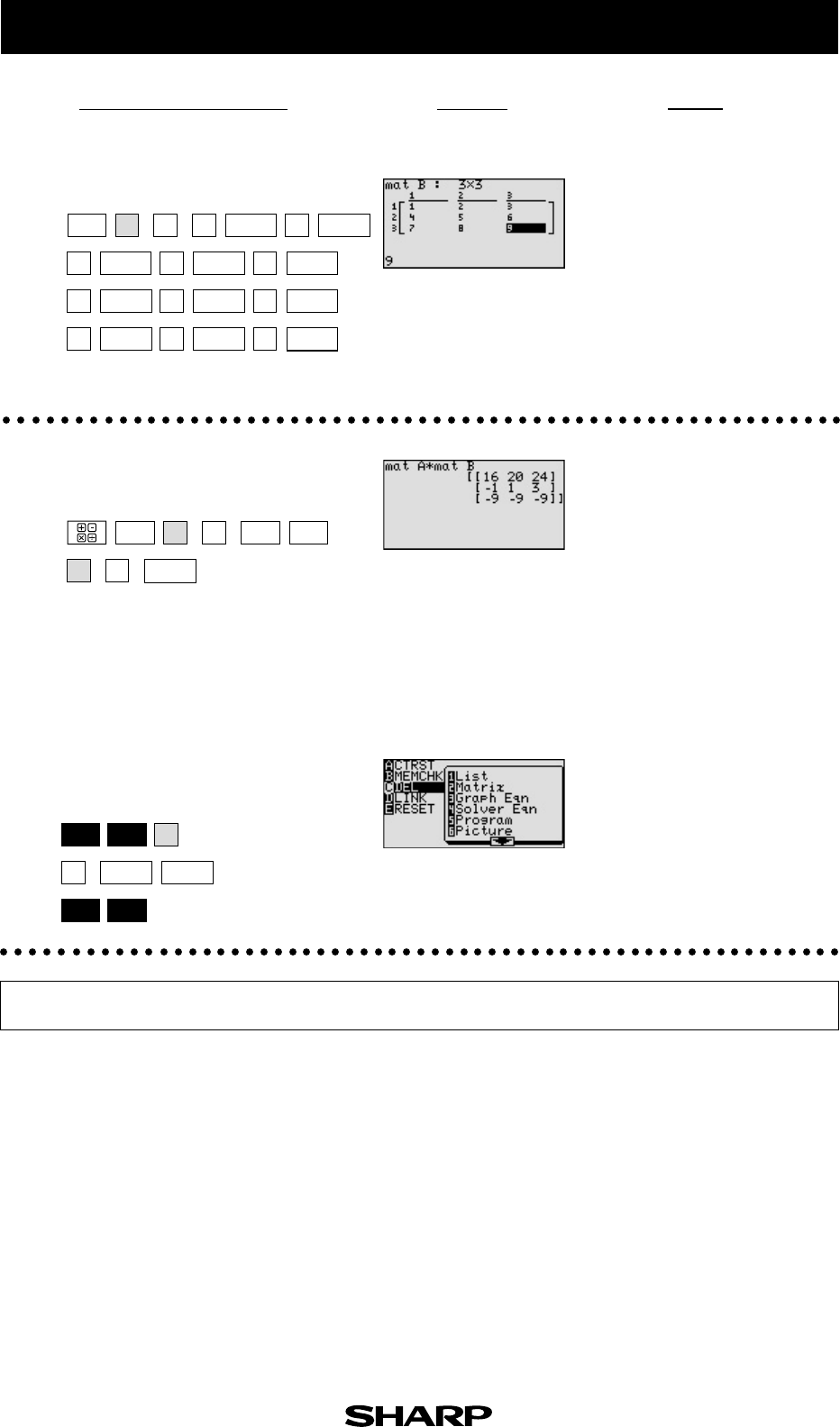
Step & Key Operation
*Use either pen touch or cursor to operate.
Display Notes
EL-9650/9600c Graphing Calculator
Matrix multiplication can be
performed if the number of col-
umns of the first matrix is equal
to the number of rows of the
second matrix. The sum of these
multiplications (1.1 + 2.4 + 1.7)
is placed in the 1,1 (first row,
first column) position of the re-
sulting matrix. This process is
repeated until each row of A has
been multiplied by each column
of B.
Enter a 3x3 matrix B.
2
Multiply the matrices A and B
together at the home screen.
3-1
Delete the input matrices for
future use.
3-2
6-1
* *
* *
* *
*
*
Matrix multiplication can be performed easily by the calculator.
MATRIX
MATRIX MATRIX
X
B23 3
123
456
789
A1
A2
C
2
2nd F
QUIT
2nd F
OPTION
ENTER ENTER
ENTER ENTER ENTER
ENTER ENTER ENTER
ENTER ENTER ENTER
ENTER
ENTER ENTER
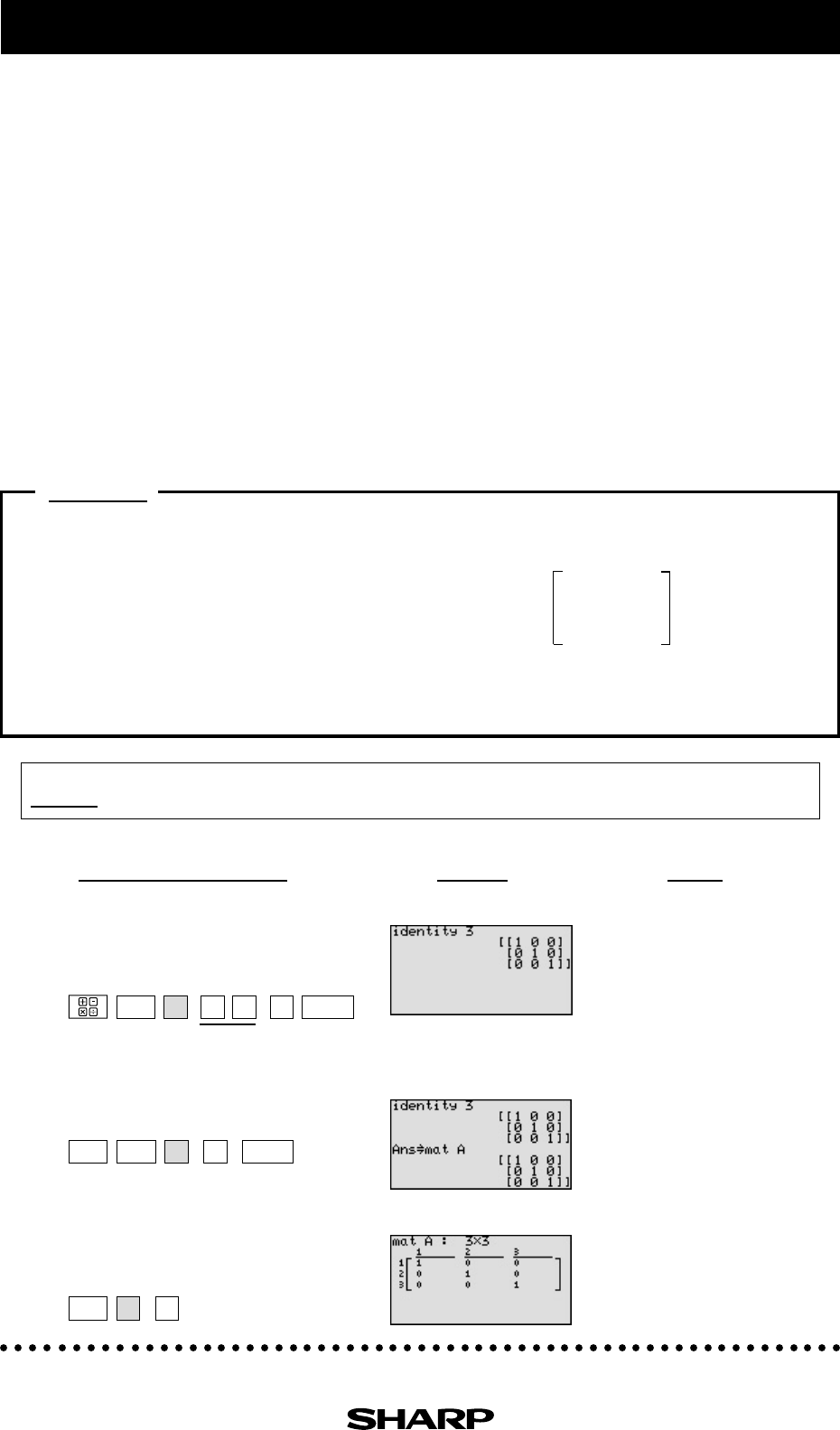
EL-9650/9600c Graphing Calculator
There may be differences in the results of calculations and graph plotting depending on the setting.
Return all settings to the default value and delete all data.
NotesStep & Key Operation
*Use either pen touch or cursor to operate.
Display
1. Enter the 3x3 identity matrix in matrix A.
2. Find the inverse matrix of the matrix B.
3. Solve the equation system.
x + 2y + z = 8
2x + y - z = 1
x + y - 2z = -3
Example
Use matrix multiplication to solve a system of linear equations.
B
1 2 1
2 1 -1
1 1 -2
Solving a System of Linear Equations Using Matrices
Set up 3x3 identity matrix at the
home screen.
Save the identity matrix in matrix A.
1-1
1-2
Confirm that the identity matrix is
stored in matrix A.
1-3
Each system of three linear equations consists of three variables. Equations in more than
three variables cannot be graphed on the graphing calculator. The solution of the system of
equations can be found numerically using the Matrix feature or the System solver in the
Tool feature.
A system of linear equations can be expressed as AX = B (A, X and B are matrices). The
solution matrix X is found by multiplying A-1 B. Note that the multiplication is “order sensitive”
and the correct answer will be obtained by multiplying BA-1. An inverse matrix A-1 is a
matrix that when multiplied by A results in the identity matrix I (A-1 x A=I). The identity
matrix I is defined to be a square matrix (nxn) where each position on the diagonal is 1
and all others are 0.
6-2
* *
* *
* *
{
MATRIX
MATRIX
MATRIX
05 3
A1
B1
ENTER
ENTER
STO
C
Before
Starting
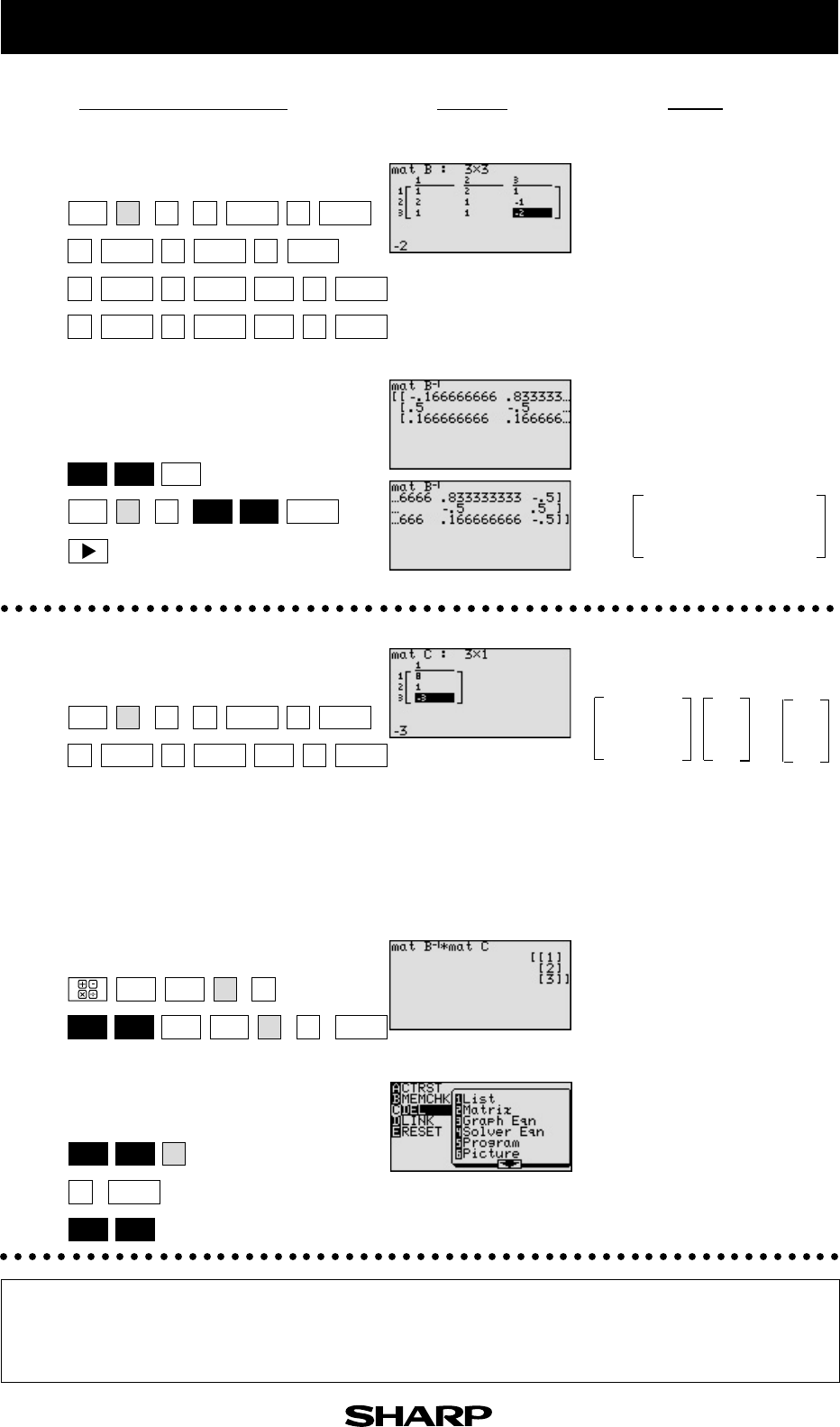
Step & Key Operation
*Use either pen touch or cursor to operate.
Display Notes
EL-9650/9600c Graphing Calculator
3-3
3-1
Delete the input matrices for future
use.
The 1 is the x coordinate, the 2
the y coordinate, and the 3 the z
coordinate of the solution point.
(x, y, z)=(1, 2, 3)
The system of equations can be
expressed as
Enter the constants on the right side
of the equal sign into matrix C (3x1).
2-1Enter a 3x3 matrix B.
2-2
Some square matrices have no
inverse and will generate error
statements when calculating the
inverse.
Exit the matrix editor and find the
inverse of the square matrix B.
6-2
* *
* *
(repeatedly)
* *
*
*
The calculator can execute calculation of inverse matrix and matrix
multiplication. A system of linear equations can be solved easily using the
Matrix feature.
-0.17 0.83 -0.5
0.5 -0.5 0.5
0.17 0.17 -0.5
B-1=
* *
* *
3-2
x
y
z
1 2 1
2 1 -1
1 1 -2
8
1
-3
=
Let each matrix B, X, C :
BX = C
B-1BX = B-1C (multiply both
sides by B-1)
I = B-1 (B-1B = I, identity matrix)
X = B-1 C
Calculate B-1C.
MATRIX
MATRIX
MATRIX
MATRIX
MATRIX
233
12
21
11
1
1
2
A2
B33 1
813
A2
A3
C
2
2nd F
QUIT2nd F
OPTION
2nd F
ENTER
ENTER
x-1
X
CL
ENTER ENTER
ENTER ENTER ENTER
ENTER
ENTER ENTER
ENTER ENTER
ENTER ENTER
ENTER ENTER ENTER
ENTER
ENTER
CL
2nd F
2nd F
x-1
QUIT
(-)
(-)
(-)
B
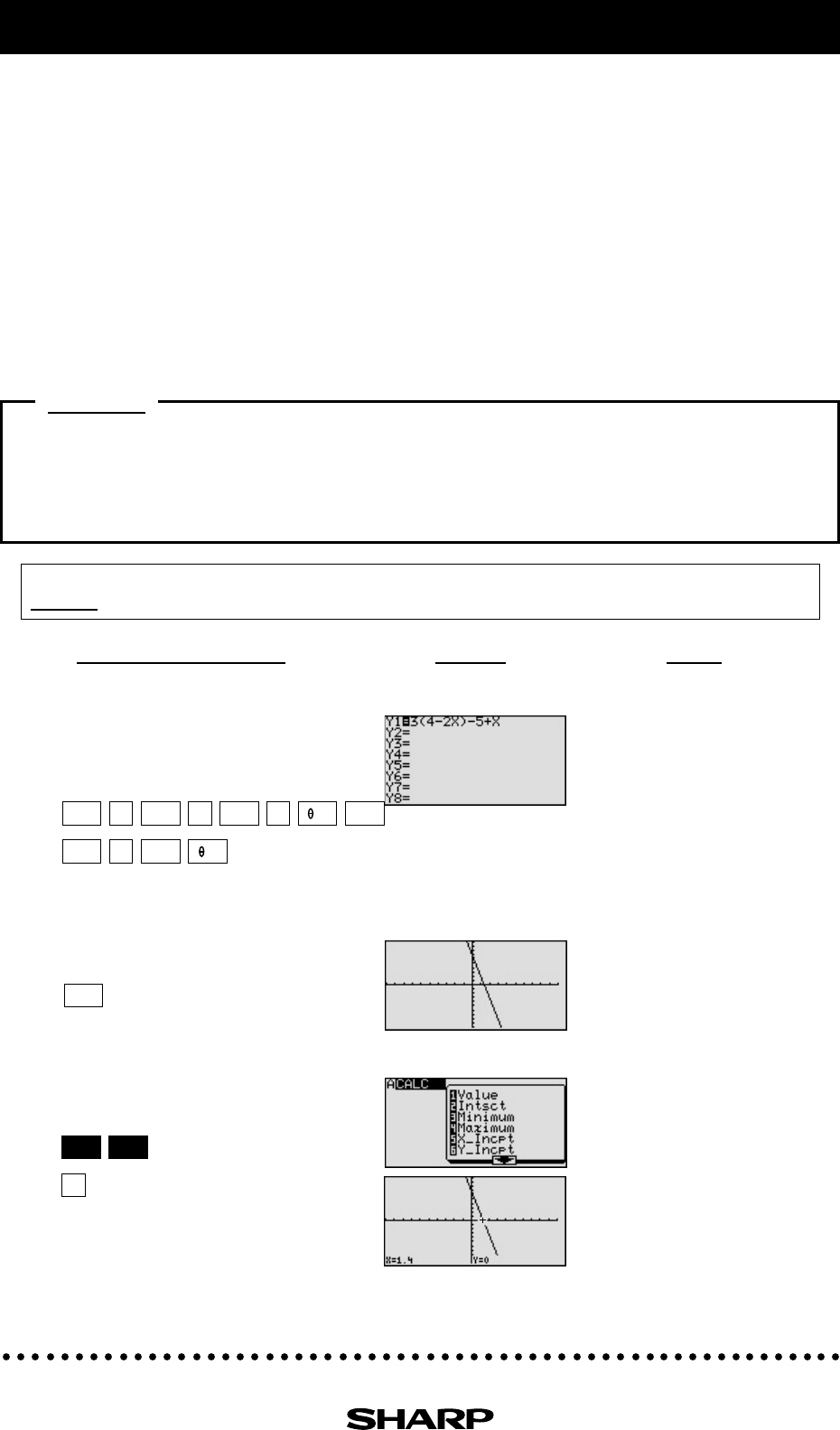
EL-9650/9600c Graphing Calculator
Solving Inequalities
To solve an inequality, expressed by the form of f(x)
≤
0, f(x)
≥
0, or form of f(x)
≤
g(x),
f(x)
≥
g(x), means to find all values that make the inequality true.
There are two methods of finding these values for one-variable inequalities, using graphical
techniques. The first method involves rewriting the inequality so that the right-hand side of
the inequality is 0 and the left-hand side is a function of x. For example, to find the solution
to f(x) < 0, determine where the graph of f(x) is below the x-axis. The second method
involves graphing each side of the inequality as an individual function. For example, to find
the solution to f(x) < g(x), determine where the graph of f(x) is below the graph of g(x).
Solve an inequality in two methods.
Example
1.
Solve 3(4 - 2x)
≥
5 - x, by rewriting the right-hand side of the inequality as 0.
2.
Solve 3(4 - 2x)
≥
5 - x, by shading the solution region that makes the inequality true.
There may be differences in the results of calculations and graph plotting depending on the setting.
Return all settings to the default value and delete all data.
NotesStep & Key Operation
*Use either pen touch or cursor to operate.
Display
1-2View the graph.
Find the location of the x-intercept
and solve the inequality.
*
1-3The x-intercept is located at
the point (1.4, 0).
Since the graph is above the
x-axis to the left of the x-in-
tercept, the solution to the in-
equality 3(4 - 2x) - 5 + x
≥
0 is
all values of x such that
x
≤
1.4.
Rewrite the equation 3(4 - 2x)
≥
5 - x
so that the right-hand side becomes 0,
and enter y = 3(4 - 2x) - 5 + x for Y1.
3(4 - 2x) ≥ 5 - x
➞ 3(4 - 2x) - 5 + x ≥ 0
1-1
7-1
2nd F CALC
5
342
5
Y= ()
—
—+
GRAPH
X/
/T/n
X/
/T/n
Before
Starting
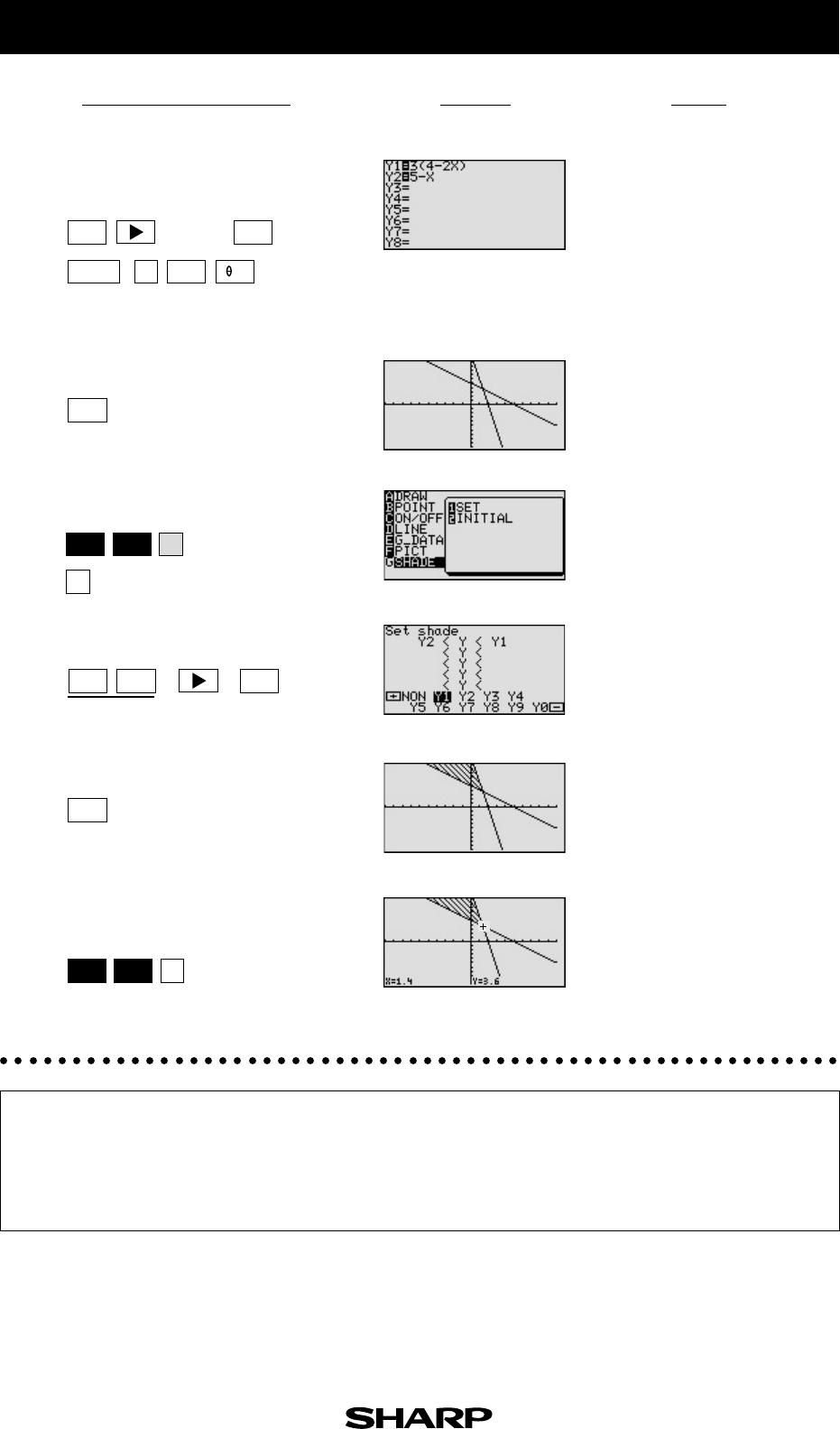
NotesStep & Key Operation
*Use either pen touch or cursor to operate.
Display
EL-9650/9600c Graphing Calculator
2-1Enter y = 3(4 - 2x) for Y1 and
y = 5 - x for Y2.
* (7 times) (4 times)
*
2-2View the graph.
2-3Access the Set Shade screen.
*
*
2-4Set up the shading. Since the inequality being
solved is Y1
≥
Y2, the solu-
tion is where the graph of Y1
is “on the top” and Y2 is “on
the bottom.”
* * *
2-5View the shaded region.
2-6Find where the graphs intersect and
solve the inequality. The point of intersection is
(1.4, 3.6). Since the shaded
region is to the left of x = 1.4,
the solution to the inequality
3(4 - 2x)
≥
5 - x is all values
of x such that x
≤
1.4.
*
Graphical solution methods not only offer instructive visualization of the solution
process, but they can be applied to inequalities that are often difficult to solve
algebraically. The EL-9650/9600c allows the solution region to be indicated visually
using the Shade feature. Also, the points of intersection can be obtained easily.
7-1
GRAPH
Y=
DEL
—
———
2
G
1
5
ENTER
2nd F CALC
2nd F
DRAW
GRAPH
X/
/T/n
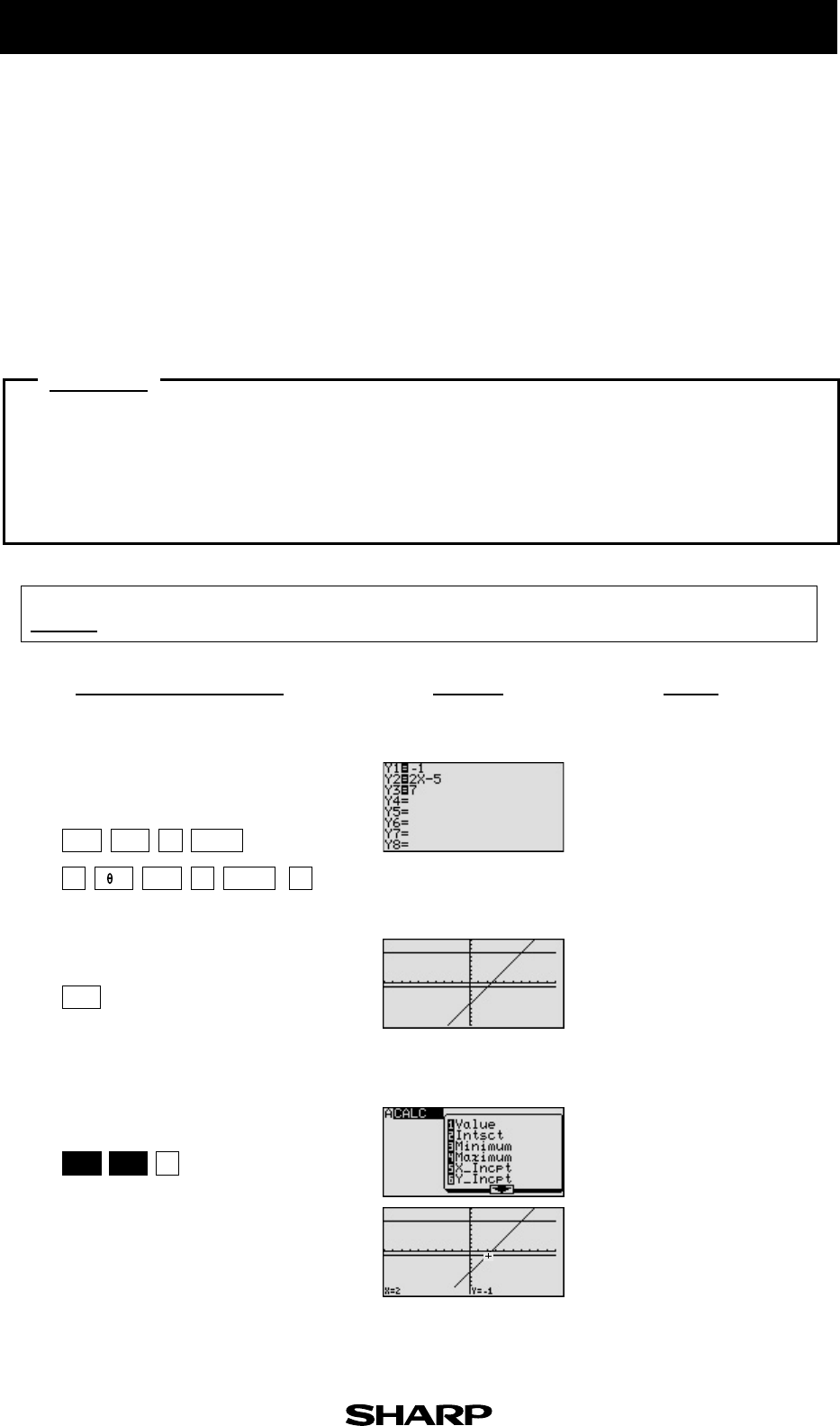
EL-9650/9600c/9450/9400 Graphing Calculator
There may be differences in the results of calculations and graph plotting depending on the setting.
Return all settings to the default value and delete all data.
NotesStep & Key Operation
(When using EL-9650/9600c)
*Use either pen touch or cursor to operate.
Display
(When using EL-9650/9600c)
Solving Double Inequalities
The solution to a system of two inequalities in one variable consists of all values of the variable
that make each inequality in the system true. A system f (x)
≥
a, f (x)
≤
b, where the same expression
appears on both inequalities, is commonly referred to as a “double” inequality and is often written
in the form a
≤
f (x)
≤
b. Be certain that both inequality signs are pointing in the same direction and
that the double inequality is only used to indicate an expression in x “trapped” in between two
values. Also a must be less than or equal to b in the inequality a
≤
f (x)
≤
b or b
≥
f (x)
≥
a.
Solve a double inequality, using graphical techniques.
Example
2x - 5
≥
-1
2x -5
≤
7
1Enter y = -1 for Y1, y = 2x - 5 for
Y2, and y = 7 for Y3. The “double” inequality
given can also be written to
-1
≤
2x - 5
≤
7.
*
*
2View the lines.
3Find the point of intersection. y = 2x - 5 and
y = -1 intersect at (2, -1).
*
7-2
Y= (-)1
257
2
2nd F CALC
—
ENTER
ENTER
GRAPH
X/
/T/n
Before
Starting

EL-9650/9600c/9450/9400 Graphing Calculator
NotesStep & Key Operation
(When using EL-9650/9600c)
*Use either pen touch or cursor to operate.
Display
(When using EL-9650/9600c)
4Move the tracer and find another
intersection. y = 2x - 5 and y = 7
intersect at (6,7).
*
5Solve the inequalities. The solution to the “double”
inequality -1
≤
2x - 5
≤
7 con-
sists of all values of x in be-
tween, and including, 2 and 6
(i.e., x
≥
2 and x
≤
6). The so-
lution is 2
≤
x
≤
6.
7-2
Graphical solution methods not only offer instructive visualization of the solution
process, but they can be applied to inequalities that are often difficult to solve
algebraically. The EL-9650/9600c/9450/9400 allows the solution region to be indicated
visually using the Shade feature. Also, the points of intersection can be obtained easily.
2
2nd F CALC
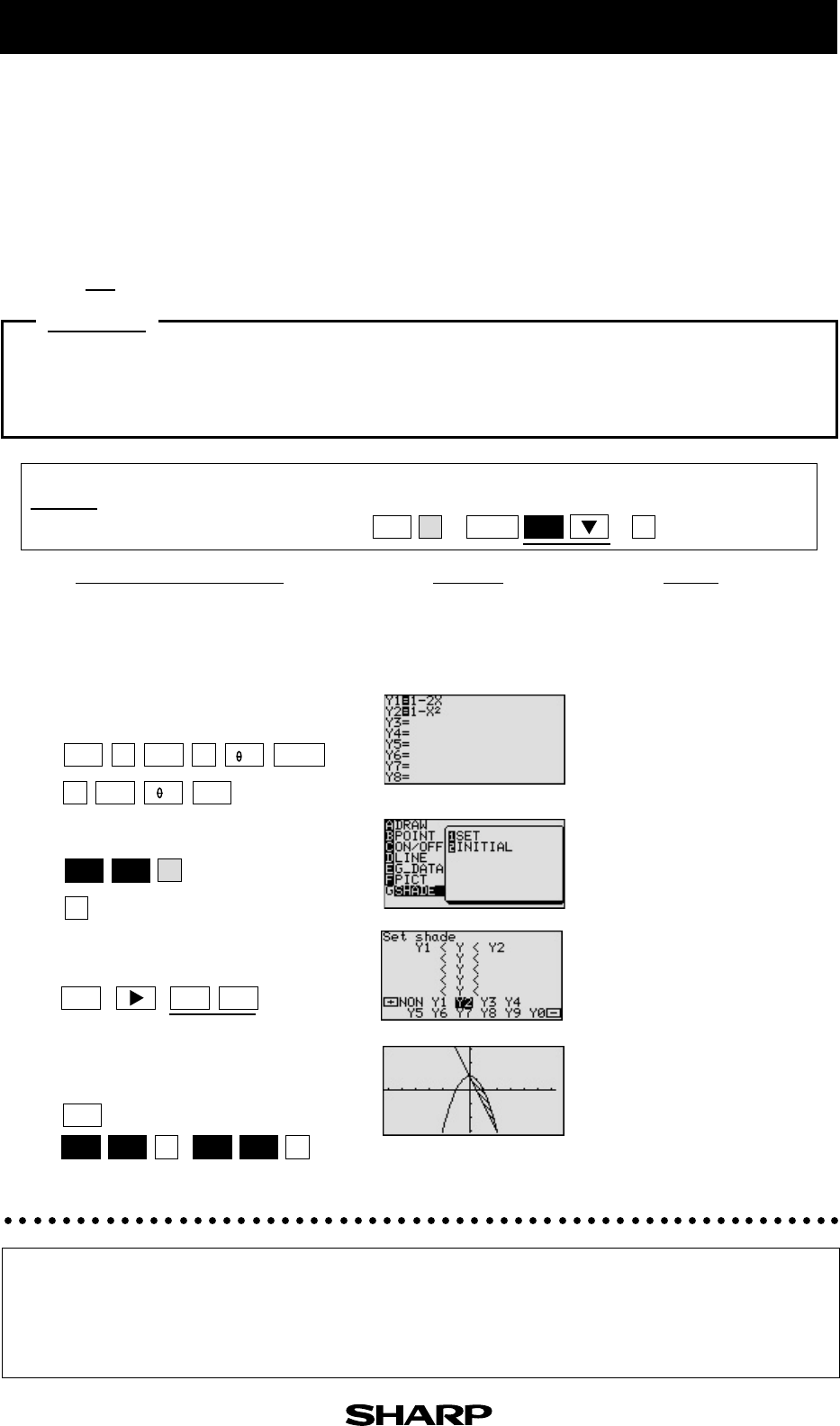
EL-9650/9600c/9450/9400 Graphing Calculator
4
There may be differences in the results of calculations and graph plotting depending on the setting.
Return all settings to the default value and delete all data.
Set the zoom to the decimal window: * ( * )
Notes
Step & Key Operation
(When using EL-9650/9600c)
*Use either pen touch or cursor to operate.
Display
(When using EL-9650/9600c)
System of Two-Variable Inequalities
The solution region of a system of two-variable inequalities consists of all points (a, b) such
that when x = a and y = b, all inequalities in the system are true. To solve two-variable
inequalities, the inequalities must be manipulated to isolate the y variable and enter the
other side of the inequality as a function. The calculator will only accept functions of the
form y = . (where y is defined explicitly in terms of x).
Example
Solve a system of two-variable inequalities by shading the solution region.
2x + y
≥
1
x2 + y
≤
1
7-3
2Enter y = 1 - 2x for Y1 and y = 1 - x2
for Y2.
*
Shade the points of y -value so that
Y1
≤
y
≤
Y2.
* * *
5Graph the system and find the
intersections. The intersections are (0, 1)
and (2, -3)
* *
6Solve the system. The solution is 0
≤
x
≤
2.
Graphical solution methods not only offer instructive visualization of the solution process,
but they can be applied to inequalities that are often difficult to solve algebraically.
The EL-9650/9600c/9450/9400 allows the solution region to be indicated visually using
the Shade feature. Also, the points of intersection can be obtained easily.
1Rewrite each inequality in the system
so that the left-hand side is y :2x + y
≥
1 ➞ y
≥
1 - 2x
x2 + y
≤
1 ➞ y
≤
1 - x2
*
*
3Access the set shade screen
ZOOM
2nd F
A
ENTER
7
GRAPH
Y= 1 2
1
22
—
—
———
G
1
x2
ENTER
2nd F
DRAW
CALC2nd F CALC2nd F
X/
/T/n
X/
/T/n
Before
Starting
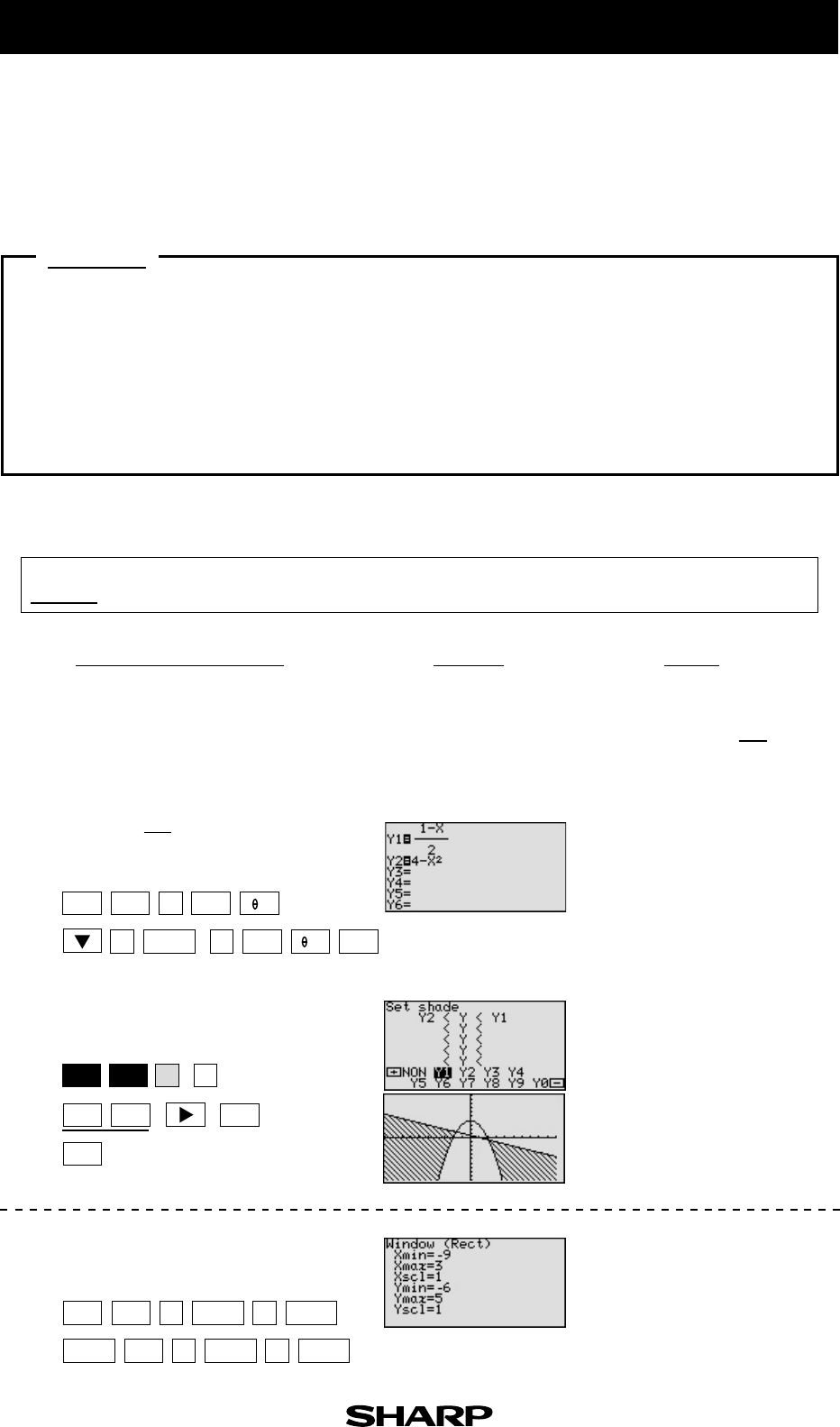
EL-9650/9600c/9450/9400 Graphing Calculator
There may be differences in the results of calculations and graph plotting depending on the setting.
Return all settings to the default value and delete all data.
NotesStep & Key Operation
(When using EL-9650/9600c)
*Use either pen touch or cursor to operate.
Display
(When using EL-9650/9600c)
7-4
Graphing Solution Region of Inequalities
The solution region of an inequality consists of all points (a, b) such that when x = a, and y = b,
all inequalities are true.
Check to see if given points are in the solution region of a system of inequalities.
Example
1. Graph the solution region of a system of inequalities:
x + 2y
≤
1
x2 + y
≥
4
2. Which of the following points are within the solution region?
(-1.6, 1.8), (-2, -5), (2.8, -1.4), (-8,4)
1-1Rewrite the inequalities so that the
left-hand side is y. x + 2y
≤
1 ➞ y
≤
x2+y
≥
4 ➞ y
≥
4 - x2
1-x
2
*
1-2Enter y = for Y1 and
y = 4 - x2 for Y2.
1-x
2
Set the shade and view the solution
region.
*
* * *
1-3Y2
≤
y
≤
Y1
Set the display area (window) to :
-9 < x < 3, -6 < y < 5.
2-1
GRAPH
Y= a/b 1
24
G1
93
65
ENTER
ENTER
ENTERENTER
ENTER ENTER
WINDOW
(-)
(-)
—— —
—
—x2
2nd F
DRAW
X/
/T/n
X/
/T/n
Before
Starting
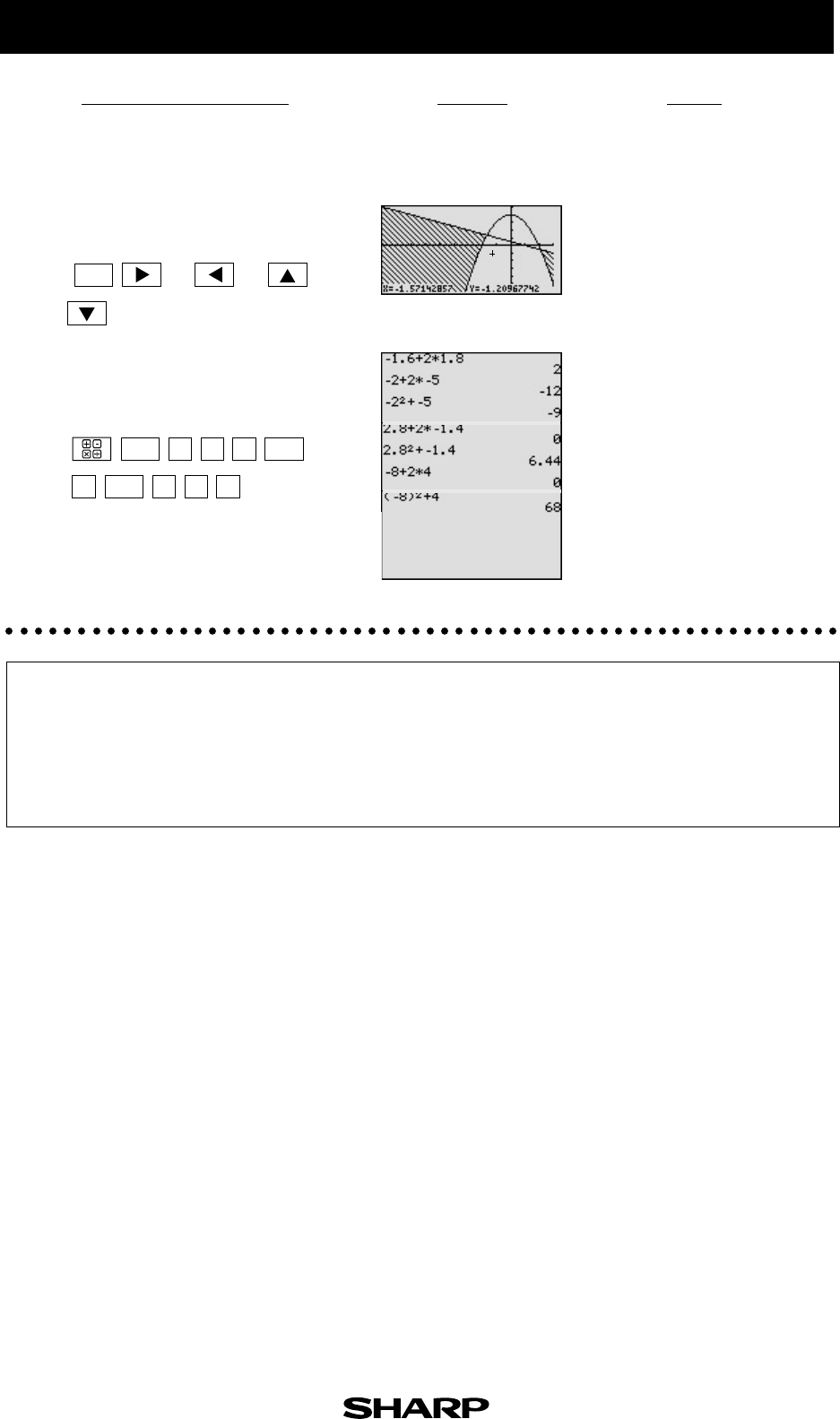
EL-9650/9600c/9450/9400 Graphing Calculator
NotesStep & Key Operation
(When using EL-9650/9600c)
*Use either pen touch or cursor to operate.
Display
(When using EL-9650/9600c)
7-4
Use the cursor to check the position
of each point. (Zoom in as necessary). Points in the solution region
are (2.8, -1.4) and (-8, 4).
Points outside the solution
region are (-1.6, 1.8) and
(-2, -5).
2-2
Substitute points and confirm
whether they are in the solution
region.
.(-1.6, 1.8):-1.6 + 2 ✕ 1.8 = 2
➞ This does not materialize.
.(-2, -5): -2 + 2 ✕ (-5) = -12
(-2)2 + (-5) = -1
➞ This does not materialize.
.(2.8, -1.4):2.8 + 2 ✕ (-1.4) = 0
(2.8)2 + (-1.4) = 6.44
➞ This materializes.
.(-8, 4): -8 + 2 ✕ 4 = 0
(-8)2 + 4 = 68
➞ This materializes.
...
(Continuing key operations omitted.)
2-3
Graphical solution methods not only offer instructive visualization of the solution process,
but they can be applied to inequalities that are often very difficult to solve algebraically.
The EL-9650/9600c/9450/9400 allows the solution region to be indicated visually using
the Shading feature. Also, the free-moving tracer or Zoom-in feature will allow the
details to be checked visually.
or or or
GRAPH
(-)+
X
•
•
16
218
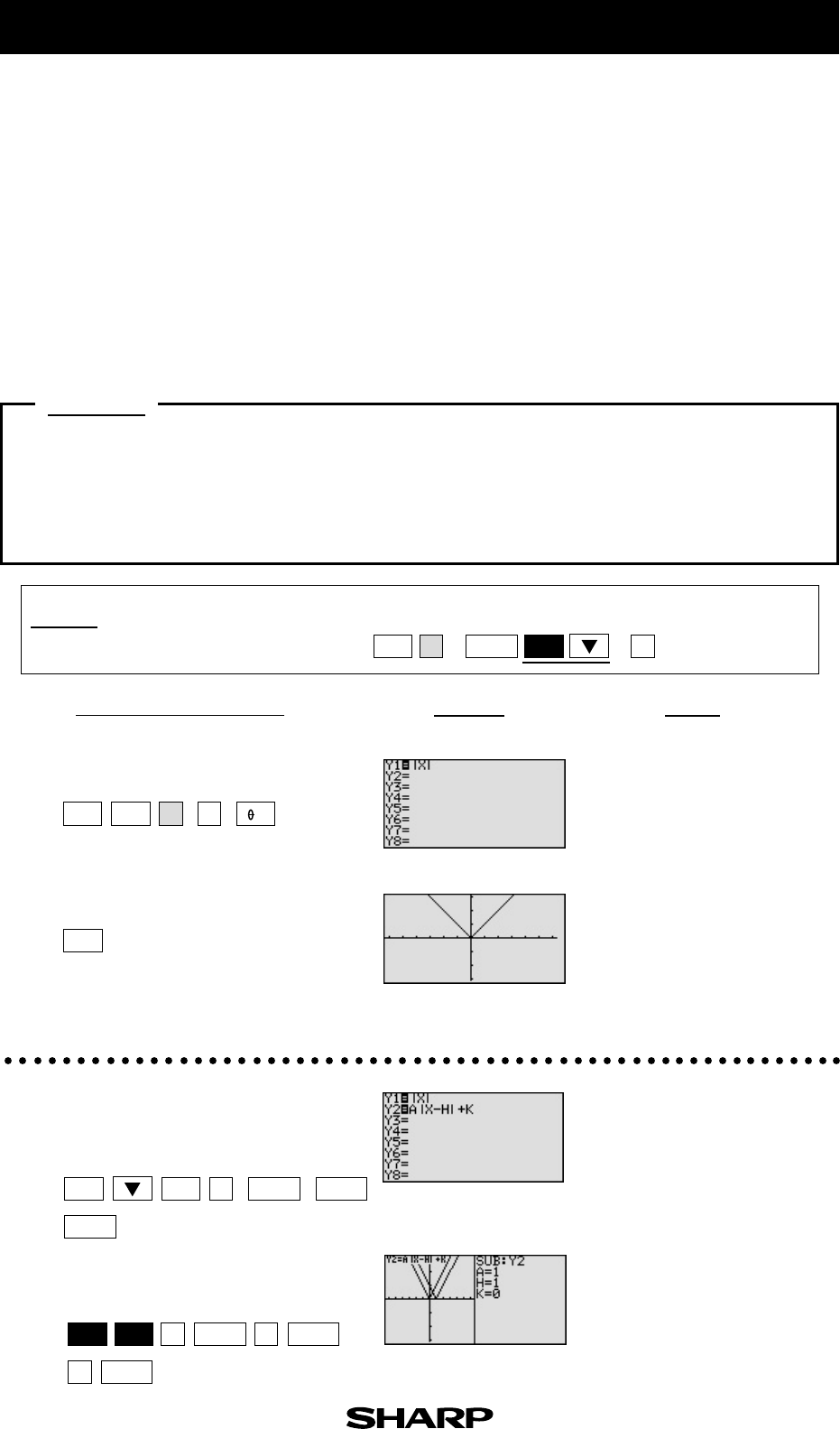
EL-9650/9600c Graphing Calculator
8-1
There may be differences in the results of calculations and graph plotting depending on the setting.
Return all settings to the default value and delete all data.
Set the zoom to the decimal window: * ( * )
Notes
Step & Key Operation
*Use either pen touch or cursor to operate.
Display
Slope and Intercept of Absolute Value Functions
The absolute value of a real number x is defined by the following:
|x| = x if x
≥
0
-x if x
≤
0
If n is a positive number, there are two solutions to the equation |f (x)| = n because there
are exactly two numbers with the absolute value equal to n: n and -n. The existence of two
distinct solutions is clear when the equation is solved graphically.
An absolute value function can be presented as y = a|x - h| + k. The graph moves as the
changes of slope a, x-intercept h, and y-intercept k.
Consider various absolute value functions and check the relation between the
graphs and the values of coefficients.
Example
1. Graph y = |x|
2. Graph y = |x -1| and y = |x|-1 using the Rapid Graph feature.
1-1Enter the function y =|x| for Y1.
Notice that the domain of f(x)
= |x| is the set of all real num-
bers and the range is the set of
non-negative real numbers.
Notice also that the slope of the
graph is 1 in the range of X > 0
and -1 in the range of X
≤
0.
* *
1-2View the graph.
2-1Enter the standard form of an abso-
lute value function for Y2 using the
Rapid Graph feature.
* * *
*
2-2Substitute the coefficients to graph
y = |x - 1|.
ZOOM
ENTER 2nd F
A7
Y=
Y=
ENTER
ENTER ENTER
ENTER ENTER
EZ
2nd F SUB
MATH
B1
8
11
0
X/
/T/n
GRAPH
ENTER
Before
Starting
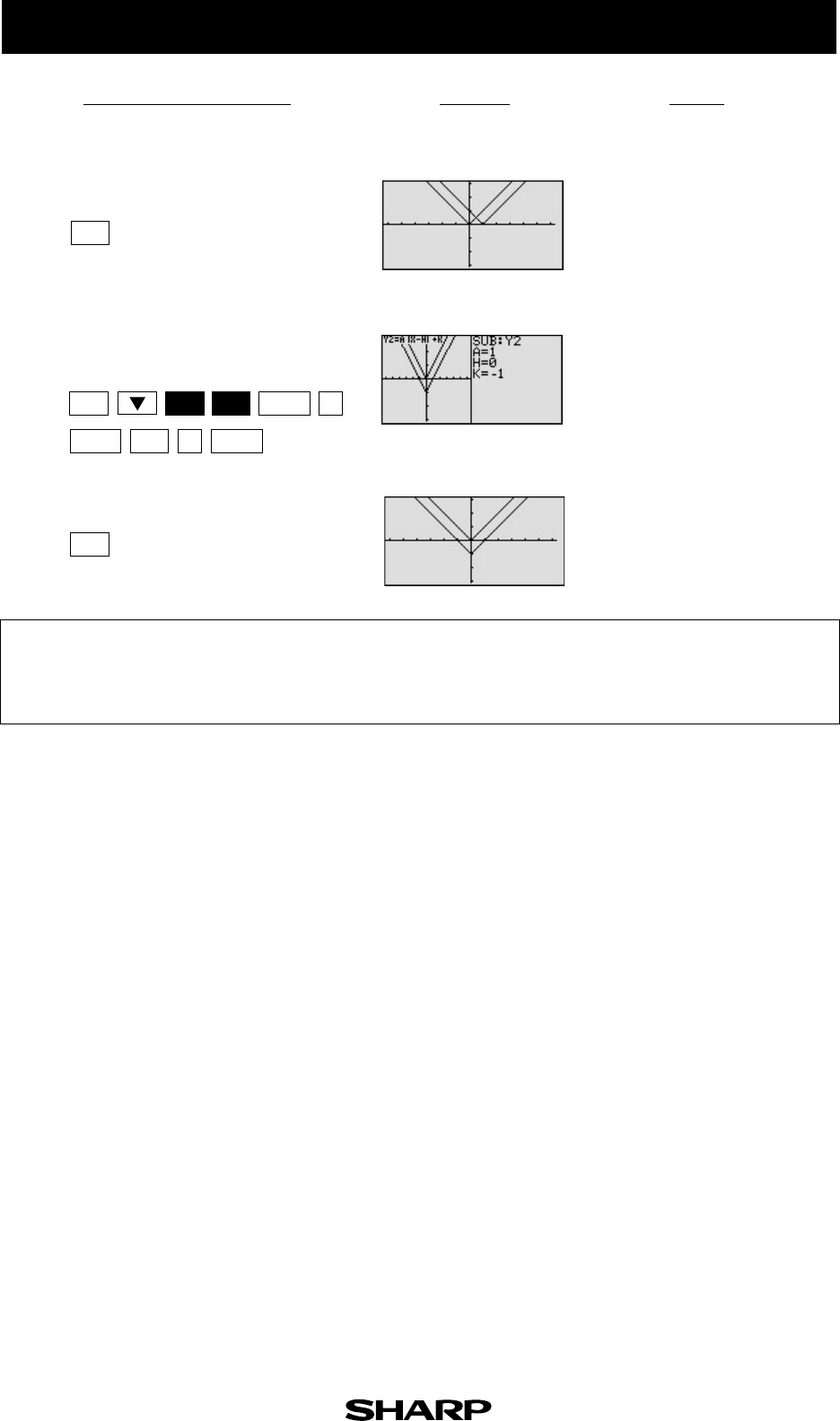
NotesStep & Key Operation
*Use either pen touch or cursor to operate.
Display
EL-9650/9600c Graphing Calculator
2-3View the graph.
2-5
Change the coefficients to graph
y =|x|-1.
2-4
View the graph.
The EL-9650/9600c shows absolute values with | |, just as written on paper, by using the
Equation editor. Use of the calculator allows various absolute value functions to be
graphed quickly and shows their characteristics in an easy-to-understand manner.
Notice that placing an h(>0)
within the standard form
y = a|x - h|+ k will move the
graph right h units on the x-
axis.
Notice that adding a k(>0)
within the standard form
y=a|x-h|+k will move the
graph up k units on the y-axis.
8-1
Y=
2nd F SUB ENTER
ENTER ENTER
1
1
(-)
GRAPH
GRAPH
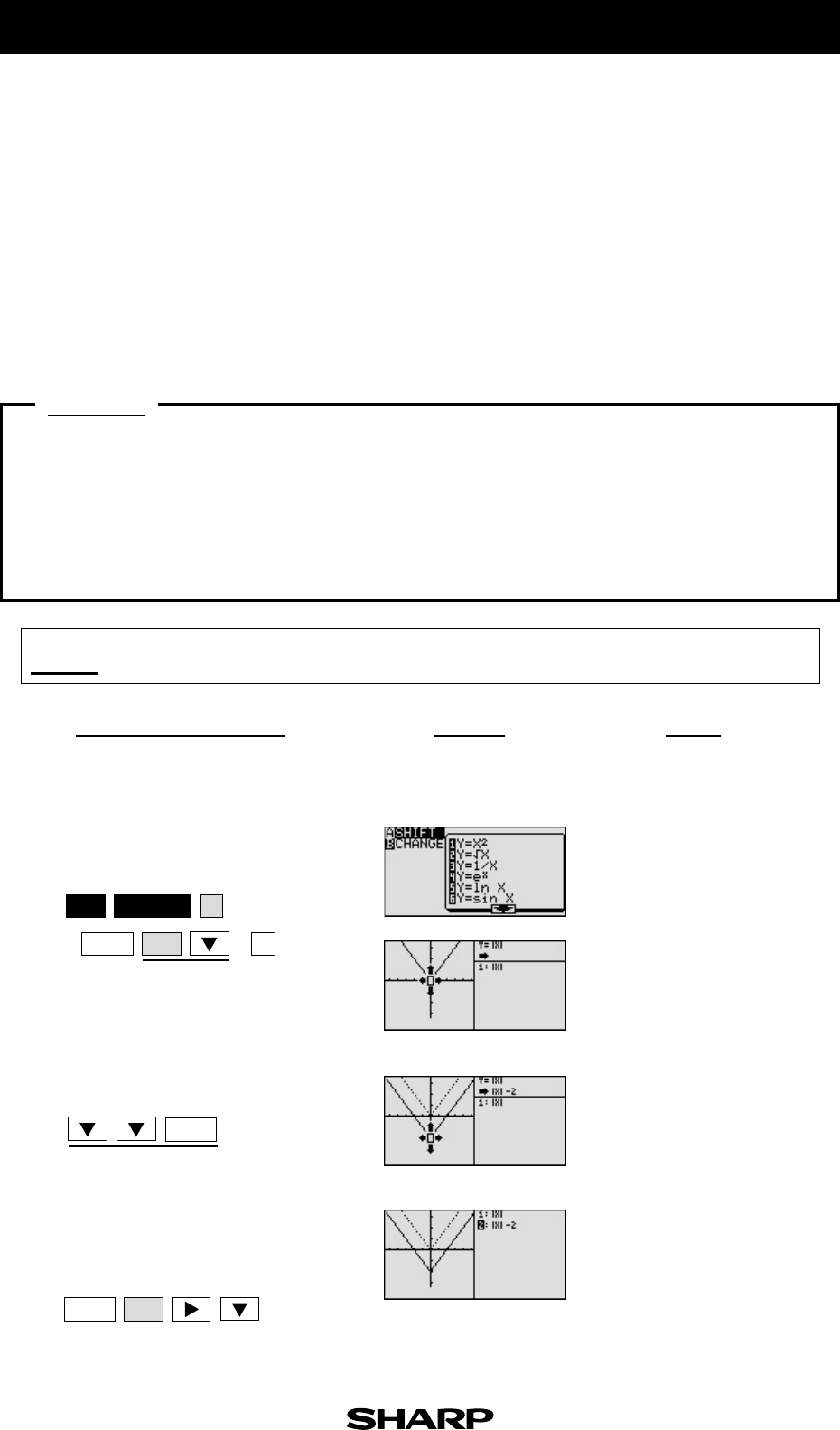
EL-9650/9600c/9450/9400 Graphing Calculator
8-2
There may be differences in the results of calculations and graph plotting depending on the setting.
Return all settings to the default value and delete all data.
NotesStep & Key Operation
(When using EL-9650/9600c)
*Use either pen touch or cursor to operate.
Display
(When using EL-9650/9600c)
Shifting a graph of Absolute Value Functions
The absolute value of a real number x is defined by the following:
|x| = x if x
≥
0
-x if x
≤
0
If n is a positive number, there are two solutions to the equation |f (x)| = n because there
are exactly two numbers with the absolute value equal to n: n and -n. The existence of two
distinct solutions is clear when the equation is solved graphically.
An absolute value function can be presented as y = a|x - h|+ k. The graph moves as the
changes of slope a, x-intercept h, and y-intercept k.
Move and change graphs of absolute value function y =|x| to check the relation
between the graphs and the values of coefficients.
Example
1. Move the graph y = |x| downward by 2 using the Shift feature.
2. Move the graph y = |x| to the right by 2 using the Shift feature.
3. Pinch the slope of y = |x| to 2 or minus using the Change feature.
1-2y =|x|changes to y = |x|-2
Move the graph downward by 2.
1-1Access the Shift feature.
Select y = |x|.
*
( * ) *
*
1-3Save the new graph and look at the
relationship of the function and the
graph.
The graph of the equation that
is highlighted is shown by a
solid line. Notice that the y-
intercept k in the standard
form y = a|x - h|+ k takes
charge of vertical movement
of the graph.
2nd F
SHIFT/CHANGE
ENTER
ENTER
ENTER
ALPHA
ALPHA
A
8
Before
Starting
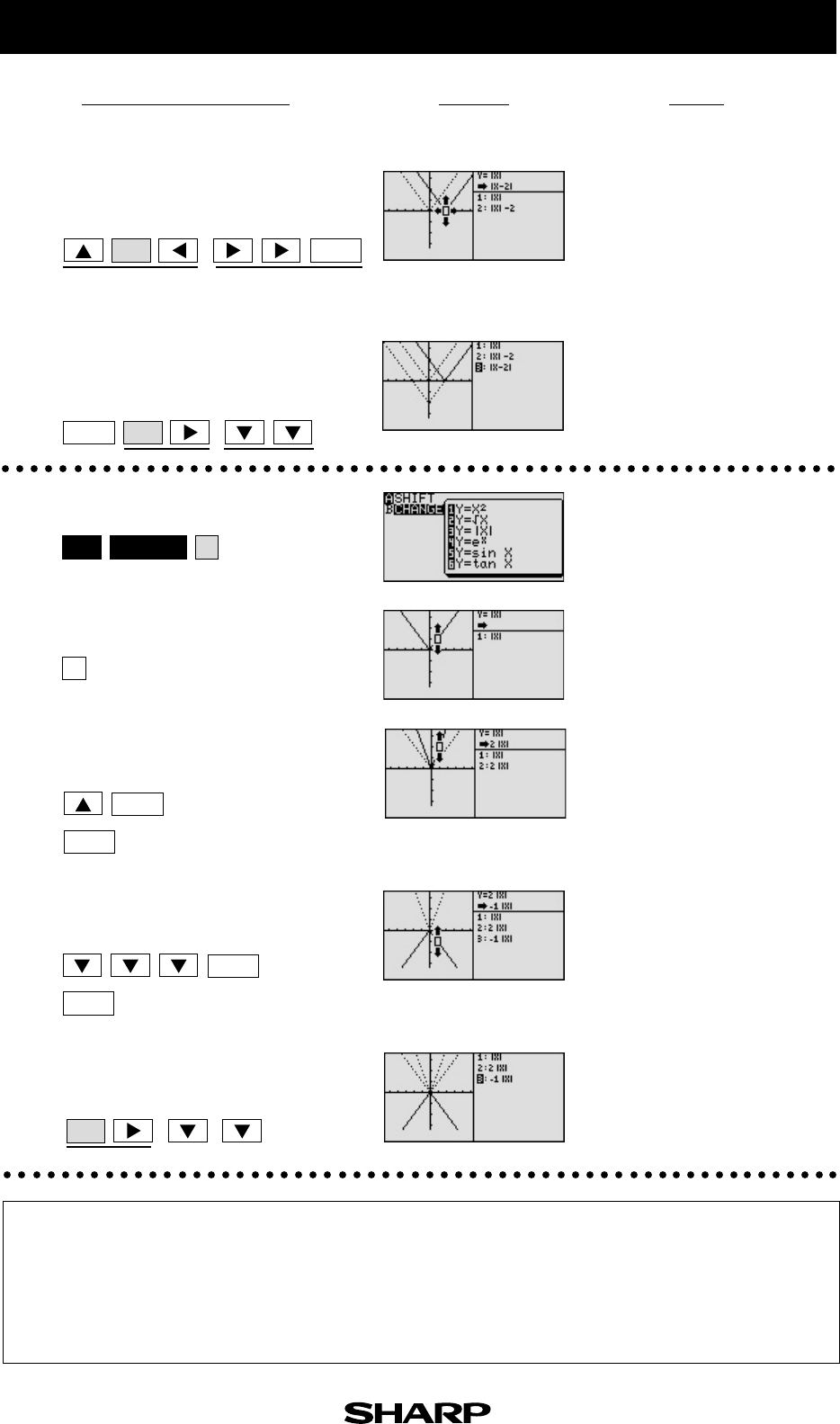
EL-9650/9600c/9450/9400 Graphing Calculator
NotesStep & Key Operation
(When using EL-9650/9600c)
*Use either pen touch or cursor to operate.
Display
(When using EL-9650/9600c)
y = |x| changes to y = |x-2|
2
-
1
Move the original graph to the right
by 2.
* *
3
-
1
Access the Change feature.
*
2
-2
Save the new graph and look at the
relationship of the function and the
graph.
* *
3
-
2
Select y = |x|.
*
3
-
3
Make the slope of the graph steeper.
Save the new graph.
y = |x|➞ y = 2|x|
3
-
4
Make the slope of the graph minus.
Save the new graph.
y = |x|➞ y = - |x|
3
-
5
Look at the relationship of the
function and the graph.
* * *
Notice that the coefficient a
in the standard form
y = a |x - h| + k takes
charge of changing the slope.
EL-9650/9600c/9450/9400 shows absolute values with | |, just as written on paper, by
using the Equation editor. Use of the calculator allows various absolute value functions
to be graphed quickly and shows their characteristics in an easy-to-understand manner.
The Shift/Change feature of the EL-9650/9600c/9450/9400 allows visual understanding
of how graph changes affect the form of absolute value functions.
Notice that the function h in
the standard form
y = a|x - h|+
k takes charge
of horizontal movement of
the graph.
8-2
ALPHA
ENTER
ENTER
ENTER
ENTER
3
2nd F
SHIFT/CHANGE
B
ENTER
ENTER
ALPHA
ALPHA
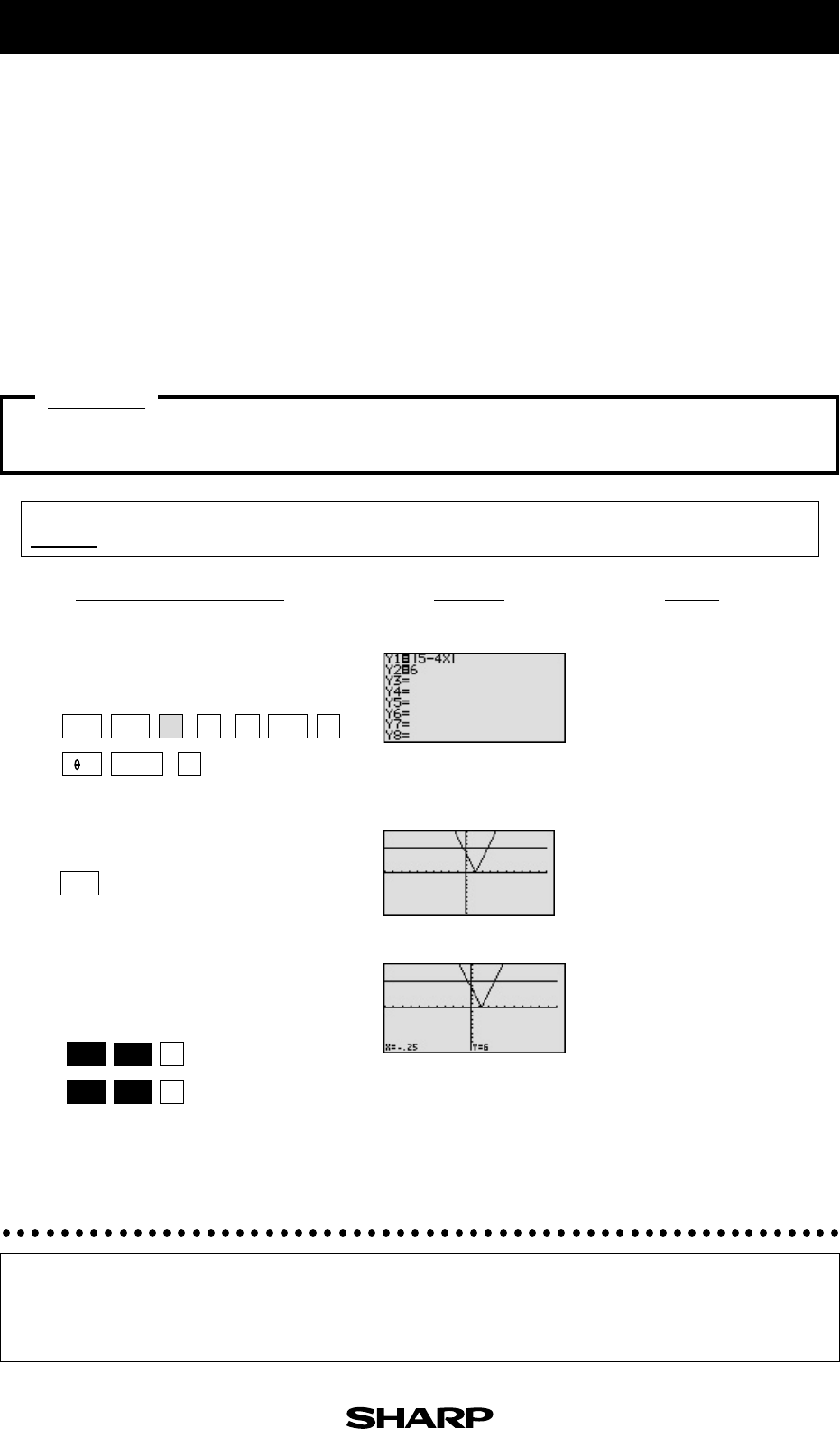
EL-9650/9600c/9450/9400 Graphing Calculator
8-3
There may be differences in the results of calculations and graph plotting depending on the setting.
Return all settings to the default value and delete all data.
NotesStep & Key Operation
(When using EL-9650/9600c)
*Use either pen touch or cursor to operate.
Display
(When using EL-9650/9600c)
Solving Absolute Value Equations
The absolute value of a real number x is defined by the following:
|x| = x if x
≥
0
-x if x
≤
0
If n is a positive number, there are two solutions to the equation |f (x)| = n because there
are exactly two numbers with the absolute value equal to n: n and -n. The existence of two
distinct solutions is clear when the equation is solved graphically.
Example
Solve an absolute value equation |5 - 4x| = 6
1Enter y = |5 - 4x| for Y1.
Enter y = 6 for Y2.
* *
*
2View the graph. There are two points of in-
tersection of the absolute
value graph and the hori-
zontal line y = 6.
3Find the points of intersection of
the two graphs and solve. The solution to the equation
|5 - 4x|= 6 consists of the two
values -0.25 and 2.75. Note
that although it is not as intu-
itively obvious, the solution
could also be obtained by
finding the x-intercepts of the
function y = |5x - 4| - 6.
*
*
The EL-9650/9600c/9450/9400 shows absolute values with | |, just as written
on paper, by using the Equation editor. The graphing feature of the calculator
shows the solution of the absolute value function visually.
GRAPH
Y=
MATH
B154
6
2
2
2nd F CALC
2nd F CALC
ENTER
—
X/
/T/n
Before
Starting
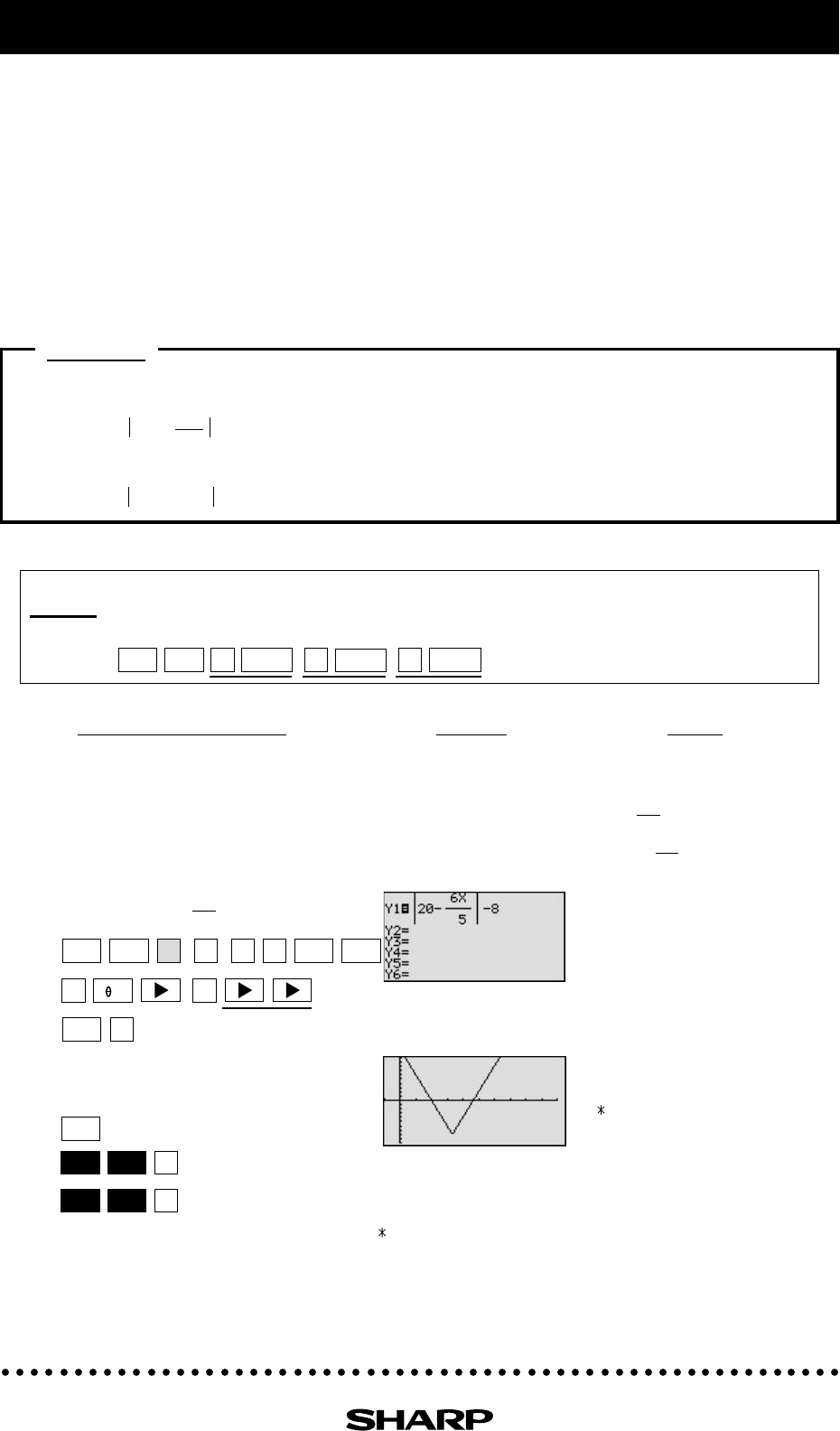
EL-9650/9600c/9450/9400 Graphing Calculator
8-4
There may be differences in the results of calculations and graph plotting depending on the setting.
Return all settings to the default value and delete all data.
Set viewing window to “-5< x <50,” and “-10< y <10” using Rapid Window feature to solve Q1.
* * *
NotesStep & Key Operation
(When using EL-9650/9600c)
*Use either pen touch or cursor to operate.
Display
(When using EL-9650/9600c)
Solving Absolute Value Inequalities
To solve an inequality means to find all values that make the inequality true. Absolute value
inequalities are of the form |
f (x)
|<
k,
|
f (x)
|
≤
k,
|
f (x)
|>
k,
or
|
f (x)
|
≥
k.
The graphical
solution to an absolute value inequality is found using the same methods as for normal
inequalities. The first method involves rewriting the inequality so that the right-hand side of
the inequality is 0 and the left-hand side is a function of x. The second method involves
graphing each side of the inequality as an individual function.
Solve absolute value inequalities in two methods.
Example
1-2Enter y = |20 - | - 8 for Y1.
* *
* *
1-1Rewrite the equation. |20 - |< 8
➞|20 - | - 8 < 0.
1-3View the graph, and find the
x-intercepts.
* ➞ x = 10, y = 0
* ➞ x = 23.33333334
y = 0.00000006 ( Note)
The intersections with the x-
axis are (10, 0) and (23.3, 0)
( Note: The value of y in the
x-intercepts may not appear
exactly as 0 as shown in the
example, due to an error
caused by approximate calcu-
lation.)
1-4Solve the inequality. Since the graph is below the
x-axis for x in between the
two x-intercepts, the solution
is 10 < x < 23.3.
6x
5
6x
5
1. Solve 20 - < 8 by rewriting the inequality so that the right-hand side of
the inequality is zero.
2. Solve 3.5x + 4 > 10 by shading the solution region.
6x
5
WINDOW
EZ333
ENTER ENTER ENTER
GRAPH
2nd F CALC
2nd F CALC
B520
6
8
5
5
5
Y=
MATH
—
—
a/b
6x
5
X/
/T/n
Before
Starting
vol.18.4̲10.4.layout.p65 02.10.28, 1:15 PMPage 2 AdobePageMaker6.5J/PPC
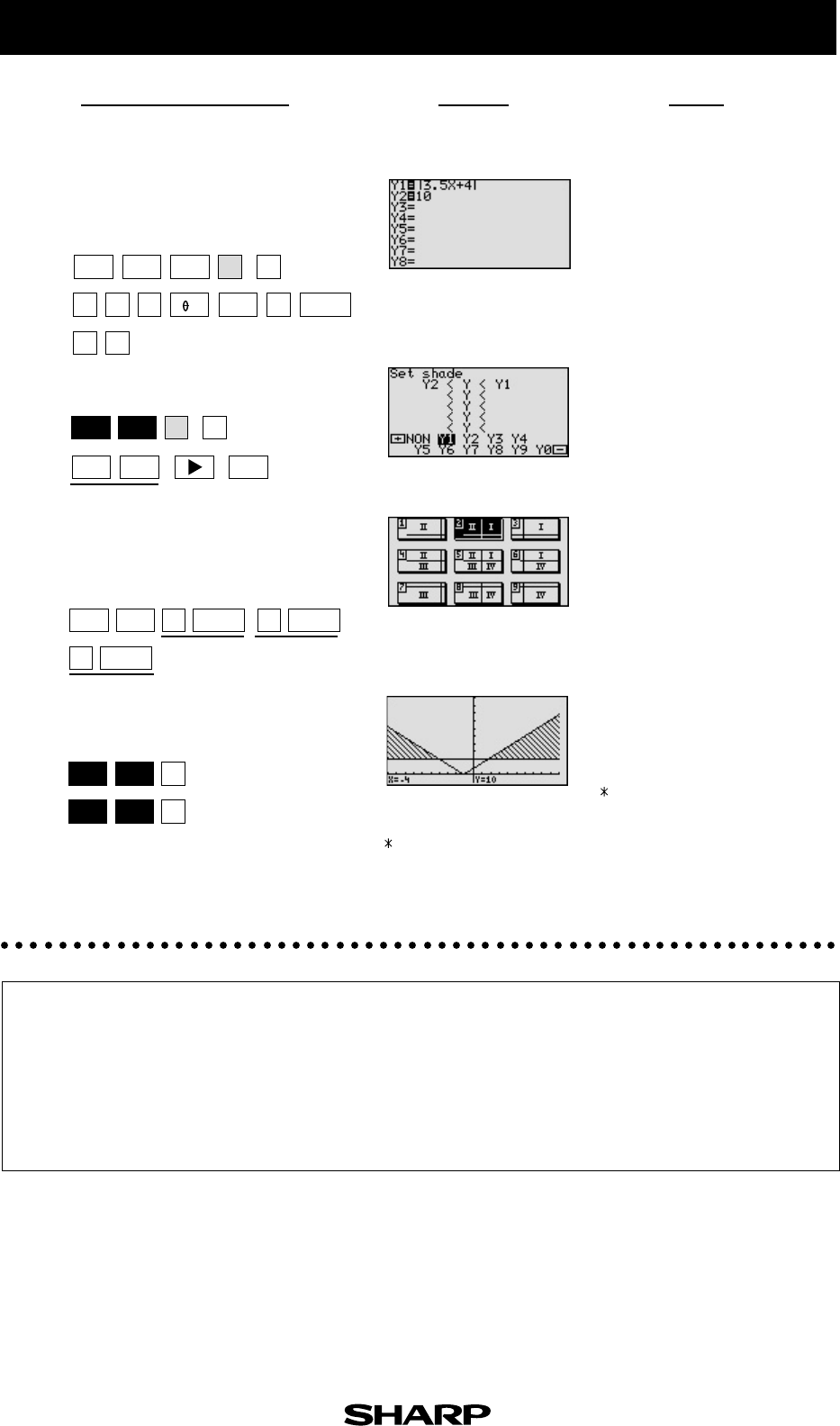
EL-9650/9600c/9450/9400 Graphing Calculator
NotesStep & Key Operation
(When using EL-9650/9600c)
*Use either pen touch or cursor to operate.
Display
(When using EL-9650/9600c)
8-4
2-1Enter the function
y =|3.5x + 4|for Y1.
Enter y = 10 for Y2.
* *
*
2-2
* *
* * *
Since the inequality you are
solving is Y1 > Y2, the solu-
tion is where the graph of Y2
is “on the bottom” and Y1 in
“on the top.”
Set up shading.
2-3
Set viewing window to “-10 < x <
10” and “-5 < y < 50” using Rapid
Window feature and view the graph.
* *
*
2
-
4
* ➞ x = -4, y = 10
* ➞ x = 1.714285714
y = 9.999999999 ( Note)
The intersections are (-4, 10)
and (1.7, 10.0). The solution
is all values of x such that
x <-4 or x >1.7.
( Note: The value of y in the
intersection of the two graphs
may not appear exactly as 10
as shown in the example, due
to an error caused by approxi-
mate calculation.)
Find the points of intersection.
Solve the inequality.
The EL-9650/9600c/9450/9400 shows absolute values with | |, just as written
on paper, by using the Equation editor. Graphical solution methods not only
offer instructive visualization of the solution process, but they can be applied to
inequalities that are often difficult to solve algebraically. The Shade feature is
useful to solve the inequality visually and the points of intersection can be
obtained easily.
Y= CL
MATH
+
2nd F
DRAW
2nd F
2nd F
CALC
CALC
EZ
WINDOW
ENTER
ENTER ENTER
ENTER
—— —
10
B1
354
G1
5
2
2
2
3
•
X/
/T/n
vol.18.4̲10.4.layout.p65 02.10.28, 1:15 PMPage 3 AdobePageMaker6.5J/PPC

EL-9650/9600c/9450/9400 Graphing Calculator
8-5
There may be differences in the results of calculations and graph plotting depending on the setting.
Return all settings to the default value and delete all data.
Notes
Step & Key Operation
(When using EL-9650/9600c)
*Use either pen touch or cursor to operate.
Display
(When using EL-9650/9600c)
Evaluating Absolute Value Functions
The absolute value of a real number x is defined by the following:
|x| = x if x
≥
0
-x if x
≤
0
Note that the effect of taking the absolute value of a number is to strip away the minus sign
if the number is negative and to leave the number unchanged if it is nonnegative.
Thus, |x|
≥
0 for all values of x.
Evaluate various absolute value functions.
Example
1. Evaluate |- 2(5-1)|
2. Is |-2+7| = |-2| + |7|?
Evaluate each side of the equation to check your answer.
Is |x + y| =|x|+ |y| for all real numbers x and y ?
If not, when will |x + y| = |x|+|y| ?
3. Is | | = ?
Evaluate each side of the equation to check your answer. Investigate with
more examples, and decide if you think |x / y|=|x|/|y|
6-9
1+3
1-1Access the home or computation
screen.
1-2Enter y = |-2(5-1)| and evaluate.
* *
2-1Evaluate|-2 + 7|. Evaluate|-2|+|7|. |-2 + 7| = 5, |-2| + |7| = 9
➞|-2 + 7| ≠ |-2| + |7|.
*
*
*
|6-9|
|1+3|
The solution is +8.
ENTER
MATH
MATH
MATH MATH
ENTER
ENTER
(-)
(-)
(-)
+
+
CL
(
)
—
B1
17
1
1
2
2
1
7
25
Before
Starting
vol.18.4̲10.4.layout.p65 02.10.28, 1:15 PMPage 4 AdobePageMaker6.5J/PPC
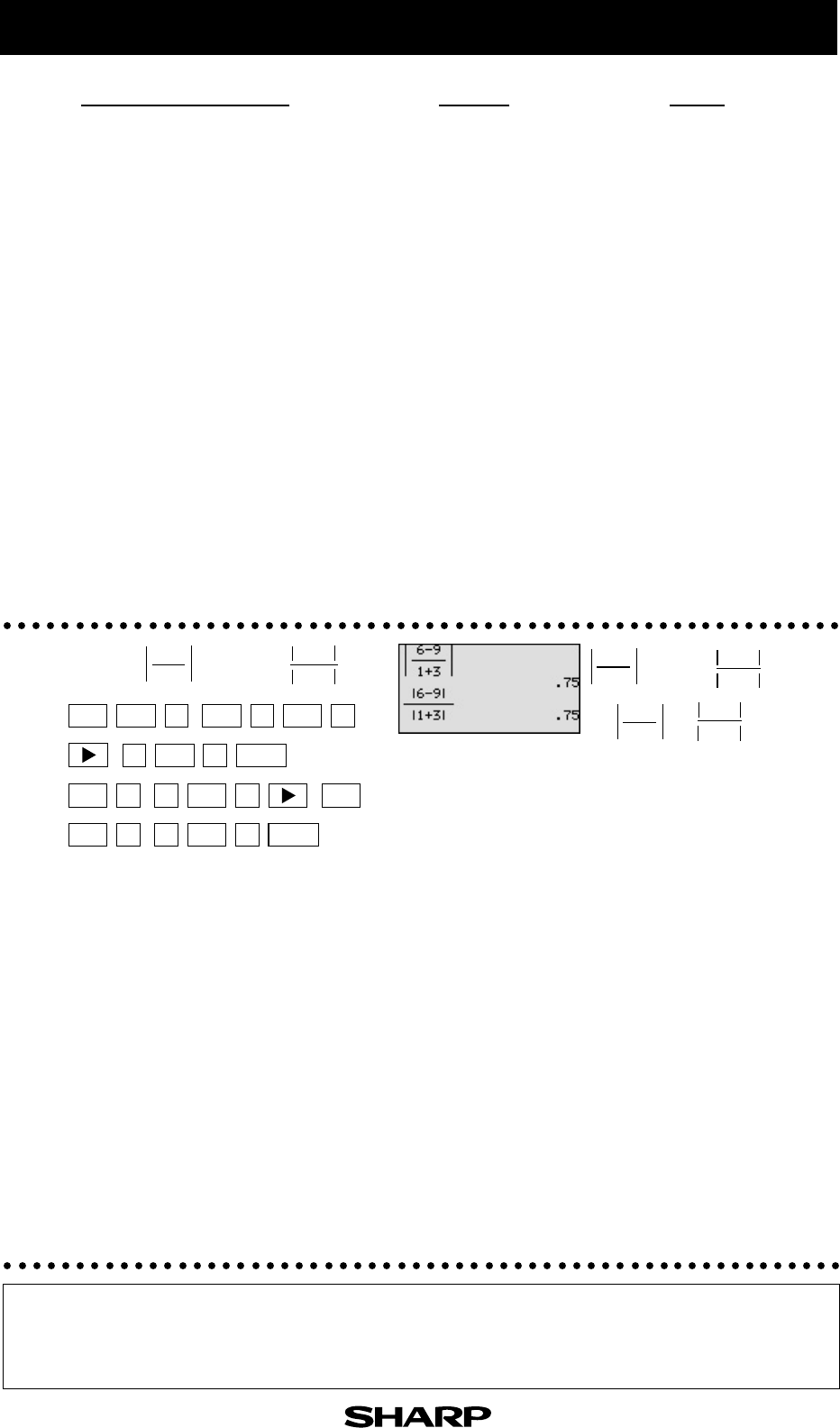
EL-9650/9600c/9450/9400 Graphing Calculator
NotesStep & Key Operation
(When using EL-9650/9600c)
*Use either pen touch or cursor to operate.
Display
(When using EL-9650/9600c)
= 0.75 , = 0 .75
8-5
2-2Is |x + y| = |x| +|y|? Think about
this problem according to the cases
when x or y are positive or negative.
If x
≥
0 and y
≥
0
[e.g.; (x, y) = (2,7)]
If x
≤
0 and y
≥
0
[e.g.; (x, y) = (-2, 7)]
If x
≥
0 and y
≤
0
[e.g.; (x, y) = (2, -7)]
If x
≤
0 and y
≤
0
[e.g.; (x, y) = (-2, -7)]
|x +y| = |2 + 7| = 9
|x|+|y| = |2| + |7| = 9
➞|x + y| = |x| + |y|.
|x +y| = |-2 + 7| = 5
|x|+|y| = |-2| + |7| = 9
➞|x + y| ≠ |x| + |y|.
|x +y| = |2-7| = 5
|x|+|y| = |2| + |-7| = 9
➞|x + y| ≠ |x| + |y|.
|x +y| = |-2-7| = 9
|x|+|y| = |-2| + |-7| = 9
3-1Evaluate . Evaluate .
3-2Is |x /y| = |x|/|y|?
Think about this problem according
to the cases when x or y are positive
or negative.
If x
≥
0 and y
≥
0
[e.g.; (x, y) = (2,7)]
If x
≤
0 and y
≥
0
[e.g.; (x, y) = (-2, 7)]
If x
≥
0 and y
≤
0
[e.g.; (x, y) = (2, -7)]
If x
≤
0 and y
≤
0
[e.g.; (x, y) = (-2, -7)]
|x /y| = |2/7| = 2/7
|x|/|y| = |2| /|7| = 2/7
➞|x /y| = |x| / |y|
|x /y| = |(-2)/7| = 2/7
|x|/|y| = |-2| /|7| = 2/7
➞|x /y| = |x| / |y|
|x /y| = |2/(-7)| = 2/7
|x|/|y| = |2| /|-7| = 2/7
➞|x /y| = |x| / |y|
|x /y| = |(-2)/-7| = 2/7
|x|/|y| = |-2| /|-7| = 2/7
➞|x /y| = |x| / |y|
The statement is true for all y ≠ 0.
*
*
* *
*
The EL-9650/9600c/9450/9400 shows absolute values with | |, just as written
on paper, by using the Equation editor. The nature of arithmetic of the absolute
value can be learned through arithmetical operations of absolute value functions.
6-9
1+3 6-9
1+3
6-9
1+3 6-9
1+3
6-9
1+3 6-9
1+3
➞ =
➞|x + y| = |x| + |y|.
Therefore |x +y|=|x|+|y|when x
≥
0 and y
≥
0,
and when x
≤
0 and y
≤
0.
CL
ENTER
a/b
MATH
ENTER
a/b
MATH
+
—
—
+
69
13
69
13
1
1
1
MATH
vol.18.4̲10.4.layout.p65 02.10.28, 1:15 PMPage 5 AdobePageMaker6.5J/PPC
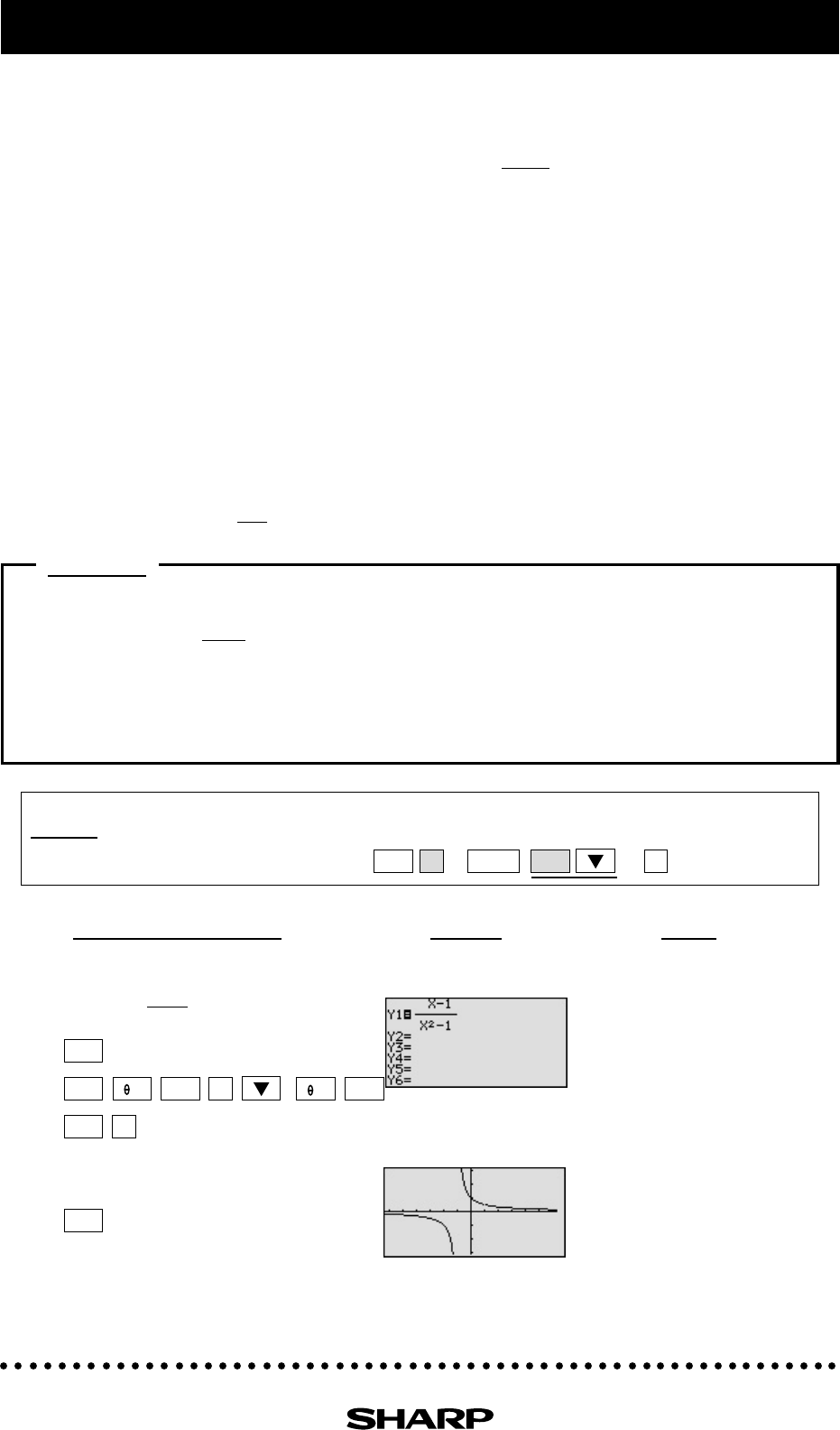
EL-9650/9600c/9450/9400 Graphing Calculator
9-1
Graphing Rational Functions
A rational function f (x) is defined as the quotient where p (x) and q (x) are two
polynomial functions such that q (x) ≠ 0. The domain of any rational function consists of all
values of x such that the denominator q (x) is not zero.
A rational function consists of branches separated by vertical asymptotes, and the values of
x that make the denominator q (x) = 0 but do not make the numerator p (x) = 0 are where
the vertical asymptotes occur. It also has horizontal asymptotes, lines of the form y = k (k,
a constant) such that the function gets arbitrarily close to, but does not cross, the horizontal
asymptote when |x| is large.
The x intercepts of a rational function f (x), if there are any, occur at the x-values that make
the numerator p (x), but not the denominator q (x), zero. The y-intercept occurs at f (0).
There may be differences in the results of calculations and graph plotting depending on the setting.
Return all settings to the default value and delete all data.
Set the zoom to the decimal window: * ( * ) *
NotesStep & Key Operation
(When using EL-9650/9600c)
*Use either pen touch or cursor to operate.
Display
(When using EL-9650/9600c)
Graph the rational function and check several points as indicated below.
Example
1.
Graph f (x) = .
2.
Find the domain of f (x), and the vertical asymptote of f (x).
3. Find the x- and y-intercepts of f
(x)
.
4. Estimate the horizontal asymptote of f
(x)
.
1-1Enter y = for Y1.
*
x - 1
x2 -1
1-2View the graph. The function consists of two
branches separated by the verti-
cal asymptote.
q (x)
p (x)
x-1
x2-1
GRAPH
Y=
A
ENTER
a/b
ALPHA
x2
ZOOM
—
7
1
1
—
X/
/T/n
X/
/T/n
Before
Starting
vol.18.4̲10.4.layout.p65 02.10.28, 1:15 PMPage 6 AdobePageMaker6.5J/PPC
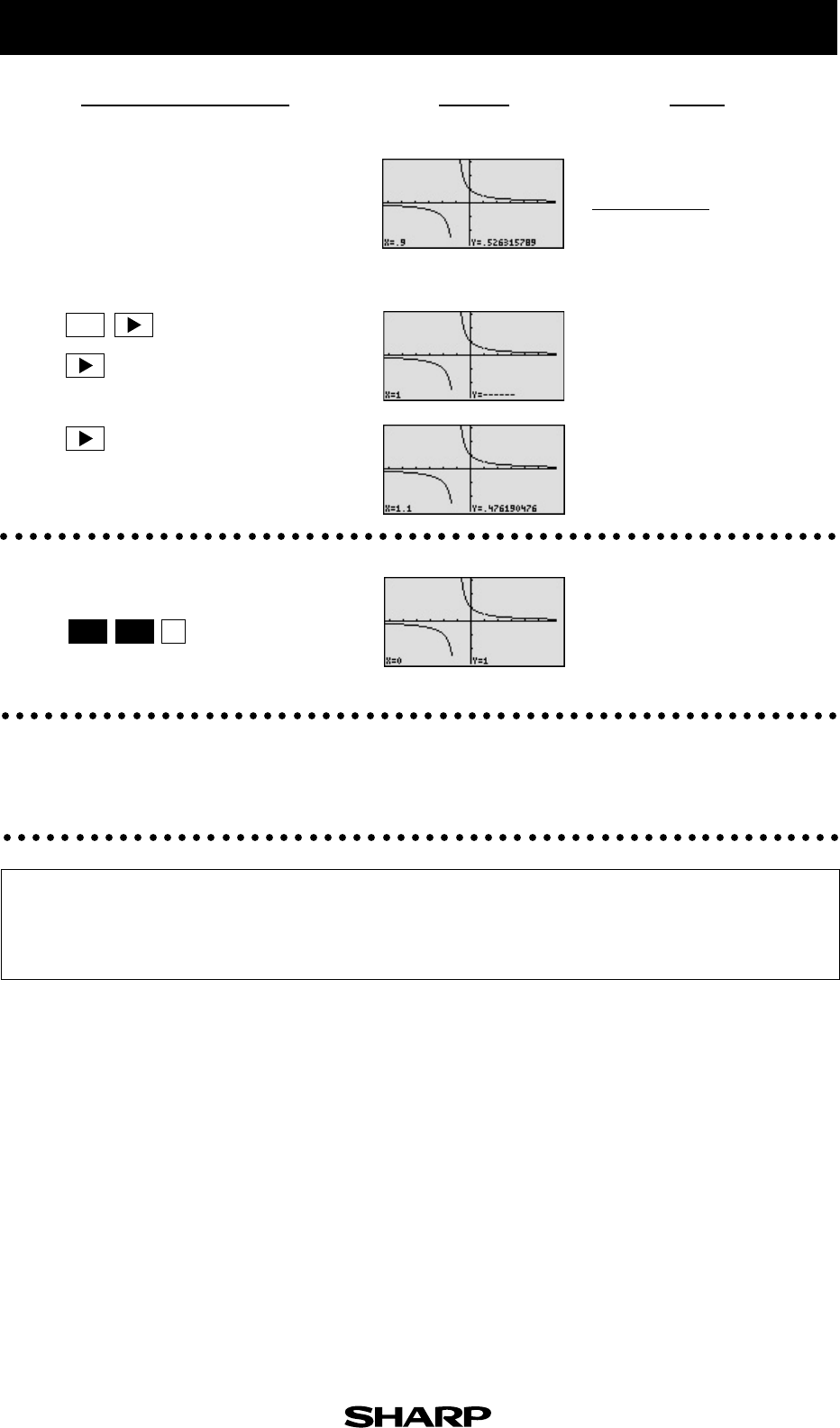
EL-9650/9600c/9450/9400 Graphing Calculator
NotesStep & Key Operation
(When using EL-9650/9600c)
*Use either pen touch or cursor to operate.
Display
(When using EL-9650/9600c)
The y-intercept is at (0 ,1). No-
tice that there are no x-inter-
cepts for the graph of f (x).
9-1
2Find the domain and the vertical
asymptote of f (x), tracing the
graph to find the hole at x = 1.
Since f (x) can be written as
, the domain
consists of all real numbers x
such that x ≠ 1 and x ≠ -1.
There is no vertical asymptote
where x = 1 since this value
of x also makes the numera-
tor zero. Next to the coordi-
nates x = 0.9, y = 0.52, see that
the calculator does not display
a value for y at x = 1 since 1
is not in the domain of this
rational function.
(repeatedly)
Find the x- and y-intercepts of f (x).
*
3
4Estimate the horizontal asymptote
of f (x).The line y = 0 is very likely a
horizontal asymptote of f (x).
The graphing feature of the EL-9650/9600c/9450/9400 can create the branches
of a rational function separated by vertical asymptote. The calculator allows
the points of intersection to be obtained easily.
x - 1
(x + 1)(x - 1)
TRACE
2nd F CALC
6
vol.18.4̲10.4.layout.p65 02.10.28, 1:15 PMPage 7 AdobePageMaker6.5J/PPC
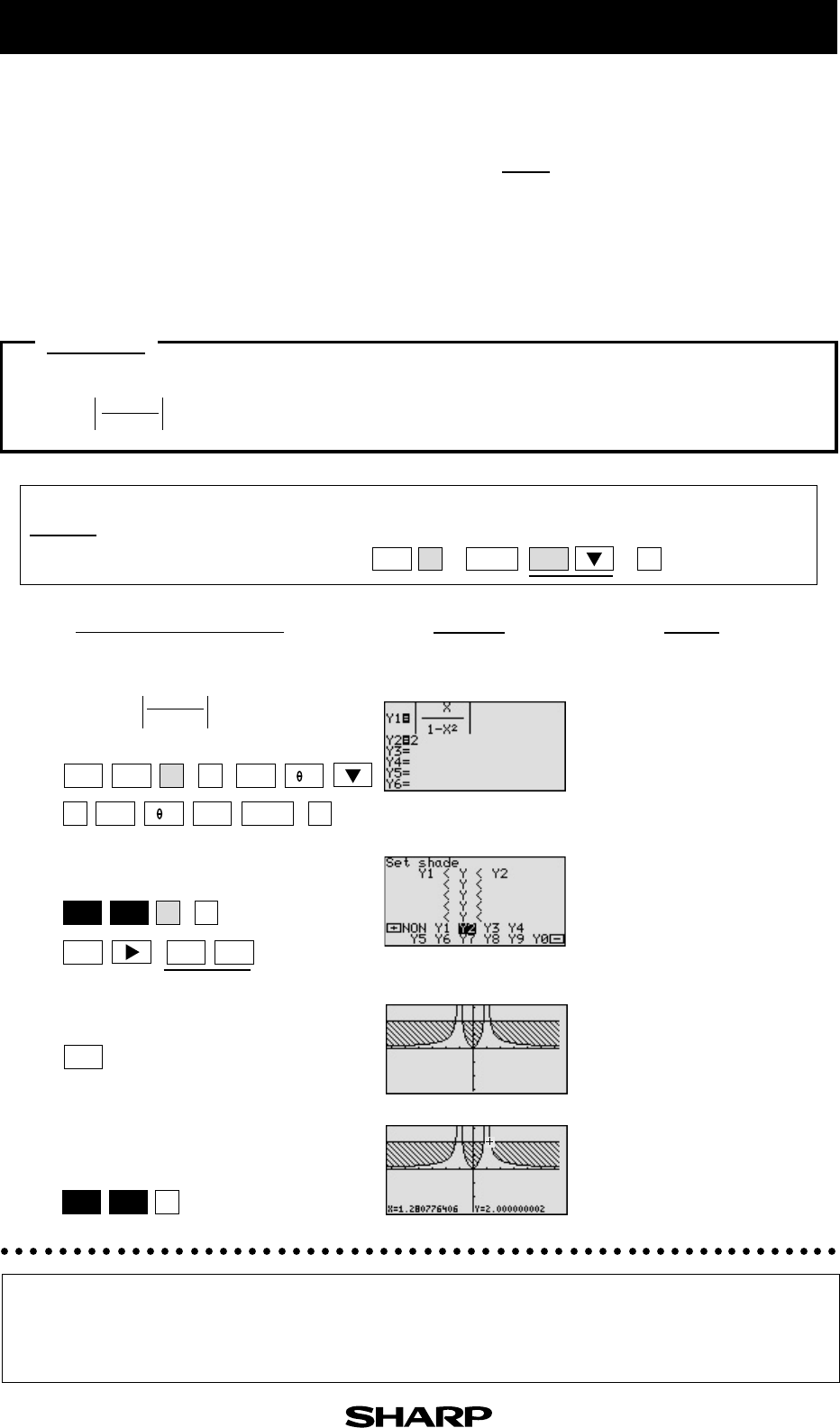
EL-9650/9600c/9450/9400 Graphing Calculator
9-2
There may be differences in the results of calculations and graph plotting depending on the setting.
Return all settings to the default value and delete all data.
Set the zoom to the decimal window: * ( * ) *
Notes
Step & Key Operation
(When using EL-9650/9600c)
*Use either pen touch or cursor to operate.
Display
(When using EL-9650/9600c)
Solving Rational Function Inequalities
A rational function f (x) is defined as the quotient where p (x) and q (x) are two
polynomial functions such that q (x) ≠ 0. The solutions to a rational function inequality can
be obtained graphically using the same method as for normal inequalities. You can find the
solutions by graphing each side of the inequalities as an individual function.
Solve a rational inequality.
Example
Solve
≤
2 by graphing each side of the inequality as an individual function.
* * *
*
1Enter y = for Y1. Enter y = 2
for Y2.
2Set up the shading. Since Y1 is the value “on the
bottom” (the smaller of the
two) and Y2 is the function
“on the top” (the larger of the
two), Y1 < Y < Y2.
* *
* *
3View the graph.
4Find the intersections, and solve the
inequality. The intersections are when
x = -1.3, -0.8, 0.8, and 1.3.
The solution is all values of
x such that x
≤
-1.3 or
-0.8
≤
x
≤
0.8 or x
≥
1.3.
* Do this four times
The EL-9650/9600c/9450/9400 allows the solution region of inequalities to be
indicated visually using the Shade feature. Also, the points of intersections
can be obtained easily.
x
1 - x2
x
1- x2
Y=
ENTER
a/b
A
ZOOM
MATH
7
B1
12
G1
2
GRAPH
2nd F CALC
2nd F
DRAW
—
ALPHA
x2
ENTER
———
X/
/T/n
X/
/T/n
q (x)
p (x)
Before
Starting
vol.18.4̲10.4.layout.p65 02.10.28, 1:15 PMPage 8 AdobePageMaker6.5J/PPC
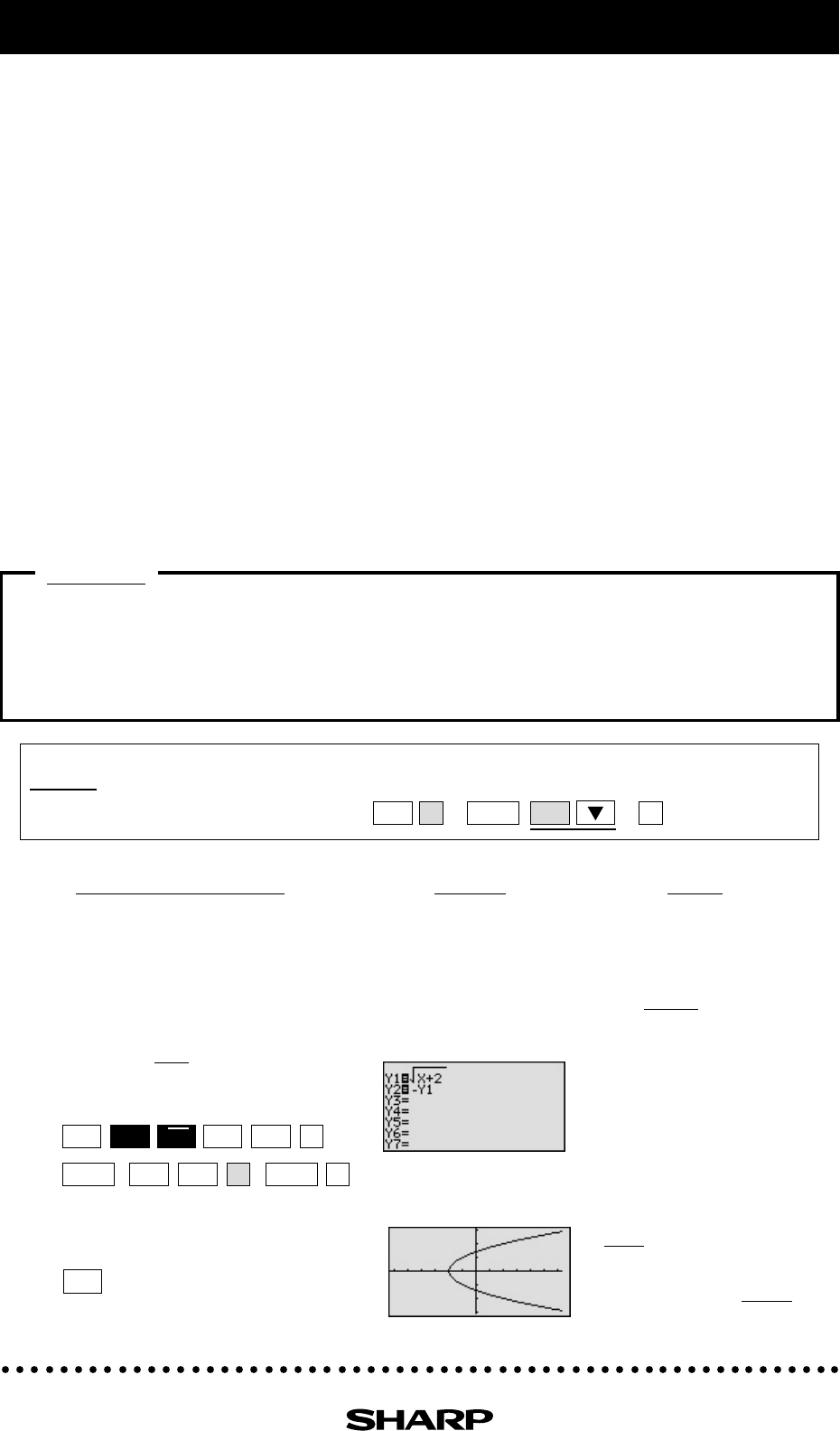
EL-9650/9600c/9450/9400 Graphing Calculator
10-1
The graph of the equation y =
√
x+ 2 is the "top half" of the
parabola and the graph of the
equation y = -
√
x + 2 gives
the "bottom half."
There may be differences in the results of calculations and graph plotting depending on the setting.
Return all settings to the default value and delete all data.
Set the zoom to the decimal window: * ( * ) *
Graphing Parabolas
The graphs of quadratic equations (y = ax2 + bx + c) are called parabolas. Sometimes the quadratic
equation takes on the form of x = ay2 + by + c.
There is a problem entering this equation in the calculator graphing list for two reasons:
a) it is not a function, and only functions can be entered in the Y= list locations,
b) the functions entered in the Y= list must be in terms of x, not y.
There are, however, two methods you can use to draw the graph of a parabola.
Method 1: Consider the "top" and "bottom" halves of the parabola as two different parts of the graph
because each individually is a function. Solve the equation of the parabola for y and enter the two parts
(that individually are functions) in two locations of the Y= list.
Method 2: Choose the parametric graphing mode of the calculator and enter the parametric equations
of the parabola. It is not necessary to algebraically solve the equation for y. Parametric representations
are equation pairs x = F(t), y = F(t) that have x and y each expressed in terms of a third parameter, t.
Graph a parabola using two methods.
Example
1. Graph the parabola x = y2 -2 in rectangular mode.
2. Graph the parabola x = y2 -2 in parametric mode.
1-1Solve the equation for y.
1-2
* * *
x = y2 -2
x + 2 = y2
y =
√
x + 2
Enter y =
√
x+2 for Y1 and enter
y = -Y1 for Y2.
1-3View the graph.
+
–
ENTER
A
ZOOM
7
ALPHA
GRAPH
ENTERENTER
2
1A
(-)
Y=
X
/
θθ
θθ
θ
/
T
/
n
+
VARS
2nd F √
Before
Starting
NotesStep & Key Operation
(When using EL-9650/9600c)
*Use either pen touch or cursor to operate.
Display
(When using EL-9650/9600c)
vol.18.4̲10.4.layout.p65 02.10.28, 1:15 PMPage 10 AdobePageMaker6.5J/PPC
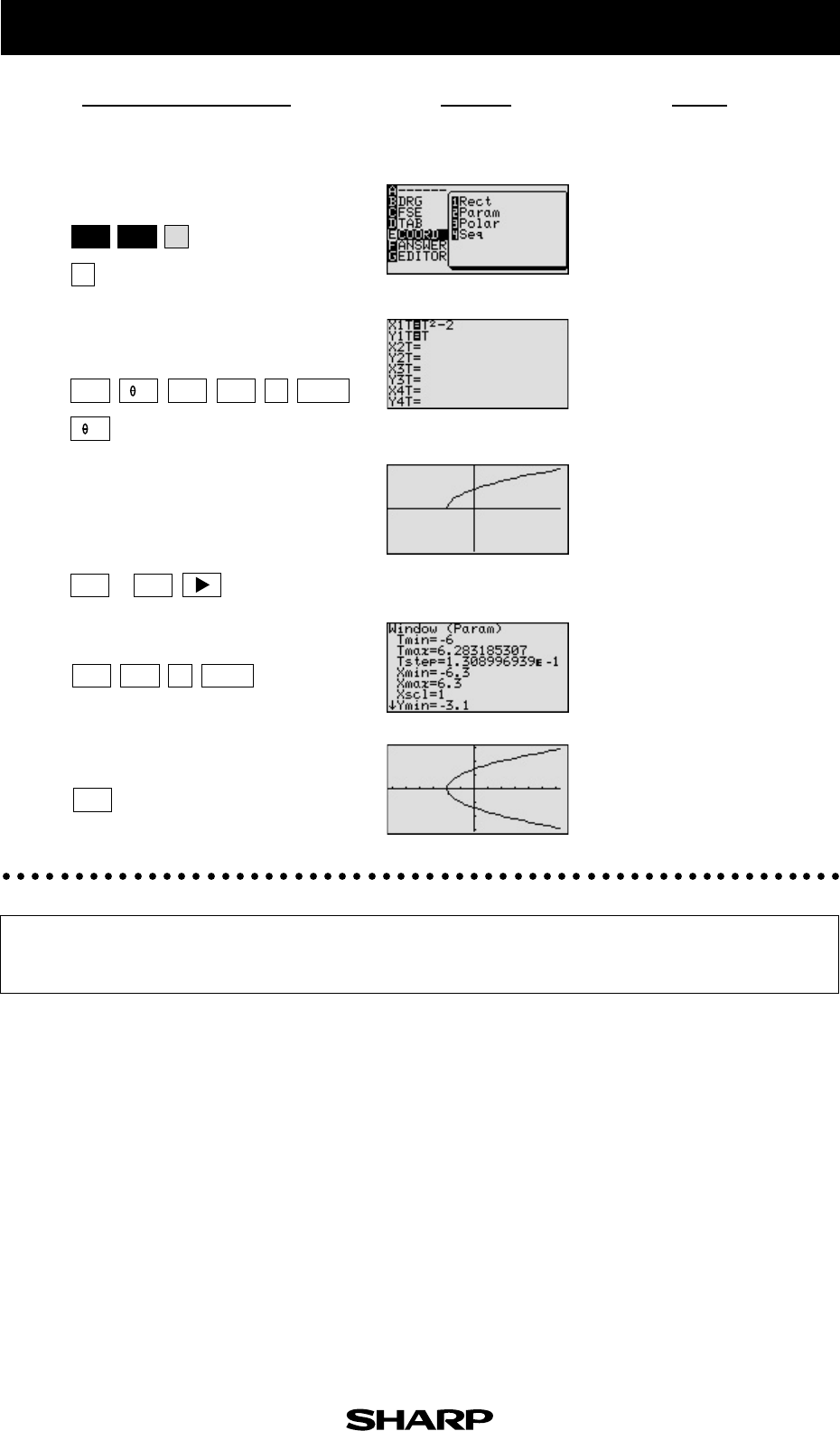
EL-9650/9600c/9450/9400 Graphing Calculator
NotesStep & Key Operation
(When using EL-9650/9600c)
*Use either pen touch or cursor to operate.
Display
(When using EL-9650/9600c)
2-1Change to parametric mode.
*
*
2-2Rewrite x = y2 -2 in parametric form.
Enter X1T = T2 -2 and Y1T = T. Let y = T and substitute in x
= y2 - 2, to obtain x = T2- 2.
*
2-3View the graph. Consider why only
half of the parabola is drawn.
(To understand this, use Trace fea-
ture.)
The graph starts at T =0 and
increases. Since the window
setting is T ≥ 0, the region T
< 0 is not drawn in the graph.
( )
2-4Set Tmin to -6.
*
2-5View the complete parabola.
The calculator provides two methods for graphing parabolas, both of which
are easy to perform.
10-1
GRAPH
GRAPH
Y=
E
(-)
ENTER
x2
WINDOW
TRACE
—
2
2
6
ENTER
2nd F
SET UP
X/
/T/n
X/
/T/n
vol.18.4̲10.4.layout.p65 02.10.28, 1:16 PMPage 11 AdobePageMaker6.5J/PPC
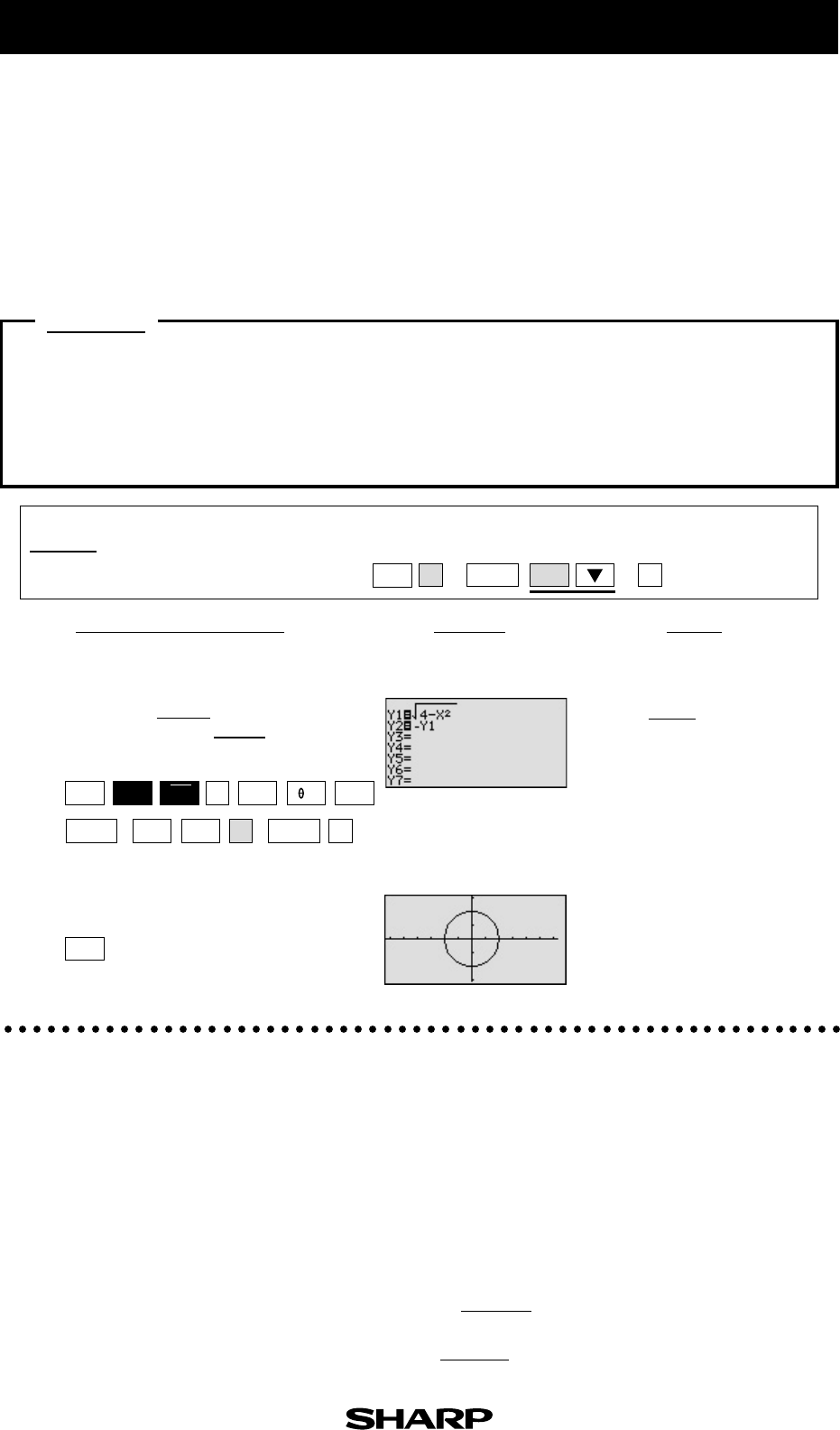
EL-9650/9600c/9450/9400 Graphing Calculator
10-2
Solve the equation for y.
Enter y = √ 4 - x2 for Y1 (the top
half). Enter y = -√ 4 - x2 for Y2.
x2 - 2x + y2 + 4y = 2
x2-2x+y2+4y+4=2+4
x2 - 2x + (y+2)2 = 6
(y+2)2 = 6 -x2 + 2x
y+2 =
±
√6-x2+2x
y =
±
√6-x2+2x -2
There may be differences in the results of calculations and graph plotting depending on the setting.
Return all settings to the default value and delete all data.
Set the zoom to the decimal window: * ( * ) *
Graphing Circles
The standard equation of a circle of radius r that is centered at a point (h, k) is (x - h)2 +
(y - k)2 = r2. In order to put an equation in standard form so that you can graph in
rectangular mode, it is necessary to solve the equation for y. You therefore need to use the
process of completing the square.
Graph the circles in rectangular mode. Solve the equation for y to put it in the
standard form.
Example
1. Graph x2 + y2 = 4.
2. Graph x2 - 2x + y2 + 4y = 2.
1-1
* * *
2-1Solve the equation for y,
completing the square. Place all variable terms on the
left and the constant term on
the right-hand side of the
equation.
Complete the square on the
y-term.
Express the terms in y as a
perfect square.
Leave only the term involving
y on the left hand side.
Take the square root of both
sides.
Solve for y.
y2 = 4 - x2
y =
√4 - x2
1-2View the graph. This is a circle of radius r ,
centered at the origin.
ENTER
A
ZOOM
7
ALPHA
ENTERENTER
1
4
A
(-)
Y=
VARS
2nd F √
x2
—
GRAPH
X/
/T/n
+
–
Before
Starting
NotesStep & Key Operation
(When using EL-9650/9600c)
*Use either pen touch or cursor to operate.
Display
(When using EL-9650/9600c)
vol.18.4̲10.4.layout.p65 02.10.28, 1:16 PMPage 12 AdobePageMaker6.5J/PPC
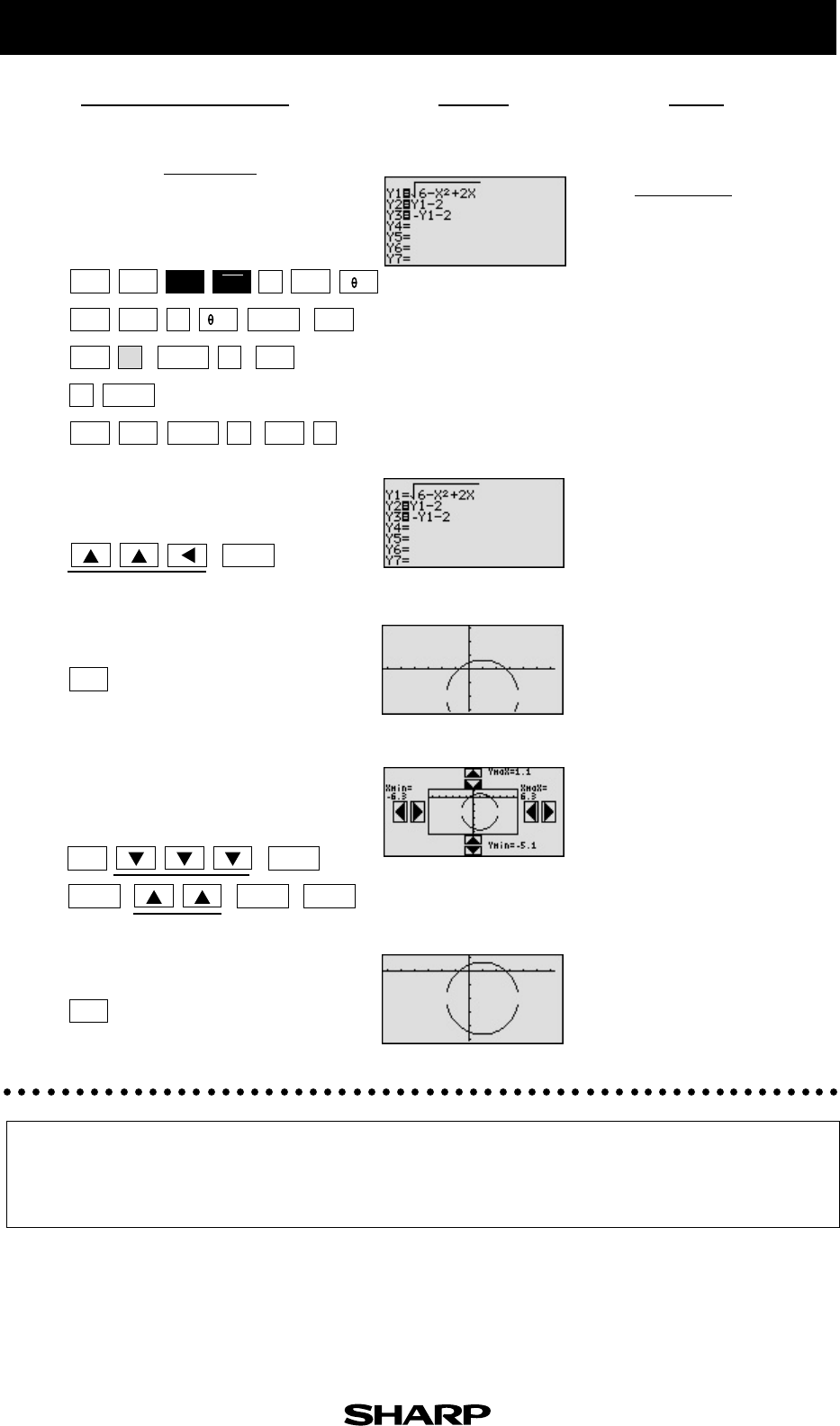
EL-9650/9600c/9450/9400 Graphing Calculator
NotesStep & Key Operation
(When using EL-9650/9600c)
*Use either pen touch or cursor to operate.
Display
(When using EL-9650/9600c)
2-2
*
* *
*
*
Enter y =
√
6 - x2 + 2x for Y1,
y = Y1 - 2 for Y2, and y = -Y1 -2 for
Y3.
Notice that if you enter
y =
√
6 - x2 + 2x - 2 for Y1
and y = - Y1 for Y2, you will
not get the graph of a circle
because the “±” does not go
with the “-2”.
2-3
* *
"Turn off" Y1 so that it will not
graph. Notice that “=” for Y1 is no
longer darkened. You now
have the top portion and the
bottom portion of the circle
in Y2 and Y3.
2-4View the graph.
2-5
* *
* * * *
Adjust the screen to see the bottom
part of the circle using the Rapid
feature.
2-6View the graph in the new window.
Graphing circles can be performed easily on the calculator display. Also,
the Rapid Zoom feature of the EL-9650/9600c/9450/9400 allows shifting and
adjusting display area (window) of a graph easily.
Wait until the graph is dis-
played after each operation.
(It takes few seconds to
graph)
10-2
GRAPH
GRAPH
ENTER ENTER ENTER
ENTER
EZ
ENTER
Y= CL 6
(-)
+
—
VARS
ENTER
CL
ENTER
ENTER
ENTER
VARS
—
—
2
A1
2
12
x2
2nd F
X/
/T/n
X/
/T/n
√
vol.18.4̲10.4.layout.p65 02.10.28, 1:16 PMPage 13 AdobePageMaker6.5J/PPC
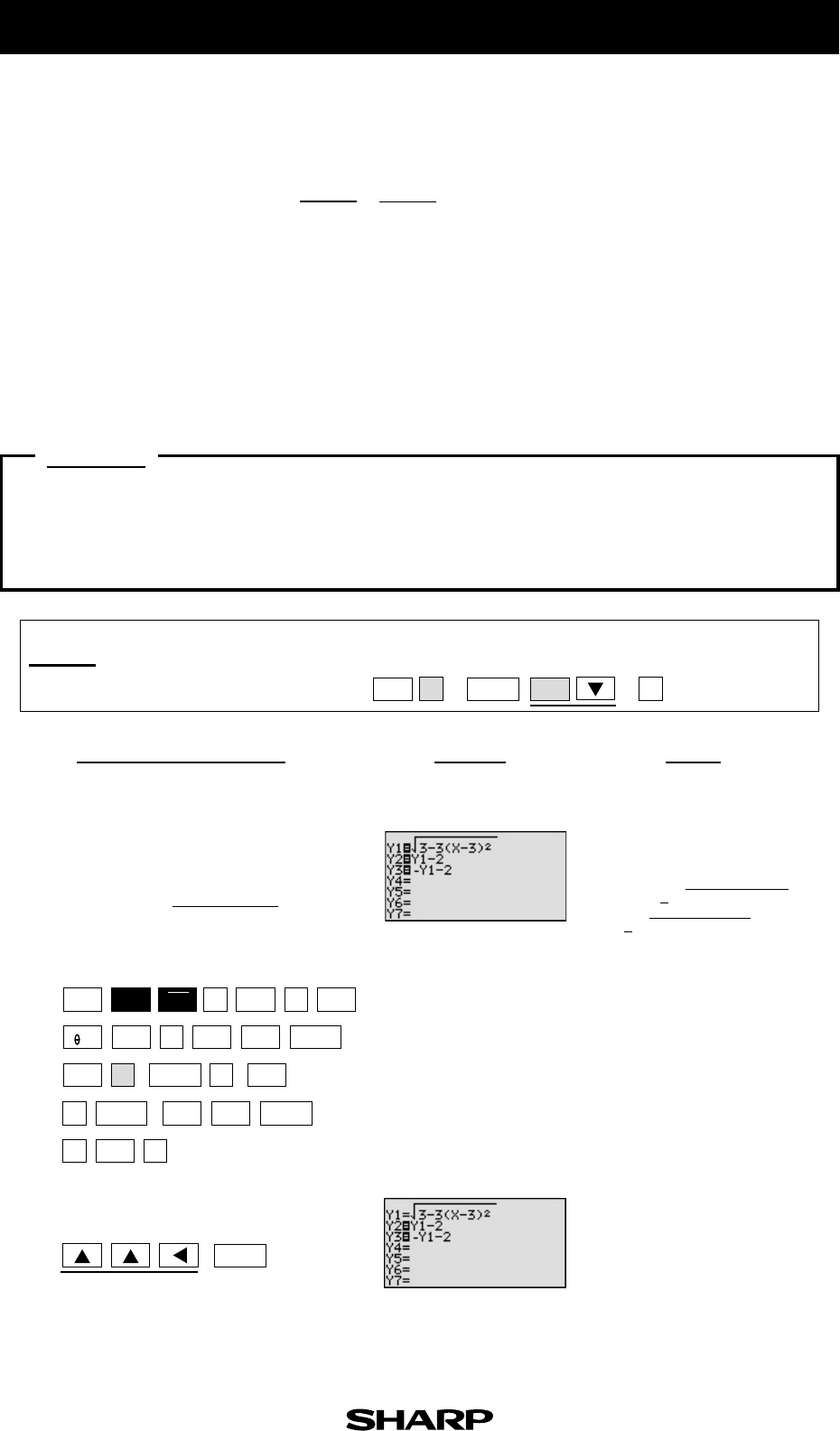
EL-9650/9600c/9450/9400 Graphing Calculator
10-3
Enter Y1 =
√
3 - 3(x - 3)2
Y2 = Y1 - 2
Y3 = -Y1 -2
There may be differences in the results of calculations and graph plotting depending on the setting.
Return all settings to the default value and delete all data.
Set the zoom to the decimal window: * ( * ) *
NotesStep & Key Operation
(When using EL-9650/9600c)
*Use either pen touch or cursor to operate.
Display
(When using EL-9650/9600c)
Graph an ellipse in rectangular mode. Solve the equation for y to put it in the
standard form.
Example
Graph the ellipse 3(x -3)2 + (y + 2)2 = 3
Graphing Ellipses
The standard equation for an ellipse whose center is at the point (h, k) with major and
minor axes of length a and b is + = 1.
There is a problem entering this equation in the calculator graphing list for two reasons:
a) it is not a function, and only functions can be entered in the Y = list locations.
b) the functions entered in the Y = list locations must be in terms of x, not y.
To draw a graph of an ellipse, consider the “top” and “bottom” halves of the ellipse as two
different parts of the graph because each individual is a function. Solve the equation of the
ellipse for y and enter the two parts in two locations of the Y = list.
(x - h)2
a2(y - k)2
b2
1Solve the equation for y, completing
the square.
*
* *
*
2Turn off Y1 so that it will not graph.
* *
ENTER
A
ZOOM
7
ALPHA
Y= 3
(-)
—
VARS
ENTER
ENTER
ENTERENTER
VARS
—
—
3
A
3
1
2
x2
2nd F √
ENTER
(
)
3(x - 3)2 + (y + 2)2 = 3
(y + 2)2 = 3 - 3(x - 3)2
y + 2 =
√
3 - 3(x - 3)2
y =
√
3 - 3(x - 3)2 - 2
+
X/
/T/n
1—2
+
Before
Starting
vol.18.4̲10.4.layout.p65 02.10.28, 1:16 PMPage 14 AdobePageMaker6.5J/PPC
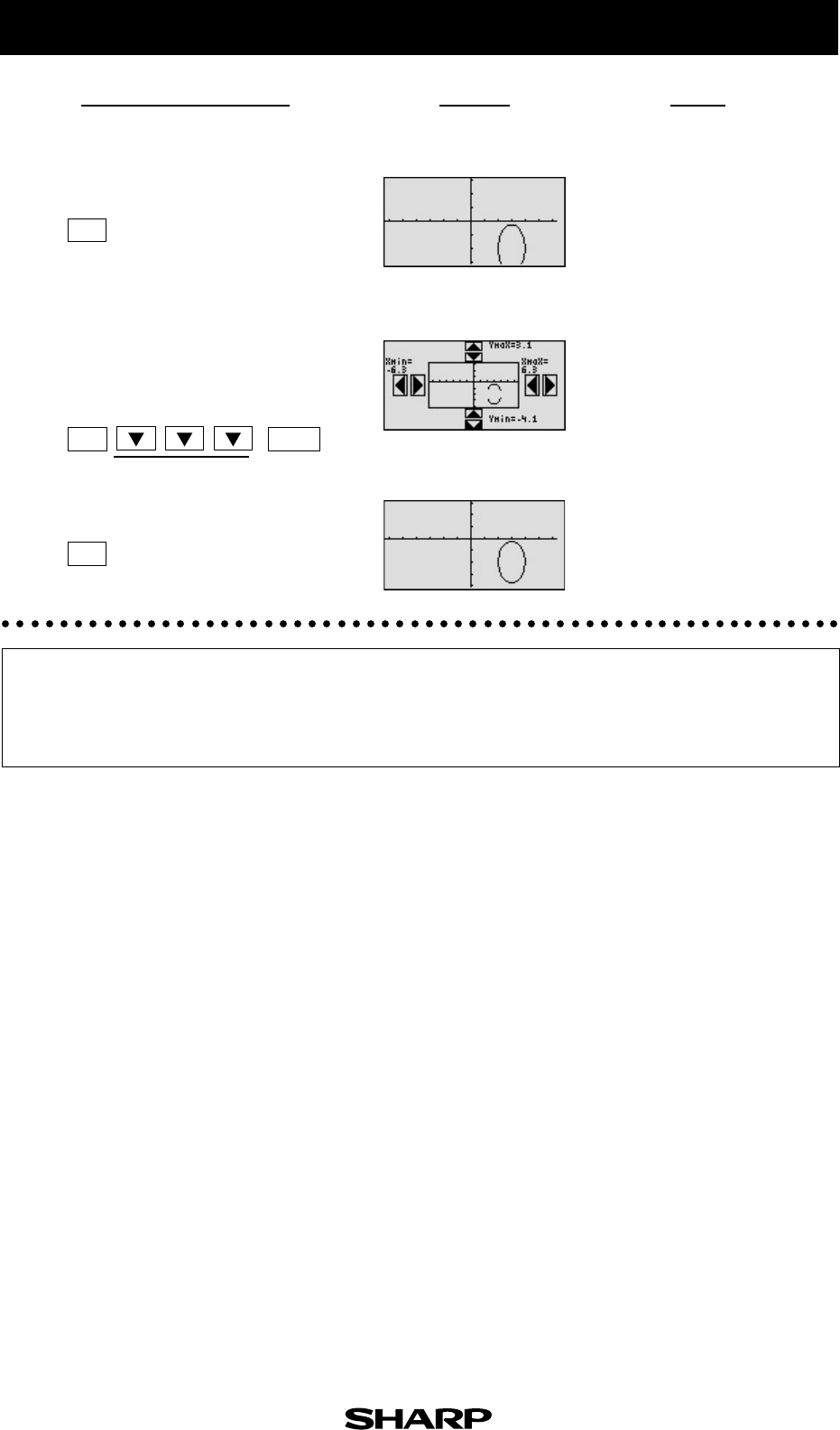
EL-9650/9600c/9450/9400 Graphing Calculator
NotesStep & Key Operation
(When using EL-9650/9600c)
*Use either pen touch or cursor to operate.
Display
(When using EL-9650/9600c)
4Adjust the screen to see the bottom
part of the ellipse using the Rapid
Zoom feature.
* *
3View the graph.
5View the graph in the new window.
Graphing an ellipse can be performed easily on the calculator display. In
addition to the Zoom-in/Zoom-out features, the EL-9650/9600c/9450/9400 have
the Rapid Zoom feature to adjust the display easily.
Wait until the graph is dis-
played after each operation.
(It takes few seconds to
graph)
10-3
GRAPH
GRAPH
ENTER
EZ
vol.18.4̲10.4.layout.p65 02.10.28, 1:16 PMPage 15 AdobePageMaker6.5J/PPC
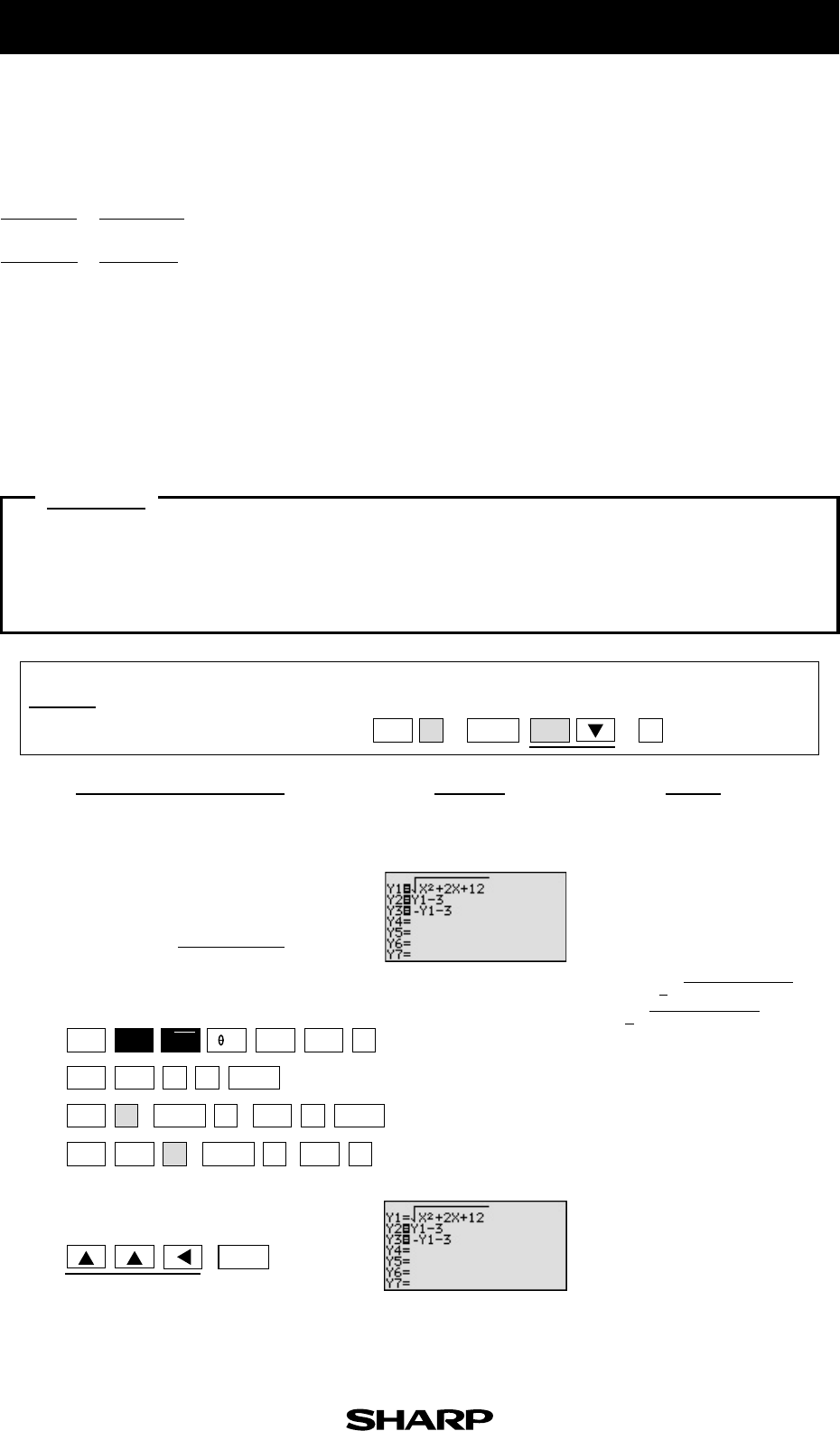
EL-9650/9600c/9450/9400 Graphing Calculator
10-4
There may be differences in the results of calculations and graph plotting depending on the setting.
Return all settings to the default value and delete all data.
Set the zoom to the decimal window: * ( * ) *
NotesStep & Key Operation
(When using EL-9650/9600c)
*Use either pen touch or cursor to operate.
Display
(When using EL-9650/9600c)
Graph a hyperbola in rectangular mode. Solve the equation for y to put it in the
standard form.
Example
Graph the hyperbola x2 + 2x - y2 - 6y + 3 = 0
Graphing Hyperbolas
The standard equation for a hyperbola can take one of two forms:
- = 1 with vertices at ( h
±
a, k ) or
- = 1 with vertices at ( h, k
±
b ).
There is a problem entering this equation in the calculator graphing list for two reasons:
a) it is not a function, and only functions can be entered in the Y= list locations.
b) the functions entered in the Y= list locations must be in terms of x, not y.
To draw a graph of a hyperbola, consider the “top” and “bottom” halves of the hyperbola
as two different parts of the graph because each individual is a function. Solve the equation
of the hyperbola for y and enter the two parts in two locations of the Y= list.
2Turn off Y1 so that it will not graph.
* *
1Solve the equation for y completing
the square.
*
* * *
* *
x2 + 2x - y2 -6y = -3
x2 + 2x - (y2 + 6y + 9) = -3 -9
x2 + 2x - (y +3)2 = -12
(y + 3)2 = x2 + 2x + 12
y + 3 =
√
x2 + 2x + 12
y =
√
x2 + 2x + 12 - 3
( y - k )2
b2
( y - h)2
a2
( x - h )2
a2
( x - k )2
b2
+
+
ENTER
A
ZOOM
7
ALPHA
ENTER
ENTER
ENTER ENTER
ENTER
Y=
A
2
x2
2nd F
A
12
13
13(-)
+
—
VARS
X
/
θθ
θθ
θ
/
T
/
n
+
VARS
—
X/
/T/n
Enter Y1 =
√
x2 + 2x + 12
Y2 = Y1 -3
Y3 = -Y1 -3
√
Before
Starting
vol.18.4̲10.4.layout.p65 02.10.28, 1:16 PMPage 16 AdobePageMaker6.5J/PPC
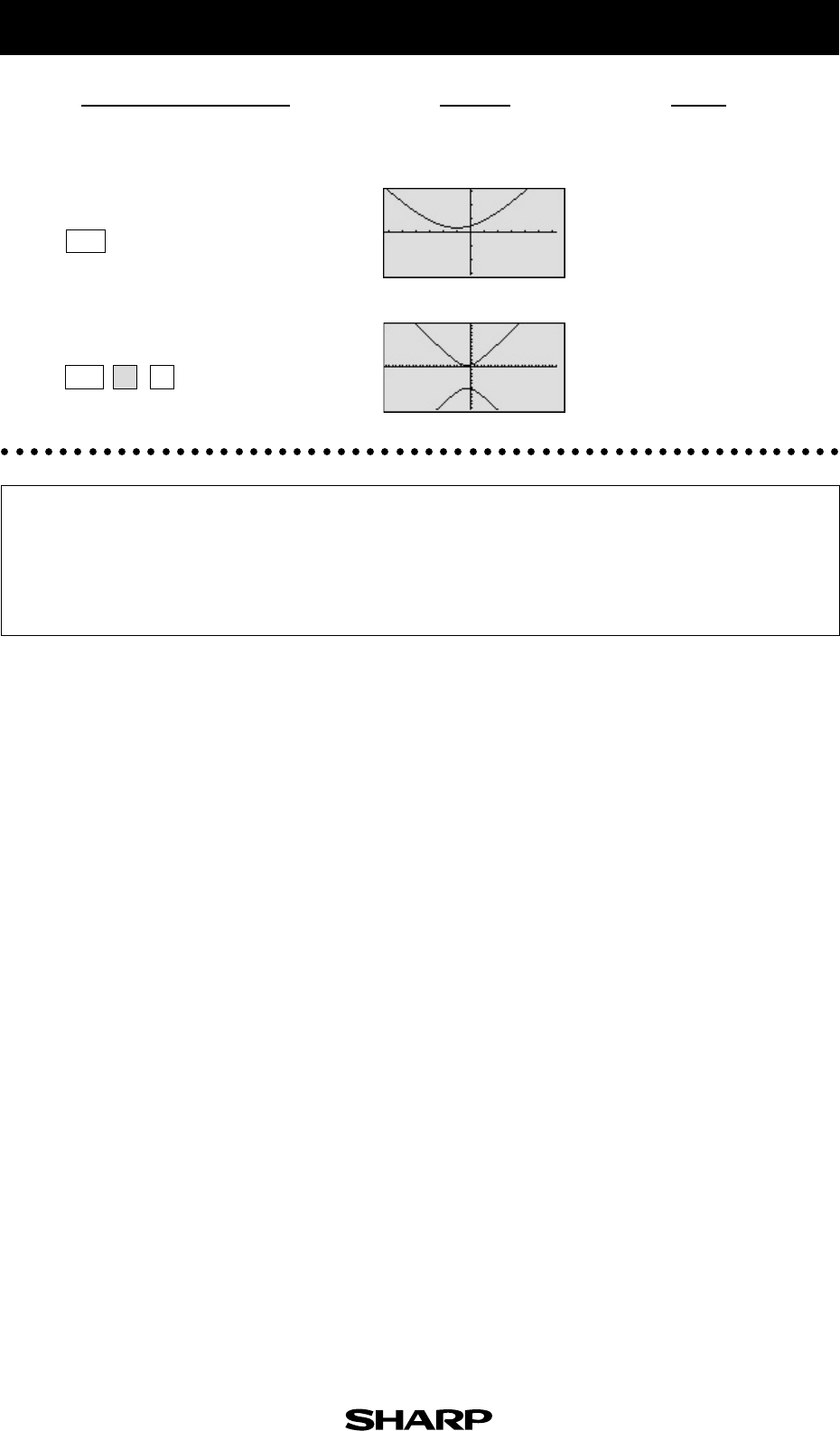
EL-9650/9600c/9450/9400 Graphing Calculator
NotesStep & Key Operation
(When using EL-9650/9600c)
*Use either pen touch or cursor to operate.
Display
(When using EL-9650/9600c)
3View the graph.
4
Zoom out the screen.
* *
Graphing hyperbolas can be performed easily on the calculator display. In
addition to the Zoom-in/Zoom-out features, the EL-9650/9600c/9450/9400 have
the Rapid Zoom feature to adjust the display easily. (See the section “Graphing
Ellipses (No. 10-3)” about how to use the Rapid Zoom feature.)
10-4
GRAPH
A
ZOOM
4
vol.18.4̲10.4.layout.p65 02.10.28, 1:16 PMPage 17 AdobePageMaker6.5J/PPC
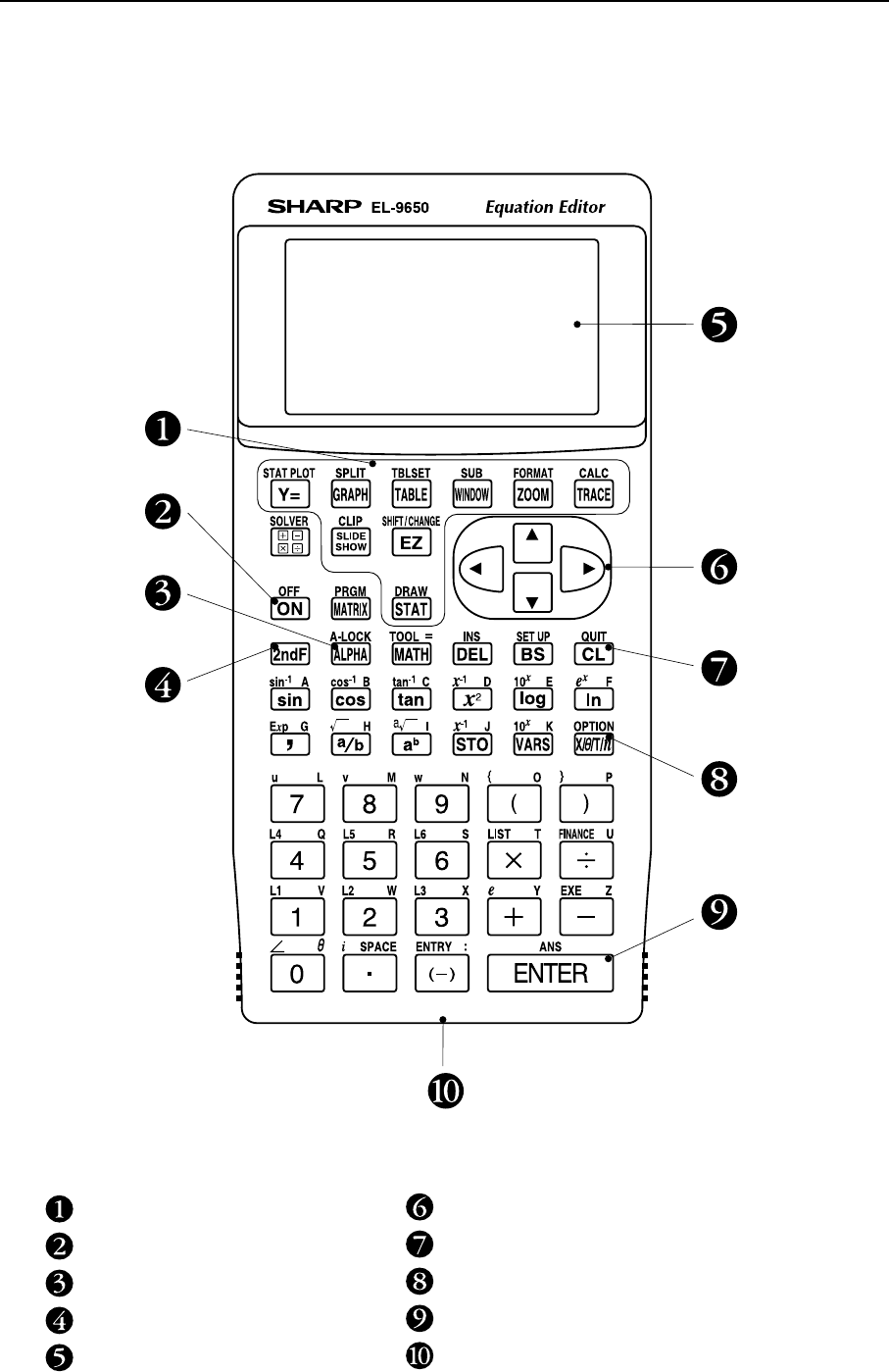
Graphing keys
Power supply ON/OFF key
Alphabet specification key
Secondary function specification key
Display screen
Cursor movement keys
Clear/Quit key
Variable enter key
Calculation execute key
Communication port for peripheral devices
Key pad for the SHARP EL-9650/9600c Calculator
Vol.1Front.Back.layout.p65 02.10.28, 1:14 PMPage 5 AdobePageMaker6.5J/PPC
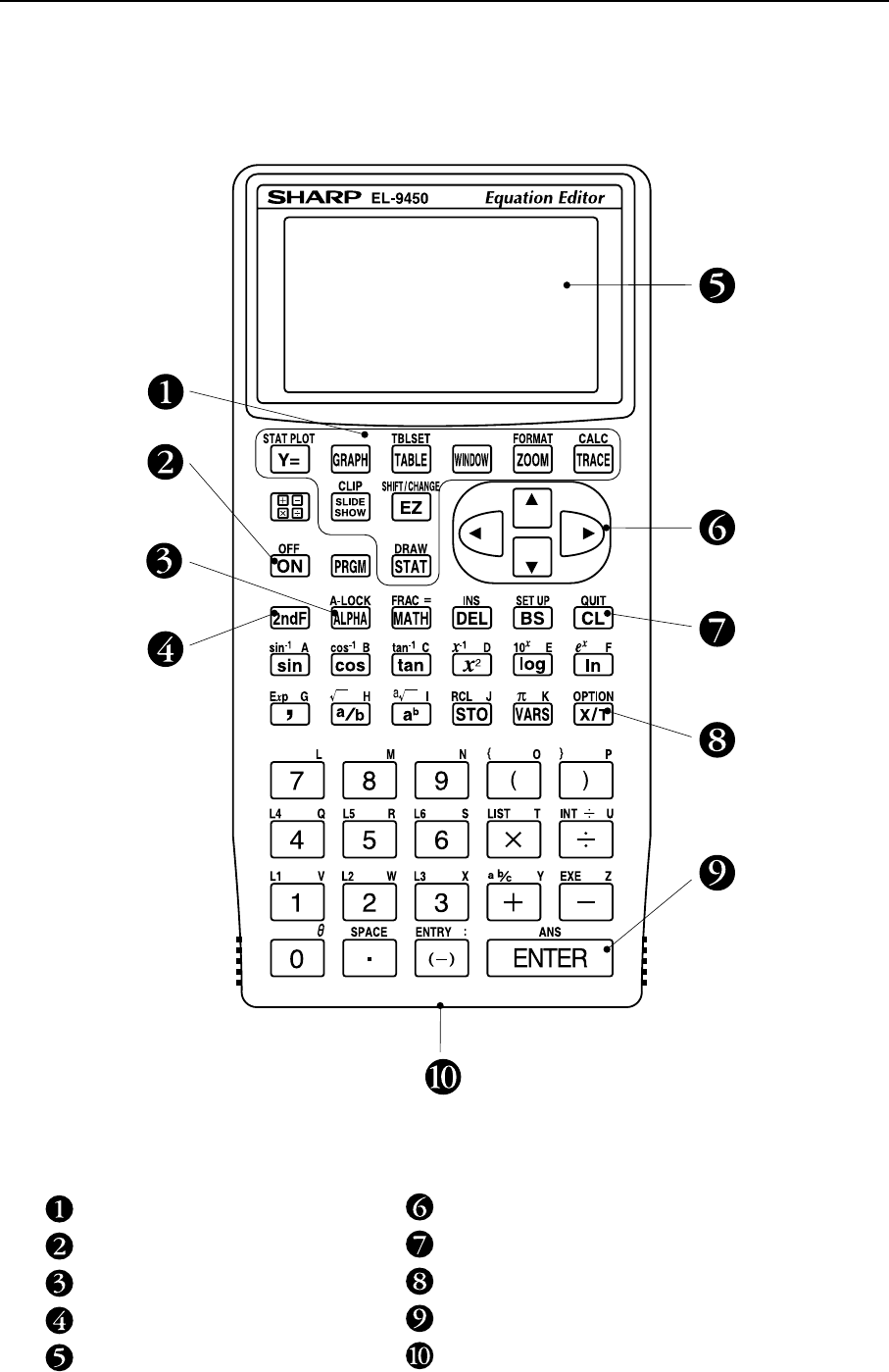
Graphing keys
Power supply ON/OFF key
Alphabet specification key
Secondary function specification key
Display screen
Cursor movement keys
Clear/Quit key
Variable enter key
Calculation execute key
Communication port for peripheral devices
Key pad for the SHARP EL-9450/9400 Calculator
Vol.1Front.Back.layout.p65 02.10.28, 1:14 PMPage 6 AdobePageMaker6.5J/PPC
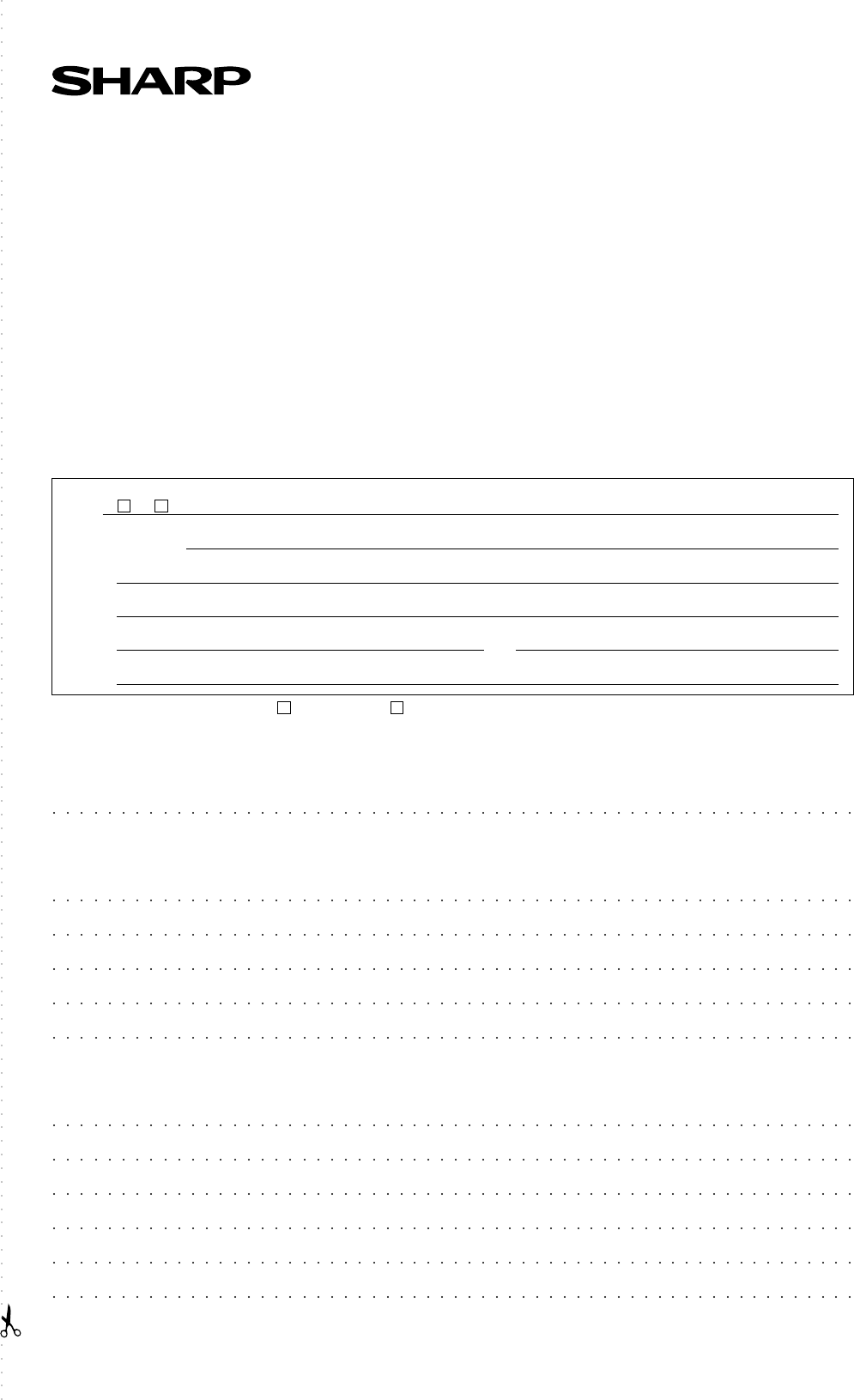
Dear Sir/Madam
We would like to take this opportunity to invite you to create a mathematical problem which can be solved
with the SHARP graphing calculator EL-9650/9600c/9450/9400. For this purpose, we would be grateful if
you would complete the form below and return it to us by fax or mail, specifying which calculator you are
writing problems for, the EL-9650/9600c or 9450/9400.
If your contribution is chosen, your name will be included in the next edition of The EL-9650/9600c/9450/
9400 Graphing Calculator Handbook. We regret that we are unable to return contributions.
We thank you for your cooperation in this project.
Name: ( Mr. Ms. )
School/College/Univ.:
Address:
Post Code: Country:
Phone: Fax:
E-mail:
* You are making this sheet for the ( EL-9650/9600c, EL-9450/9400).
SUBJECT : Write a title or the subject you are writing about.
INTRODUCTION : Write an explanation about the subject.
EXAMPLE : Write example problems.
Use this form to send us your contribution
SHARP Graphing Calculator
Vol.1Insert.layout.p65 02.10.28, 1:14 PM1

SHARP CORPORATION Osaka, Japan
Fax:
BEFORE STARTING : Write any conditions to be set up before solving the problems.
STEP NOTES
SHARP Graphing Calculator
Vol.1Insert.layout.p65 02.10.28, 1:14 PM2

SHARP CORPORATION OSAKA, JAPAN
Vol.1Front.Back.layout.p65 02.10.28, 1:14 PMPage 7 AdobePageMaker6.5J/PPC